Wondering what to eat in Italy? Discover 75 Italian food favorites to eat from the top of the boot to the bottom. We’ve included pizzas and pastas plus a few Italian dishes that may be new to you.
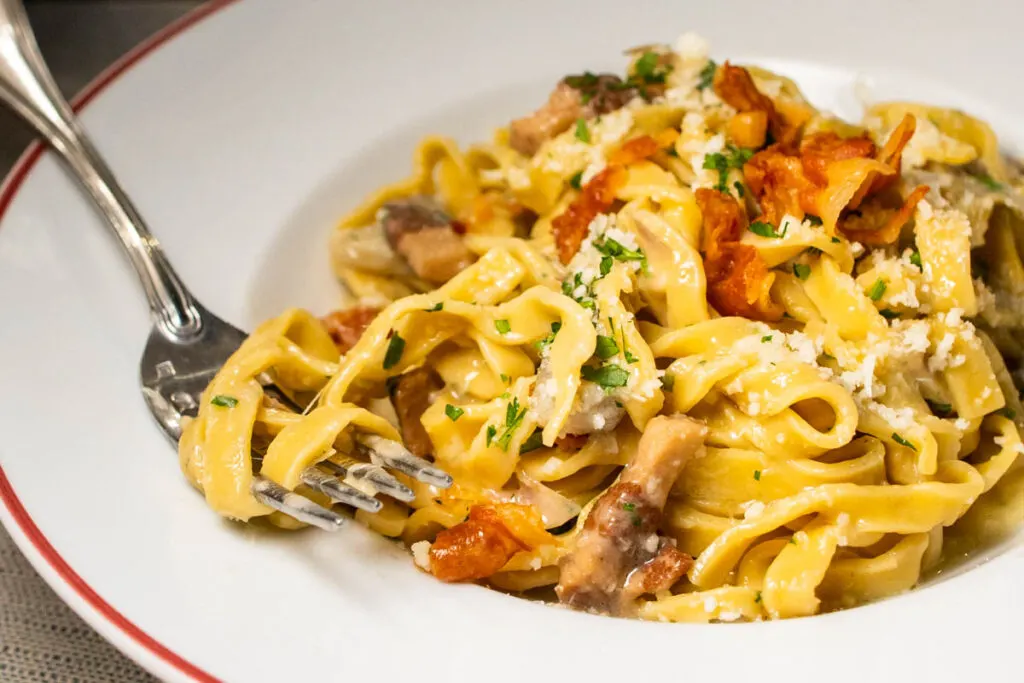
Travelers visit Italy, a food lover’s paradise, with high culinary expectations.
There’s hardly a place in the boot that doesn’t have a plethora of pizza shops and Italian restaurants. Most of these eateries are pretty good, or at least half way decent. But, not every Italy food trip is a success.
We’ve heard more than our sad share of stories from travelers who didn’t have great Italy food experiences. Some of these disappointed diners relied on tour guides and concierges for restaurant recommendations. Others failed to do advance research or neglected to make necessary reservations.
Learn our top tips for eating in Italy like a pro instead of a shmo.
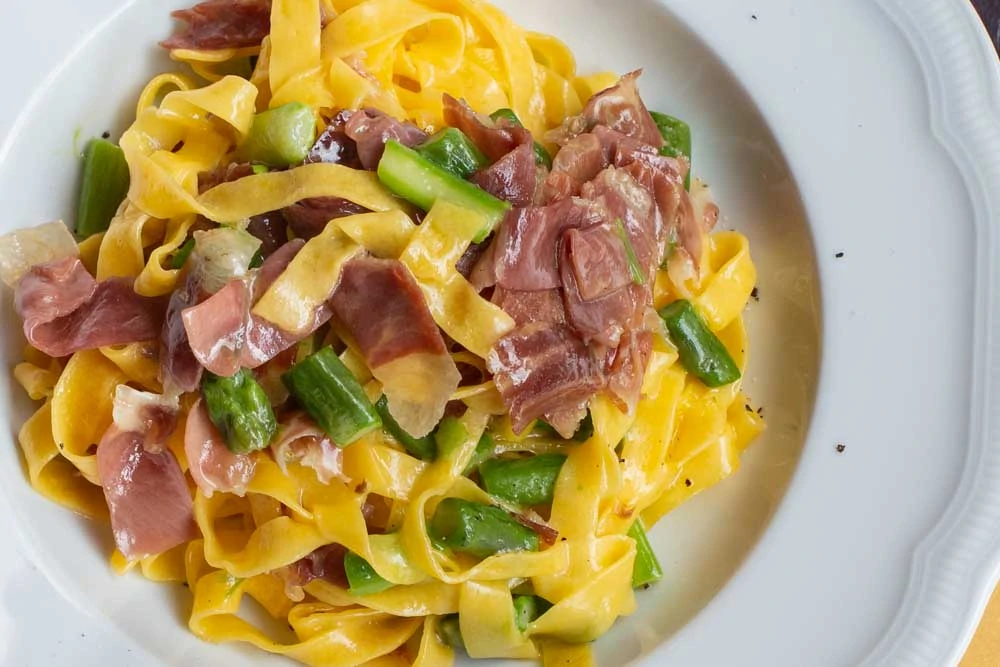
We’ve visited Italy dozens of times, eating amazing food from Trentino in the north all the way to Matera in the south. We’ve also sipped wine in Sicily and eaten our weight in pizza in Naples. And guess what? We can’t wait to return again, both to personal favorite Italian food cities like Rome and Naples and new-to-us Italian destinations like Milan and Palermo.
With this in mind, we’re sharing our favorite Italian foods, plus a few drinks, that we adore eating and drinking in Italy. These are the items we can’t wait to eat again at the home of the Renaissance, Galileo … and pizza.
A Brief History of Food in Italy
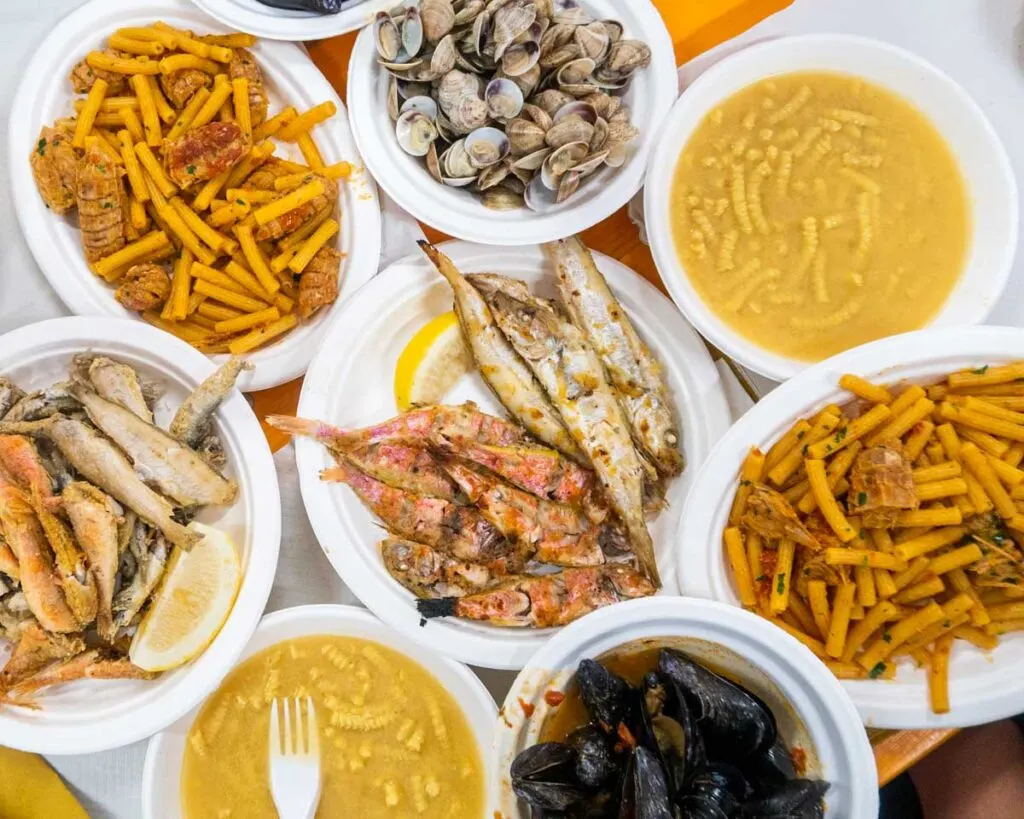
Italy’s long and circuitous history dates well before its 20+ regions merged to become the country that we know and love today. This history includes empires and emperors as well as conquerors and concubines. It also includes a culinary trail that began before pizza ovens and meat slicers made life easier.
While Italy’s ancient residents ate plenty of proteins and produce, they didn’t have access to tomatoes. Tomatoes, like a myriad of popular modern-day Italian ingredients, wouldn’t arrive in Italy until around the 15th century and wouldn’t become popular until the 1800s.
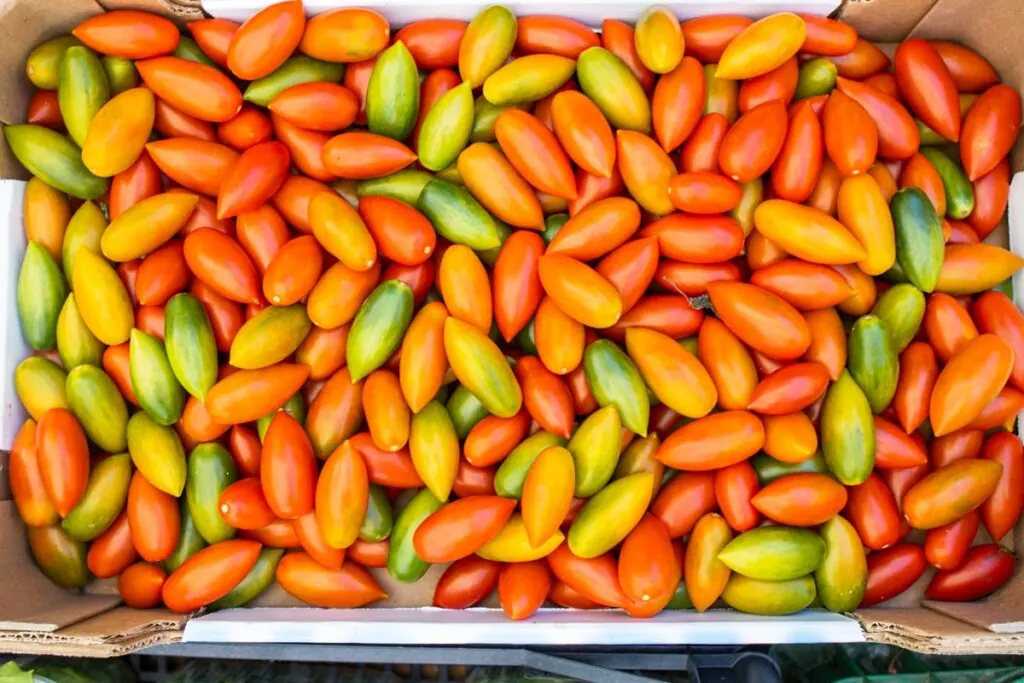
Some ingredients, like honey and garlic, arrived via the Spice Road while iconic Italian ingredients like tomatoes, peppers, chocolate and coffee were ‘discovered’ in the Americas. Arabs brought almonds to Sicily and may have introduced noodles. And then there are French and Austrian chefs who influenced many of the country’s best dishes and desserts.
Modern Italian cuisine didn’t develop overnight or in one place. It’s the sum of Italy’s 20 parts (i.e. regions) and continues to evolve with the times. Italian food never bores us and we always find new things to sample since food is one of Italy’s greatest treasures.
What to Eat in Italy
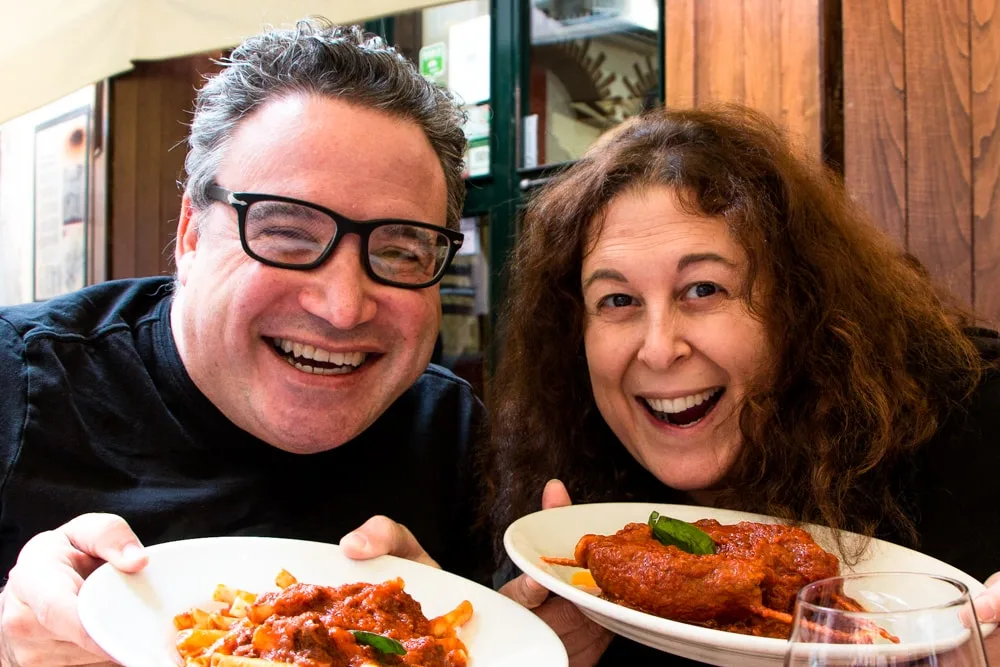
Although we’ve eaten hundreds of dishes in Italy and almost as many desserts, we decided to keep our list of must-eat Italian foods at a manageable limit of 75 entries. And, for ease of use, we’ve grouped all of the entries into the following categories:
Italian First Course Dishes (Primi)
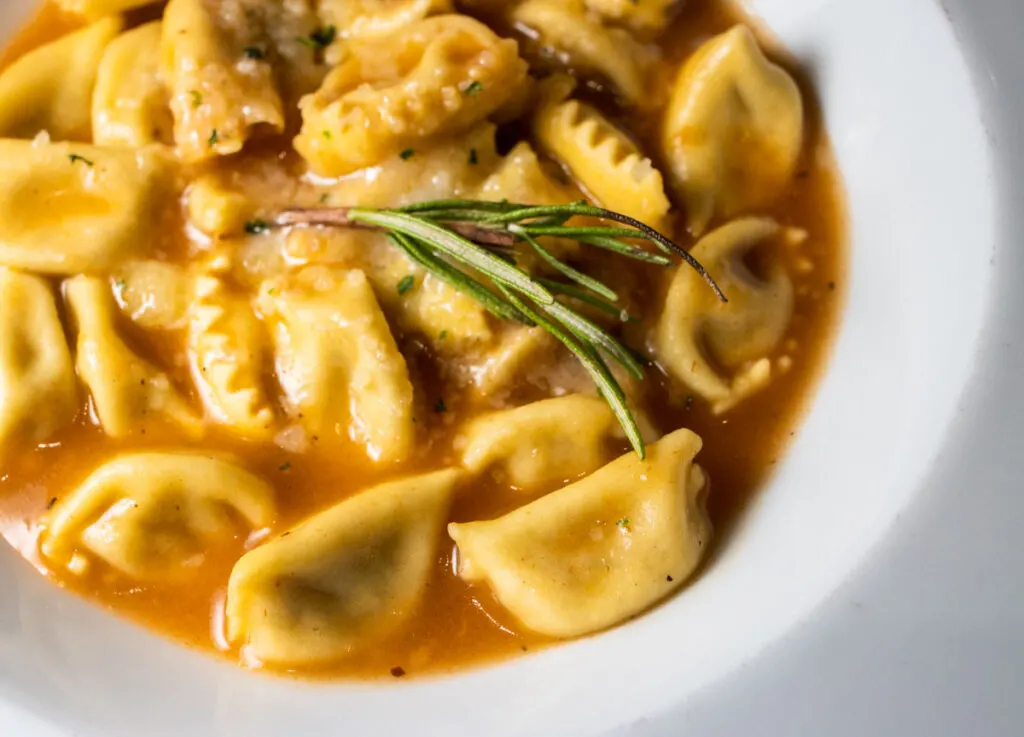
Primi aren’t just random dishes that start an Italian meal – they include famous Italian pasta dishes as well as soups and risotto. Ironically, they don’t include salad. In Italy, insalata (i.e. salad) is served as a contorno (i.e. side dish).
Since any proper Italian menu, both in Italy and around the world, starts with a primi section, this guide starts with our favorite primi dishes – nineteen of them to be exact.
Read on to discover our favorite primi dishes that you don’t want to miss in Italy:
1. Cacio E Pepe
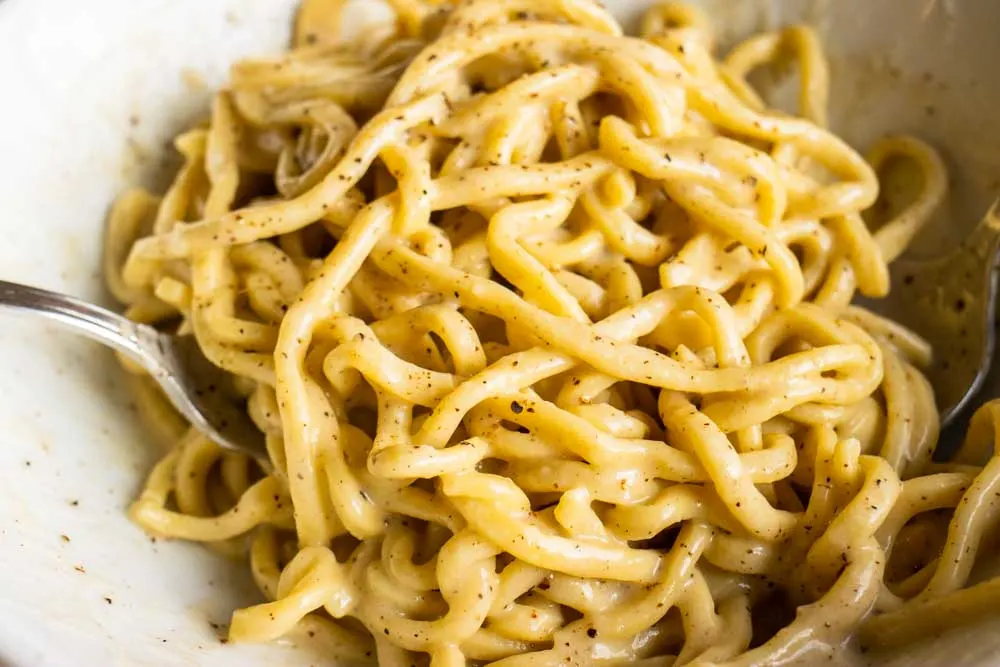
Of Rome’s four iconic pasta dishes, Cacio e Pepe is the king despite its seemingly simple recipe with just three ingredients. Beyond the two ingredients (cheese and pepper) in its name, Cacio e Pepe’s only other ingredient is pasta.
When we’re not in Italy, we prepare Cacio e Pepe at home using Pecorino Romano and pasta just like Roman cooks and families in Rome. Although the dish is simple to prepare, it’s also deceptively difficult to perfect.
Follow our Bucatini Cacio e Pepe recipe and cook Rome’s most iconic pasta dish at home.
2. Pasta Carbonara
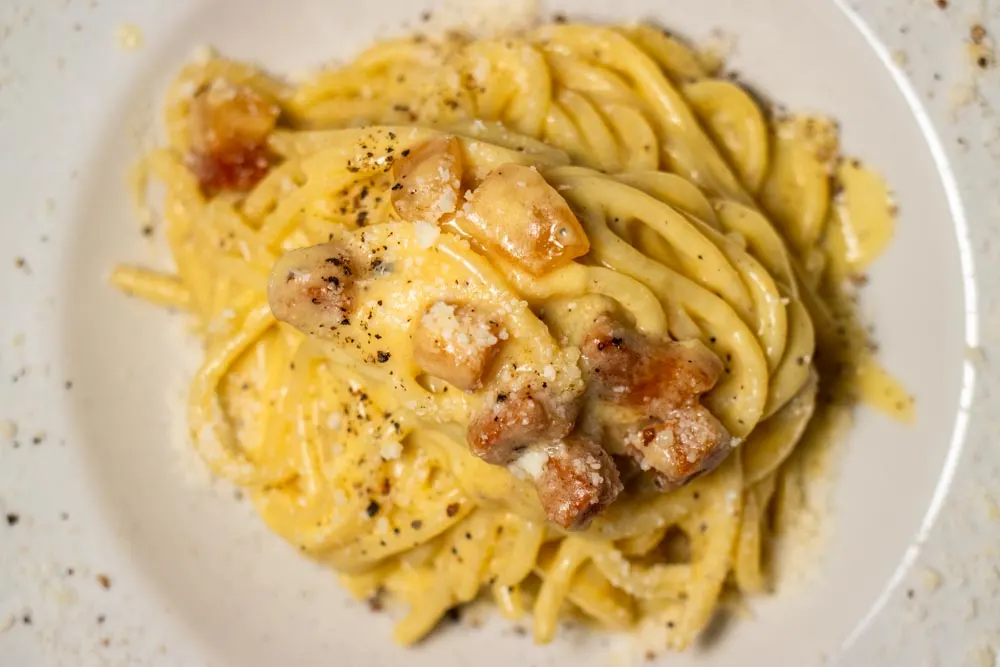
Numerous Roman dishes date back millennia to the days when the Roman empire dominated much of the world. Pasta Carbonara is not one of those dishes. Instead, this popular pasta is a 20th century invention that caught on relatively quickly.
Roman chefs prepare Carbonara sauce by combining emulsified egg yolks with guanciale (cured pork jowl), starchy pasta water and salty Pecorino Romano cheese. Served over linguine or spaghetti, the resulting sauce is creamy, rich and wonderful.
Follow our Linguine Carbonara recipe and cook the creamy Roman pasta dish at home.
3. Pasta All’Amatraciana
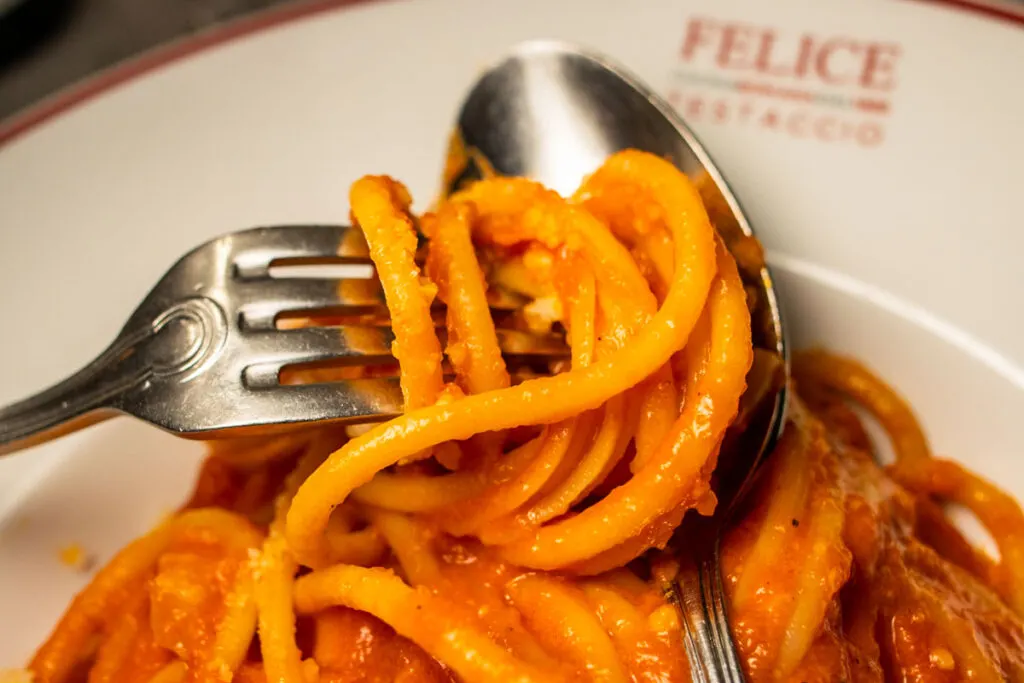
Hailing from the outer Lazio village of Amatrice east of Rome, Pasta Amatriciana unites tomatoes with guanciale. It’s also the answer to how to take something good – Pasta alla Gricia (see below) – and make it better.
A great Amatriciana sauce is all about flavor. In this dish, rich, umami-filled, gamey, slightly caramelized pork fat receives a sweet, acidic kick from tomato sauce and (occasionally) onions.
After eating great Amatriciana at Salumeria Roscioli, Piatto Romano and Felice a Testaccio in Rome, we cooked the classic Roman pasta in our kitchen. If we had to choose a favorite version, we’d choose all of them.
Follow our Rigatoni all’Amatraciana recipe and cook the classic Roman pasta dish at home.
4. Pasta alla Gricia
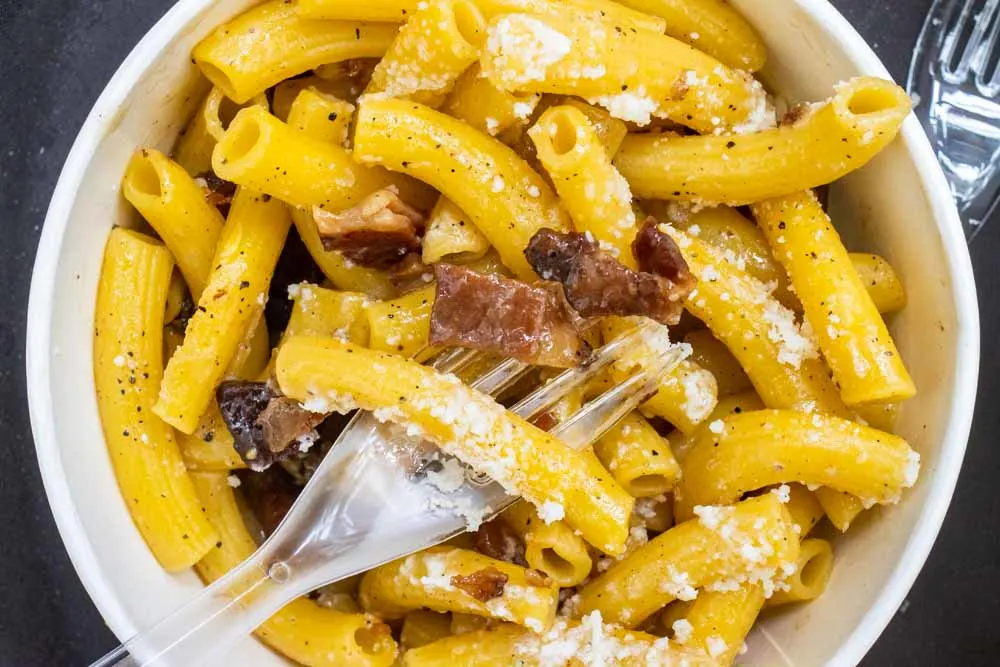
Gricia first made its appearance in the Roman pasta ouvre in the 1300s, centuries before tomatoes arrived in Italy. There are no onions in Gricia, no garlic and, obviously, no tomatoes.
Gricia is just guanciale, pepper and pasta. Yes, it’s topped with grated Pecorino Romano, but the cheese, unlike in Cacio e Pepe (see above), is a last minute finish to the dish as opposed to a key ingredient.
In Gricia, starchy, salty pasta water combines with the rendered pork fat to create a saucy emulsion. Its simple medley of flavors is the pasta equivalent of a bacon sandwich. The pasta and the pork have to be top quality. Fortunately there’s plenty of great pasta and pork in Rome.
Follow our Pasta alla Gricia recipe and cook this ancient Roman pasta dish at home.
5. Pasta alla Genovese
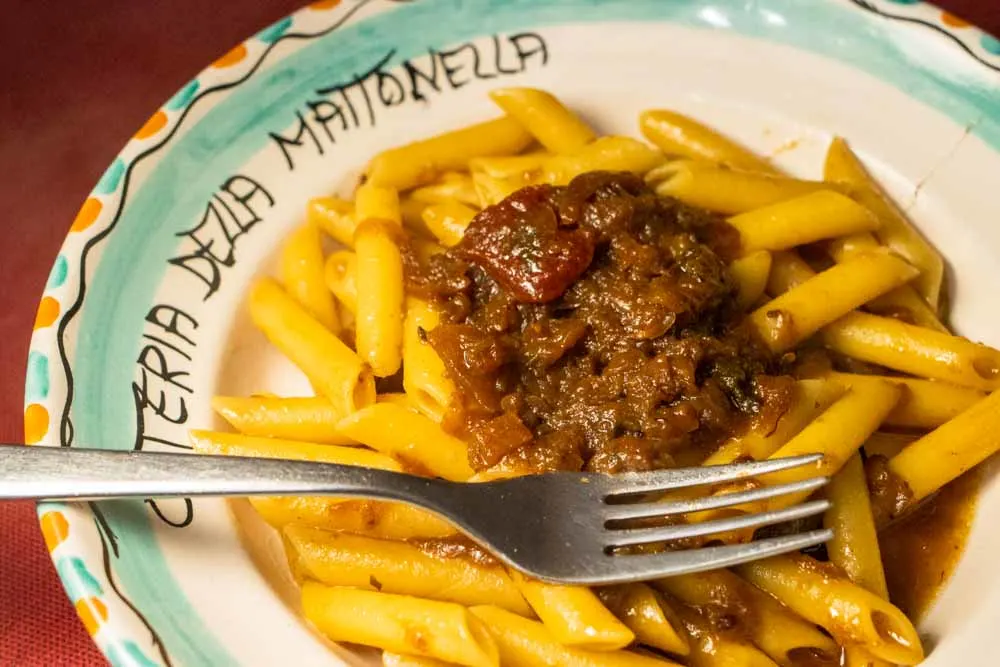
Pasta Genovese is an Italian pasta dish with a twist. While the name implies a Genoa origin in the northwestern region of Liguria, the dish actually hails from Naples in Italy’s southern Campania region. Regardless of where it was invented centuries ago, Pasta Genovese is an Italian pasta worth eating today.
Neapolitan chefs simmer meat with white wine and a sauce that includes A LOT of onions to make Pasta Genovese. Cooked low and slow, melted onions give the sauce a richness best paired with paccheri (smooth, tubular pasta) or similarly shaped noodles.
Follow our Pasta Genovese recipe and cook Naples’ favorite pasta dish at home.
6. Pasta Puttanesca
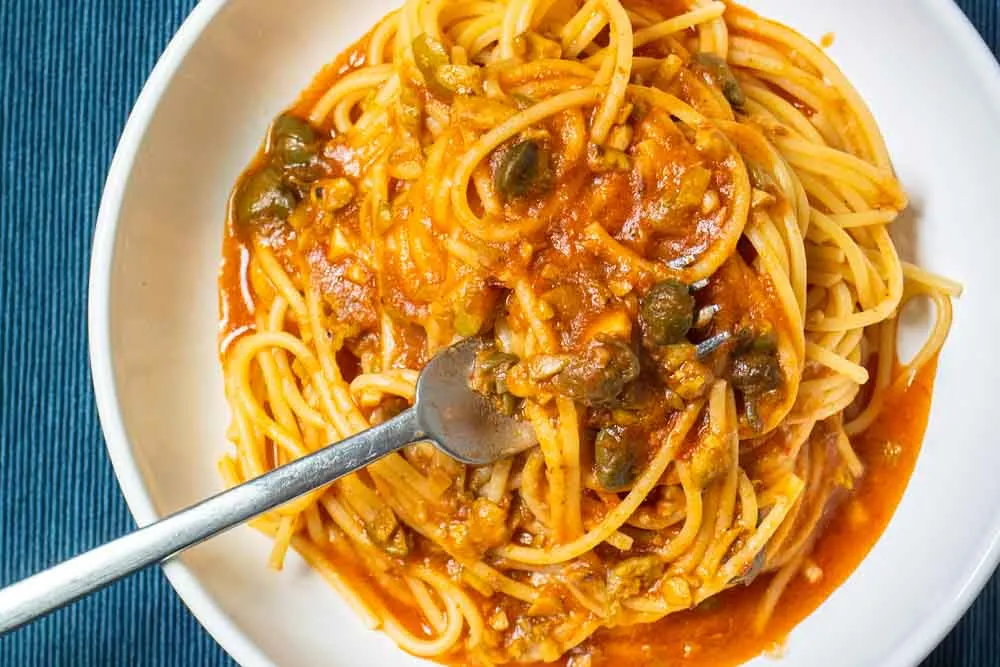
Many of the best Italian pasta dishes don’t have clear origin stories. This is the case with the four great pastas in Rome (see above) and it’s also the case with Puttanesca. Sure, there are some legends about Naples, prostitutes and a restaurant owner who was desperate to feed a few people with ingredients he had on hand, but nobody knows its origin story for sure.
In simple terms, Pasta Puttanesca is a Neapolitan pasta dish made with anchovies, capers, garlic, olive oil and tomatoes. However, despite or perhaps due to its inauspicious start, punchy Puttanesca is a dish born from poverty that tastes like a million bucks.
Follow our Spaghetti alla Puttanesca and cook the spicy Neapolitan pasta dish at home.
7. Spaghetti alle Vongole
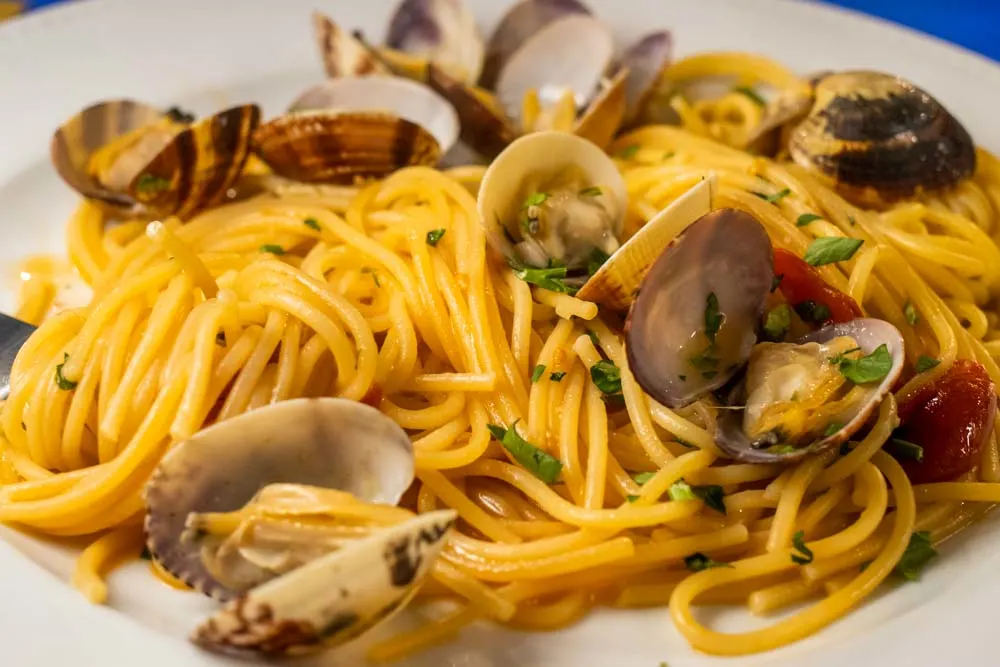
Althgough Spaghetti alle Vongole was invented in Naples, the simple dish that pairs spaghetti with clams is available throughout Italy. We’ve eaten the dish in its Neapolitan home in the south as well as in canal-filled Venice in the north.
Regardless of where you eat Spaghetti alle Vongole in Italy, you can expect to eat spaghetti and clams as advertised in the dish’s name. Other typical ingredients include garlic, olive oil and white wine. Some Vongole recipes add tomatoes as well, though you’ll see this more in Southern Italy than in the rest of Italy.
Italy isn’t the only country to make great noodle dishes. Discover our picks for the best noodle dishes around the world.
8. Gnocchi alla Sorrentina
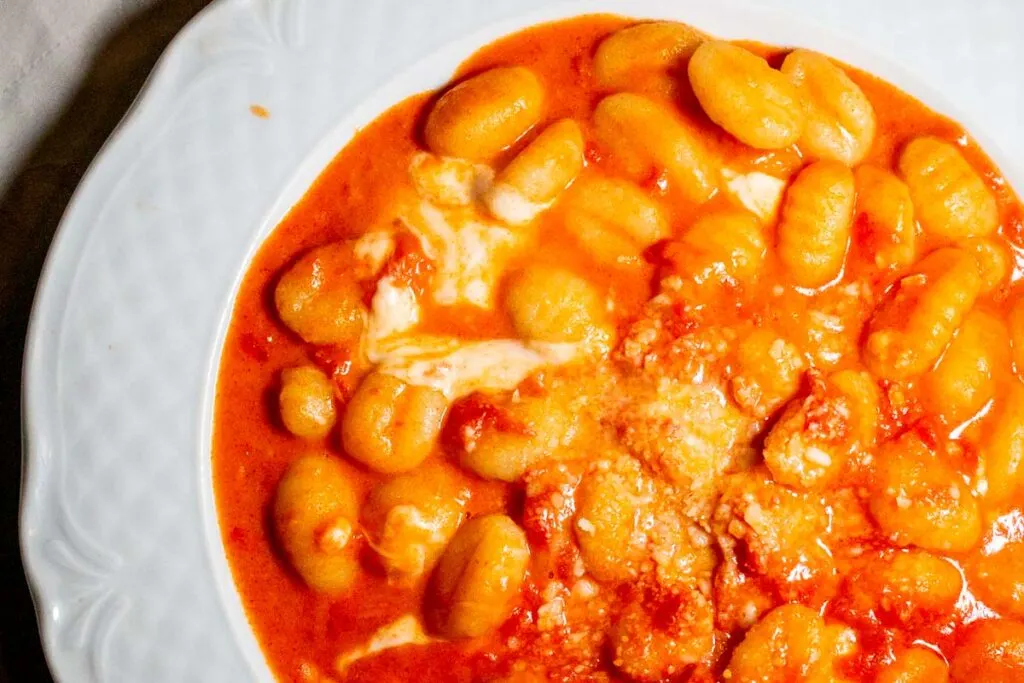
Gnocchi alla Sorrentina is a popular Italian pasta with roots in Sorrento, a charming seaside town located just 30 miles from Naples. While some people travel to Sorrento to see the town’s sweeping views and others want to sip limoncello at the source, we were most excited to eat Gnocchi alla Sorrentina, Sorrento’s signature dish.
This dish is made with potato gnocchi, Italian pillow-like potato dumplings. Additional ingredients like tomatoes, and mozzarella cheese prove that this saucy primi is pure Italian at its core.
9. Lasagne Verdi al Forno
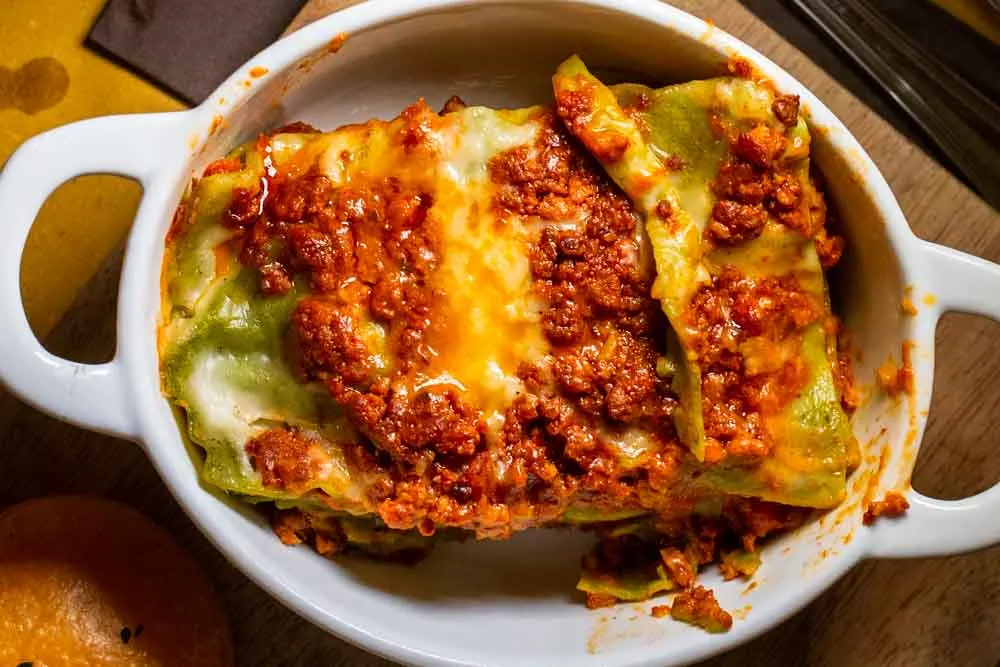
Lasagna is an Italian dish that dates back centuries. Although food historians trace the layered pasta dish back to Naples in the Middle Ages, it’s popularity spread throughout Italy up to the Food Valley in Emilia-Romagna and beyond. (Technically, lasagna refers to the large flat noodles used in the dish.)
Learn more about Italy’s food valley.
The Emilia-Romagna version with layers of sheet noodles, ragù and Béchamel sauce is a little different from the lasagna of our youth. (That Lasagna had ricotta and ground meat. You’ll find something similar to it in Southern Italy.) However, we can’t get enough of Bologna’s Lasagne Verdi al Forno with its colorful layers of green spinach noodles, ragù, Béchamel sauce and Parmigiano-Reggiano.
10. Tagliatelle al Ragù
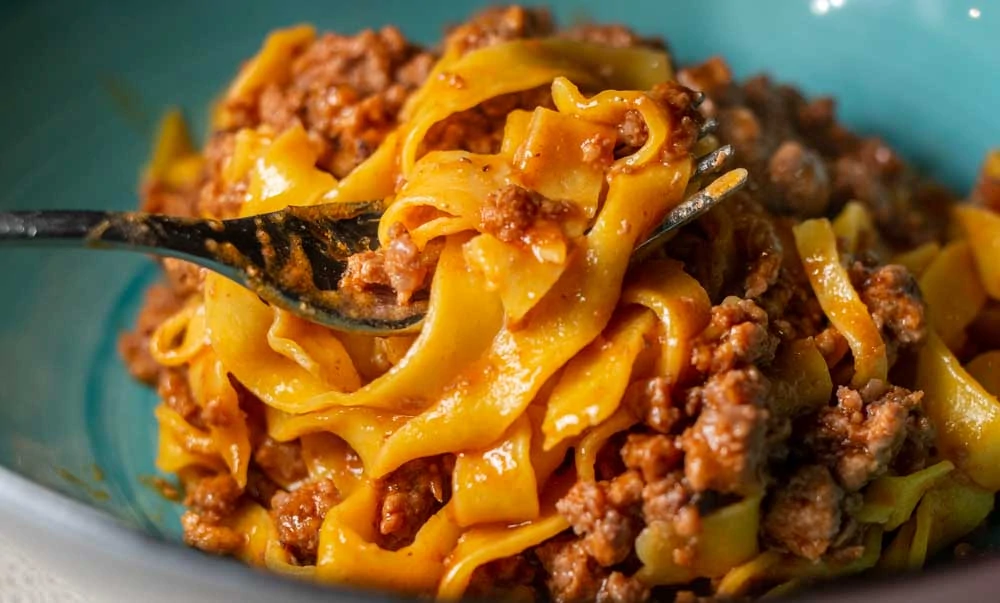
Tagliatelle al Ragù is the shining pasta star of Bologna, a city so food-focused that it earned the nickname La Grassa (the fat one) within Italy. Many have copied this noodle dish but there’s nothing like eating a plate of Tagliatelle al Ragù at the source.
Dating back to the 1700s, classic ragù includes a range of ingredients that starts with a soffrito (a mirepoix of celery, onions and carrots), a small amount of tomato (ironically not the dominant ingredient in Bolognese ragù), olive oil, milk, ground meat (beef, pork and veal), white wine and occasionally nutmeg. That being said, not all bolognese ragùs are exactly the same since all Emilian cooks adds special, personal touches to their ragù.
Bologna is one of the world’s greatest food cities. Discover more culinary gems including two more in Italy.
11. Tortellini in Brodo
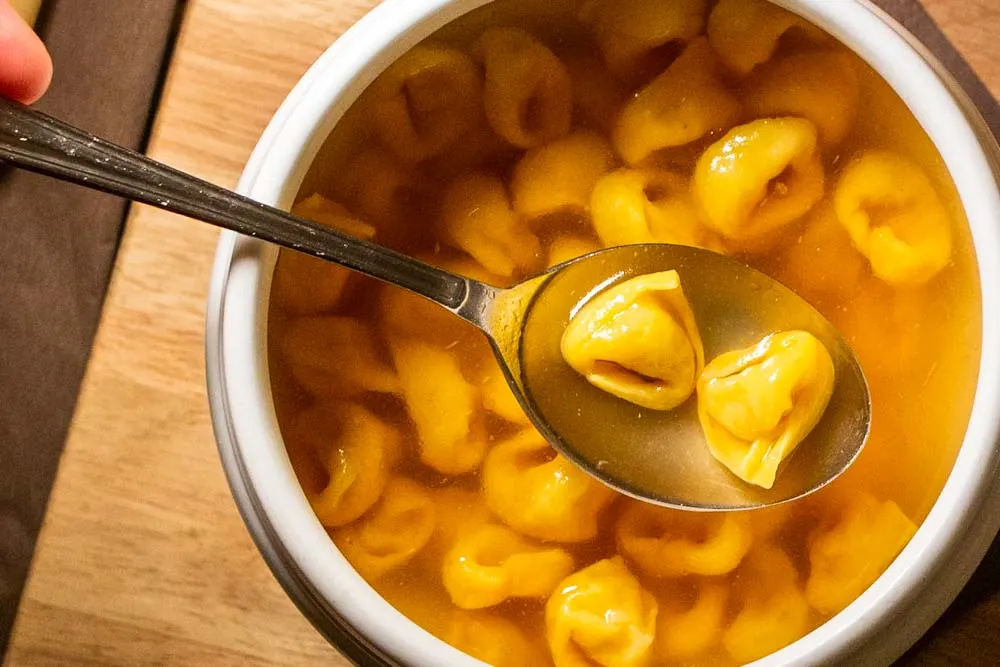
Simply described as tortellini swimming in a bowl of capon broth, Tortellini in Brodo is that and so much more. It’s the first dish we seek when we return to Emilia-Romagna. The brodo (i.e. broth) can vary between beef and poultry or include both.
Tortellini in Brodo is Italy’s version of comforting chicken noodle soup with its small handmade pasta dumplings filled with a special blend of prosciutto, parmigiano and mortadella. A sprinkling of Parmigiano-Reggiano on top of the soup makes the dish taste even better but it’s pretty darn good on its own.
Discover more great soups to eat around the world.
12. Orecchiette alle Cime di Rapa
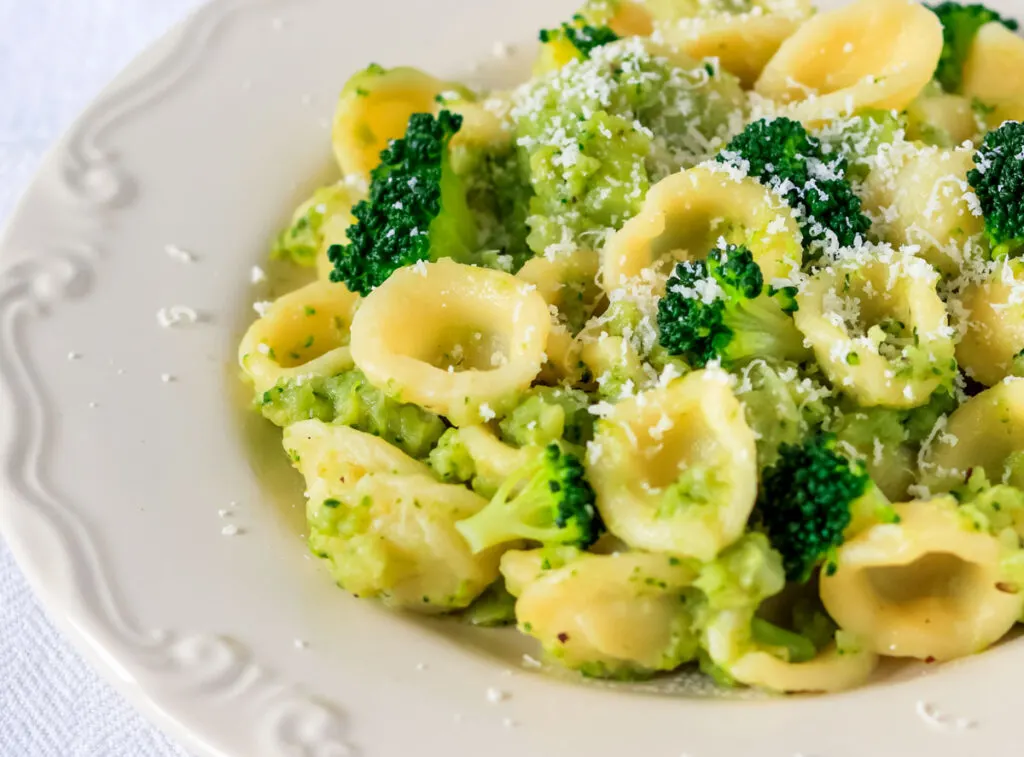
Although we’ve eaten orechiette pasta dishes in Basilicata’s Matera, there’s no debate that the small ear-shaped noodle is a Puglian pasta. And, while orechiette is versatile enough to eat with tomato sauce, that’s not the most classic way they serve it in in Puglia.
Orecchiette alle Cime di Rapa, which literally translates to orecchiette with turnip tops, pairs Puglia’s signature pasta with either turnip tops or broccoli. It’s a great vegetarian dish and meat eaters like it too.
See how you can to eat your way around Puglia in a day.
13. Ravioli
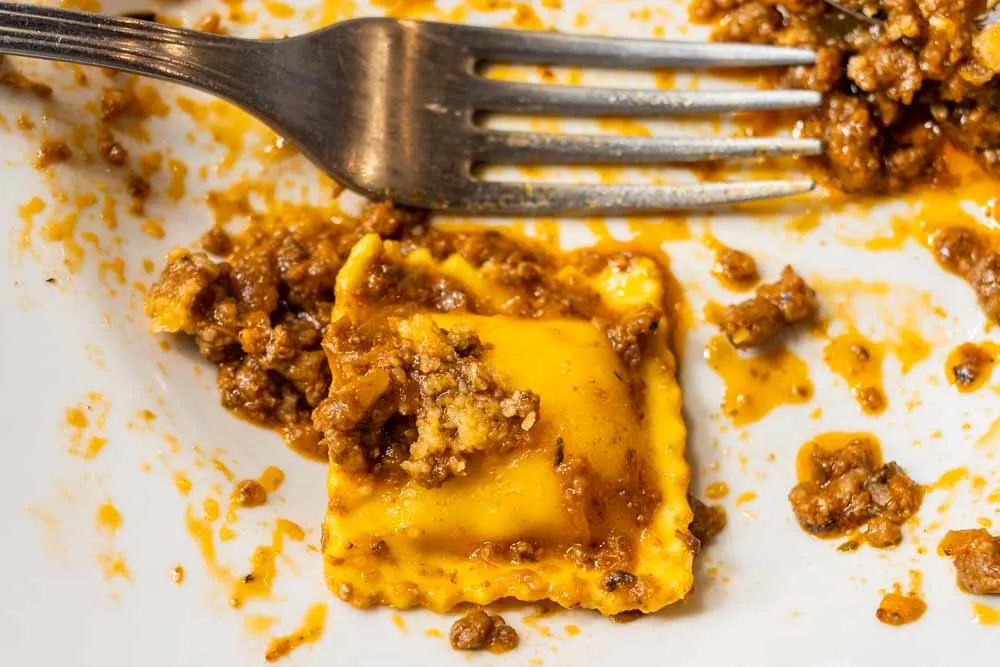
Not all noodle dishes from Italy look and taste alike and such is the case with ravioli. Typically but not always square in shape, ravioli fillings run the gamut from brown butter and sage to mortadella and even pumpkin depending on the season and region.
Italy isn’t the only country that puts ravioli on the menu. We’ve eaten versions in diverse destinations including Tokyo, Dublin, Buffalo and Paris. However, our favorite ravioli dishes have been in Italian cities like Bologna and Florence.
14. Ravioli Gnudi alla Fiorentina
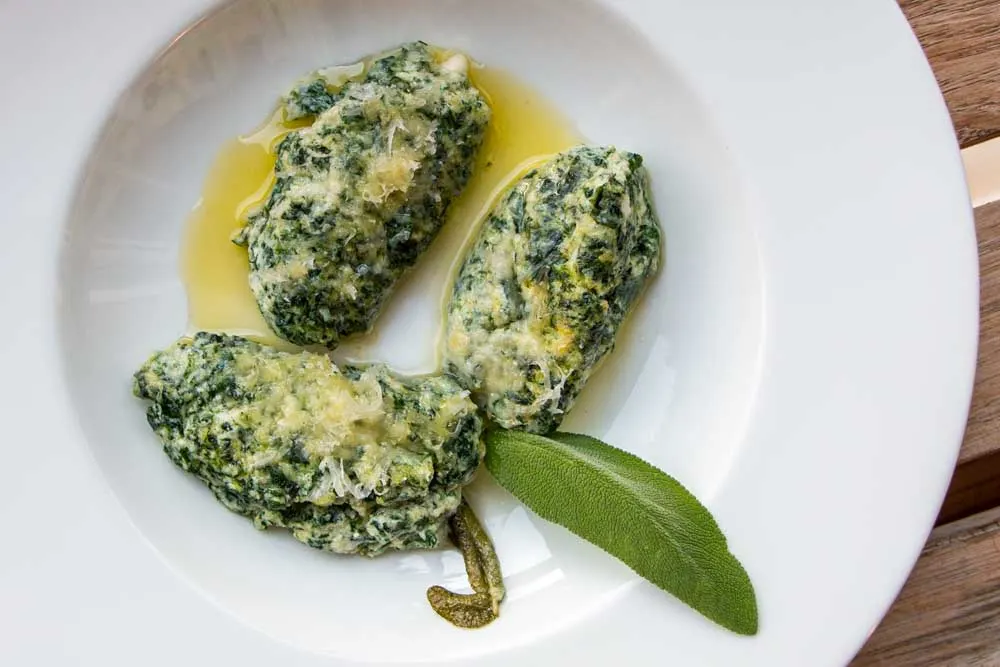
Gnudi are Tuscan gnocchi made with spinach and ricotta. The name refers to the fact that gnudi dumplings resemble the inside of a ravioi without the outer shell. The word gnudi loosely translates to naked. | Image: ©2foodtrippers
We first encountered gnudi during a Cesarina home cooking experience we did back in 2018. Between sips of wine and various nibbles, we learned how to cook the naked ravioli from scratch before eating them smothered with sage butter sauce. We also learned that gnudi originated in Sienna less than 50 miles from Florence.
Discover what else we learned and ate during two Cesarina experiences.
15. Ribolita
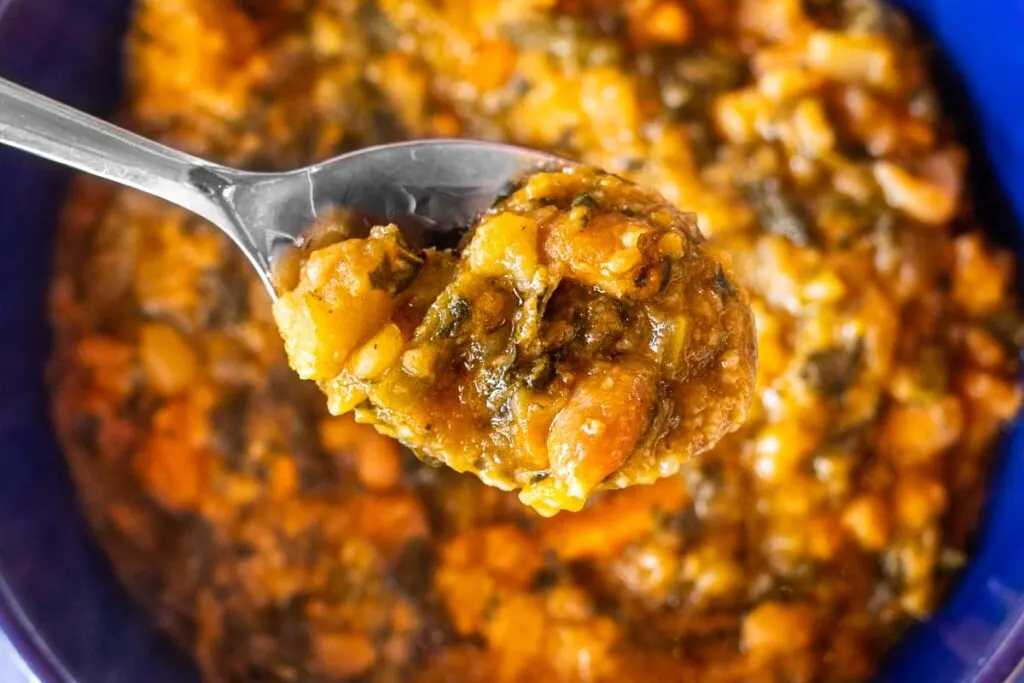
When Italians refer to Tuscans as mangiafagioli or bean-eaters, it’s not exactly a compliment. Back in the day, they typically applied the nickname to poor peasants of Tuscany who soaked beans overnight next to a fire and then mixed the soaked beans with scraps of old bread. Vegetables from the garden turned the mixture into Ribollita, an excellent example of what we now call ‘cucina povera’ (i.e. poor kitchen).
Fast forward to the present and Ribollita has grown from its humble beginnings to become a primi fixture on restaurant menus in wealthy cities like Florence and Sienna. Yes, along with Bistecca Fiorentina (see below) and various meat and game dishes, humble Ribollita represents the greatness of Tuscan food despite, or maybe because of, its poor origins.
Discover more great food in Florence.
16. Pappa al Pomodoro
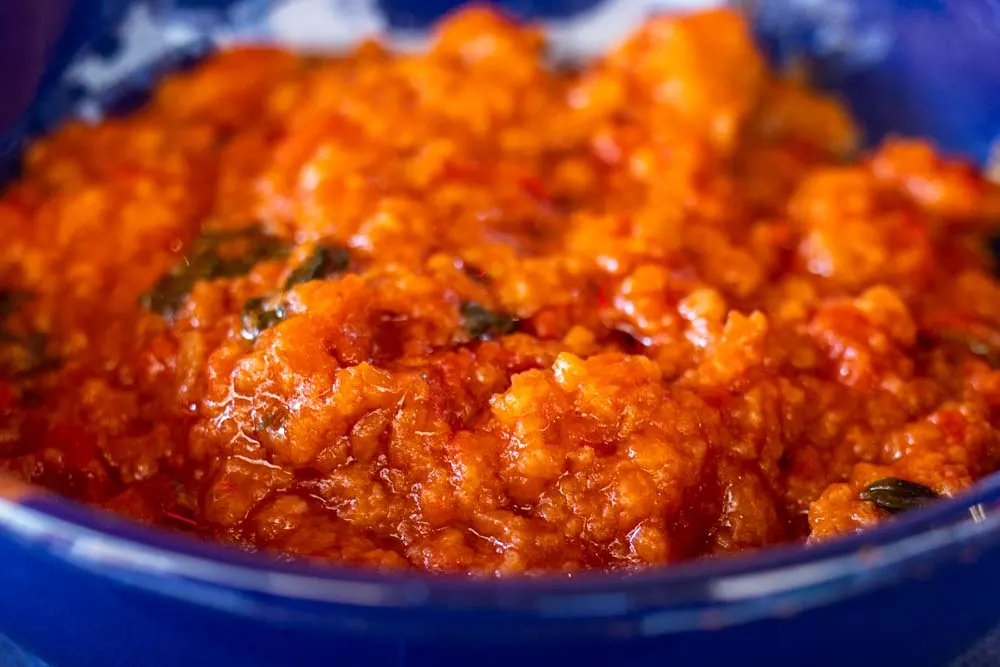
Nothing speaks to Italian culinary simplicity like Pappa al Pomodoro, a blend of bread and cooked tomatoes that some consider to be a vegetarian stew instead of a soup. We emphasize with the confusion since the texture of this traditional Italian food favorite is closer to mushy baby food than it is to consummé.
But don’t blame this soup/stew for having a thick texture. Instead, embrace the tastiness that comes from combining ingredients like Tuscan bread, tomatoes, basil, garlic and olive oil. We’ve eaten various versions at restaurants around Florence and each one has made us happy in its own tangy, mushy way.
Follow our Pappa al Pomodoro recipe and cook the iconic Florentine dish at home.
17. Risotto Milanese
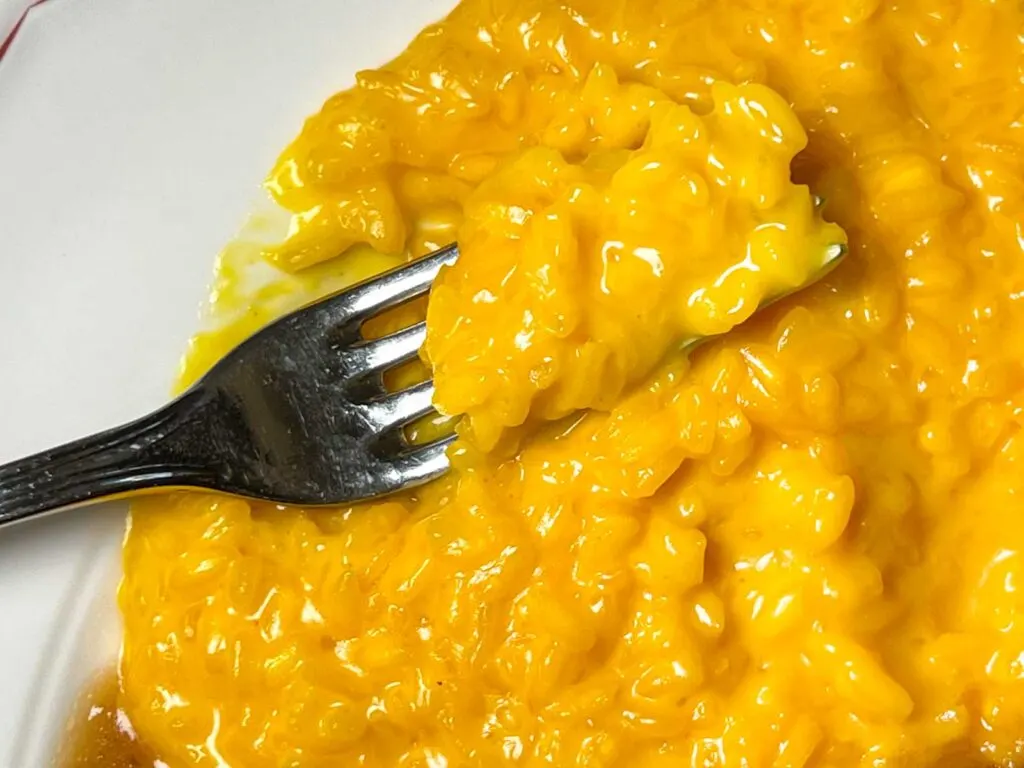
Risotto Milanese’s origin stories may involve yellow stained glass church windows but this dish’s history isn’t so definitive. Originally imported from Asia, rice was adapted by Italian nobility, like Milan’s Sforzas, to grow in the region’s fertile Po Valley. Risotto Milanese developed its flavor and creamy texture over time.
Milan’s famous risotto is typically served as a side dish with Ossobucco (see below), providing a rich yellow, starchy complement to the region’s famously bone-centered braised dish. How saffron ended up in this rice dish is anyone’s guess. While we don’t think it was added by glassmakers, bright yellow saffron was certainly an ostentatious addition that served, and still serves, as a symbol of the city’s wealth and prosperity.
18. Risotto alla Amarone
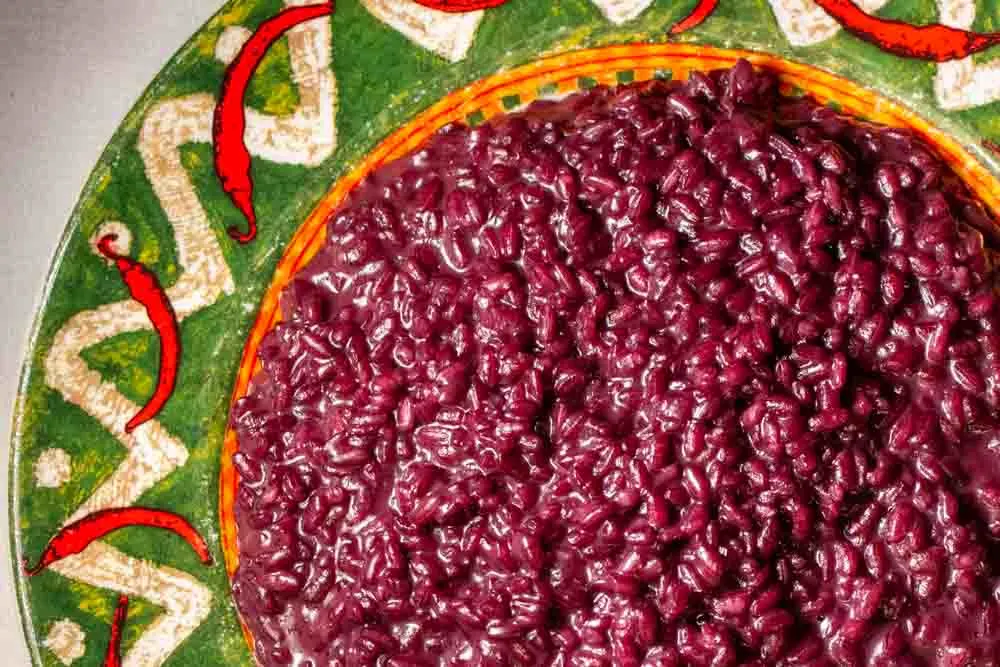
Verona’s Risotto all’Amarone doesn’t look like any other Italian dish due to its deep purple hue. However, despite or because of its color, this purple primi is suitable for royalty as well as food travelers who want to eat royally.
To make Risotto all’Amarone, cooks marry Amarone, the Veneto’s powerhouse wine, with Vialone Nano rice, a type of medium grain rice specific to the region. They then add creamy Parmigiano-Reggiano cheese to the dish’s umami-rich base of mixed meat stock or brodo. The decadently rich result is otherworldly.
Discover more great food in Verona.
Pizza
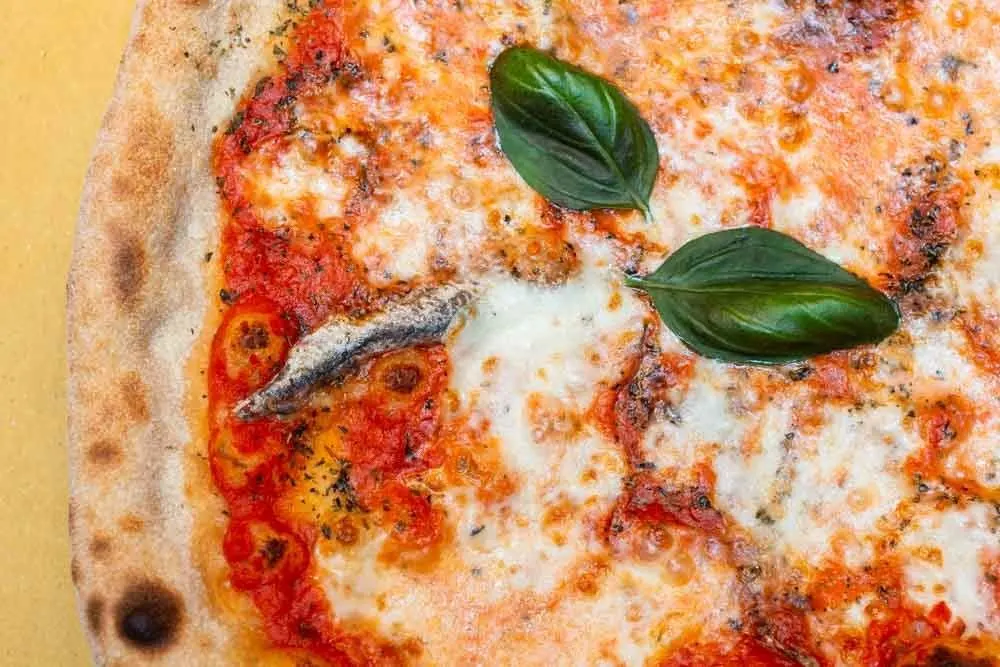
Pizza is pizza. Right? Wrong!
There are more pizza versions and varieties than we can count on our fingers and toes. Even America, where we grew up eating pizza that arrived in boxes, has different styles that include New York slices, Chicago deep dish, rectangular Detroit pies and Buffalo pizza topped with cup-and-char pepperoni.
However, Italy holds a unique place in the modern world pizza scene. Italy, like NYC, is a pizza epicenter, a culinary ground zero where locals take their pies seriously.
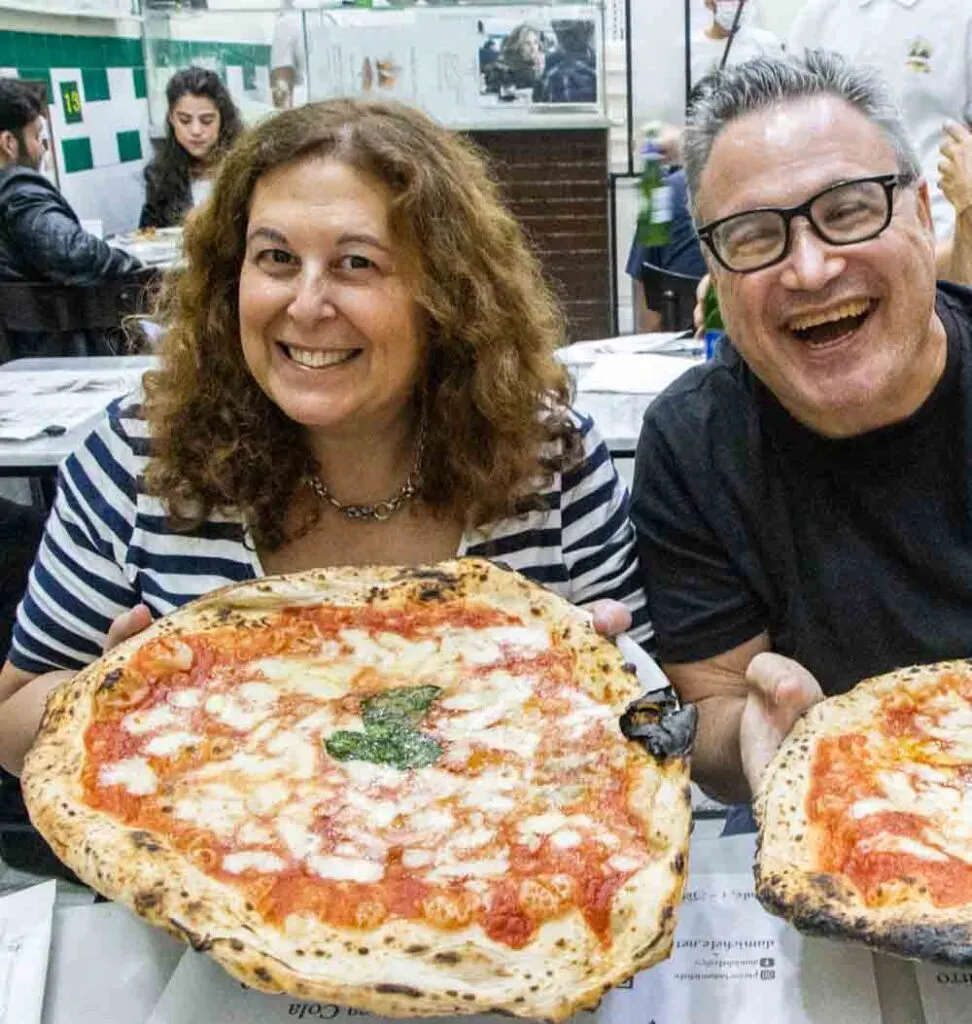
Like many, we’re partial to wood-fired Neapolitan pizza topped with San Marzano tomatoes grown in volcanic soil and Mozzarella di Bufala made with local water buffalo milk. But, after visiting Italy numerous times, we’ve come to appreciate Roman pizza too as well as simple pies in Italian cities like Parma and Verona.
Although we once traveled to Caiazzo to eat pizza at Pepe in Grani, we have yet to eat Sicilian pizza in Sicily – an omission that plan to correct when we visit Palermo in the future. For now, these are the Italian pizzas that we crave most:
19. Margherita Pizza
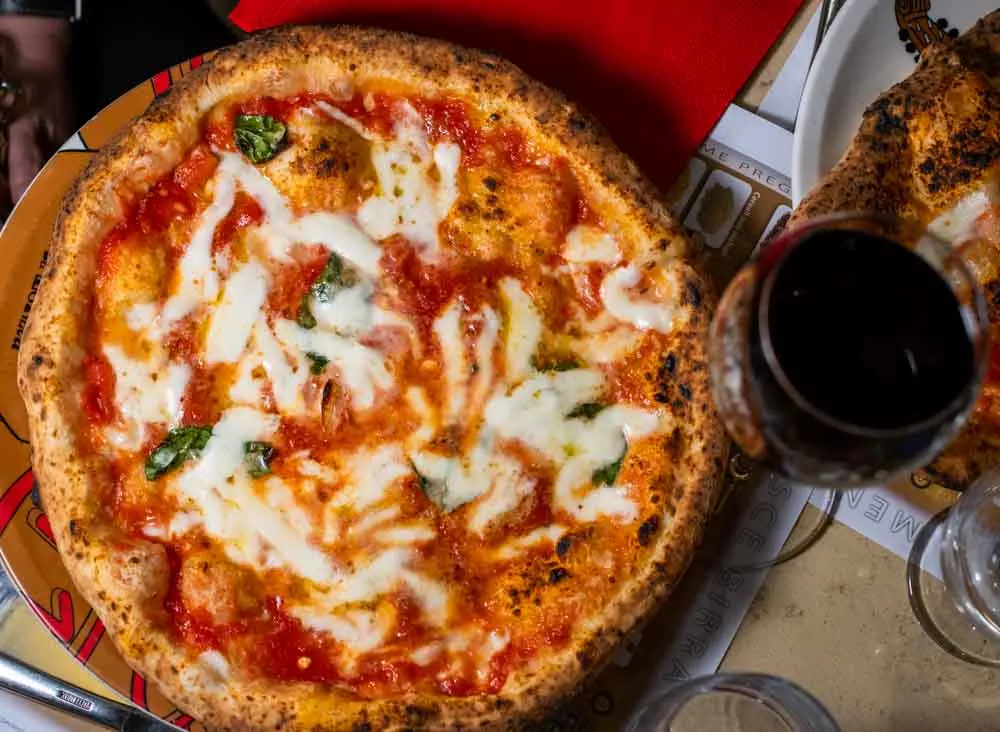
If Neapolitan Pizza is royalty in Italy, then Margherita is its queen.
We’re not just saying this because the simple pie mirrors the colors of the Italian flag and was allegedly invented at at Naples’ Pizzeria Brandi in honor of Queen Margherita. We’re saying this because Margherita Pizza is the bar by which all other pizzas should be compared.
Popular all over Italy and in countries around the world, a traditional Margherita Pizza is a round (or roundish) pie topped with tomato sauce, mozzarella and basil. It’s often the least expensive pizza on the menu and it rarely disappoints.
Discover where to eat the best pizza in Naples.
20. Maninara Pizza
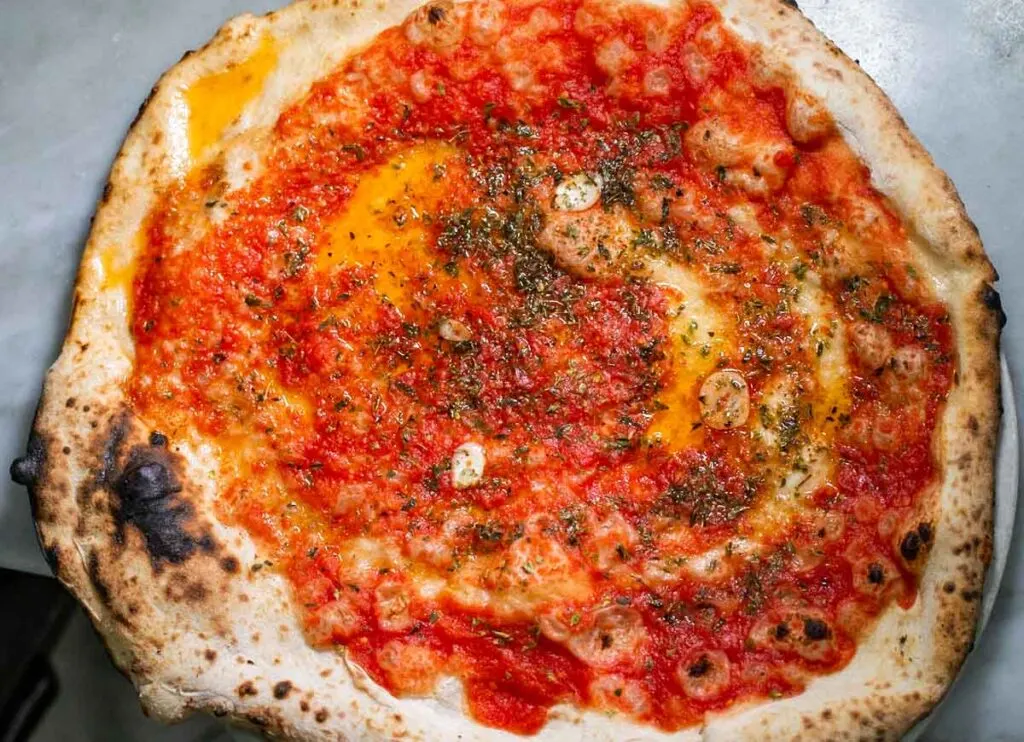
Named after sailors called marinai, Italy’s classic Marinara Pizza doesn’t feature any fruits of the sea. Instead, this classic pie got its name from the seafaring men who ate ‘Marina’ Pizzas topped with non-perishable items during long voyages.
Classic toppings include tomato, garlic, oregano and olive oil. That being said, we sometimes add anchovies to our personal list of Marinara Pizza toppings.
21. Pizza al Taglio
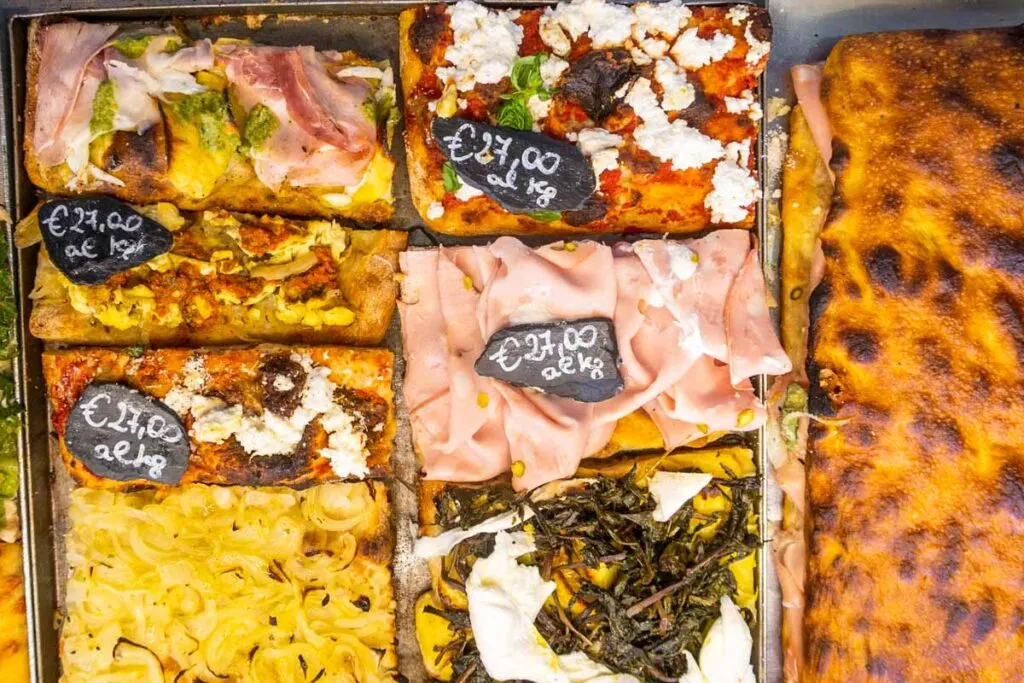
Rome’s Pizza al Taglio reminds us of loaded focaccia (see below). You won’t have to look hard to find these rectangular slices in Rome. Shops and stalls sell Pizza al Taglio all over the city.
Pizza al Taglio literally translates to sliced pizza. While some Italian vendors sell Pizza al Taglio slices for a fixed price, most calculate the price based on weight. Since Italy, like the rest of the European Union, uses the metric system, the listed price is typically per kilogram.
Discover where to eat the best pizza in Rome.
22. Pizza in Teglio
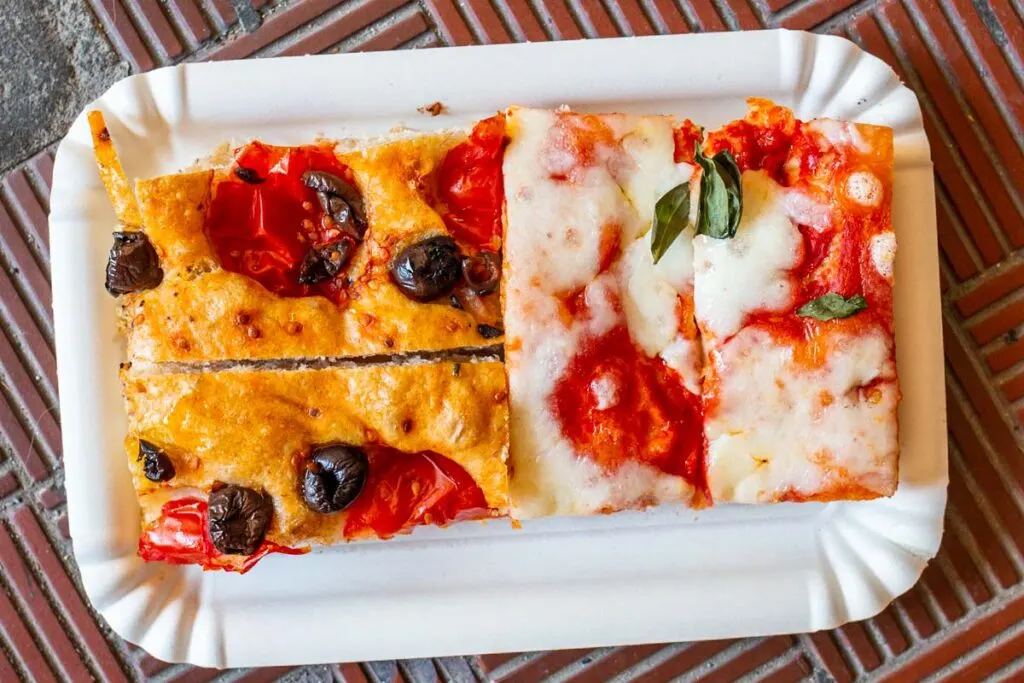
Another Roman pizza style, Pizza in Teglio, is also rectangular and sold by weight. But this style is different from Pizza al Taglio since it’s baked in a baking pan. Not surprisingly, teglio translates to baking pan and the pizza varietal is often sold at bakeries.
We first ate Pizza in Teglio in Bologna, more than 200 miles from Rome. The Bolognese have adapted the style, making it their own with toppings like Bolognese sauce and mortadella.
23. New Fangled Pizza
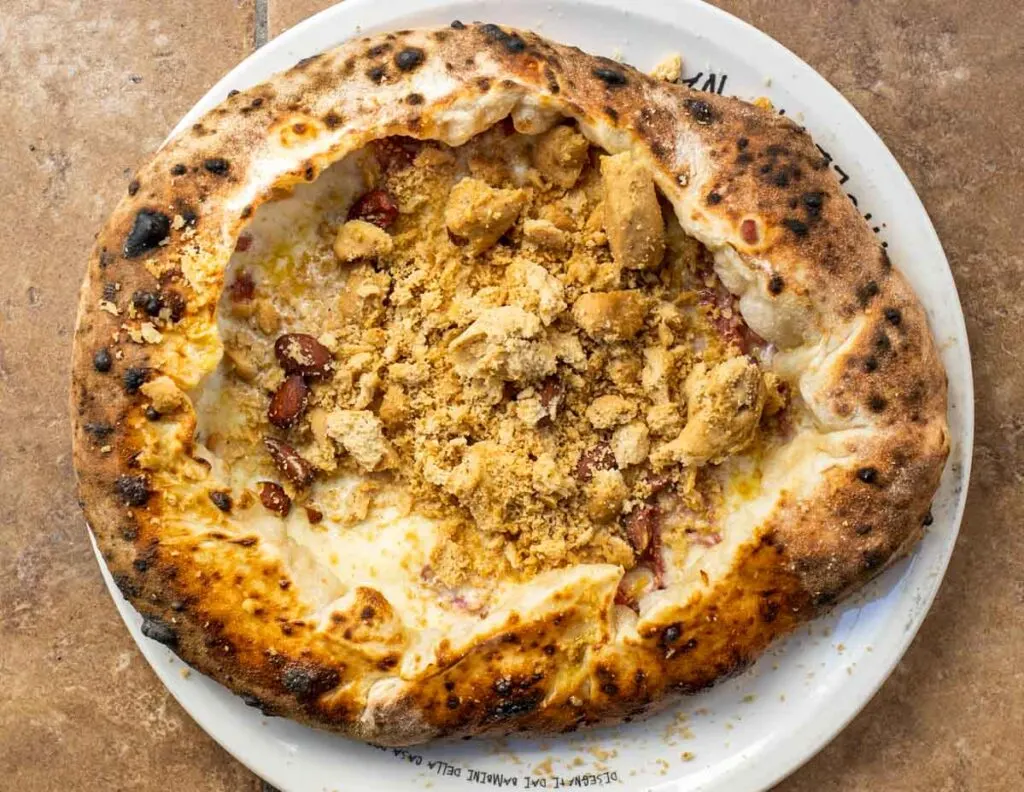
Pizza purists may be happy to stick with traditional pizza styles and toppings in Italy; however, the rest of us can go rogue by eating Neapolitan pies topped with crispy taralli and Roman pizzas topped with cacio e pepe. Then there are star-shaped pies with crusts stuffed with creamy ricotta.
It’s not that we have anything against tradition. It’s more that we’re equal opportunity pizza eaters.
Italian Street Food And Sandwiches
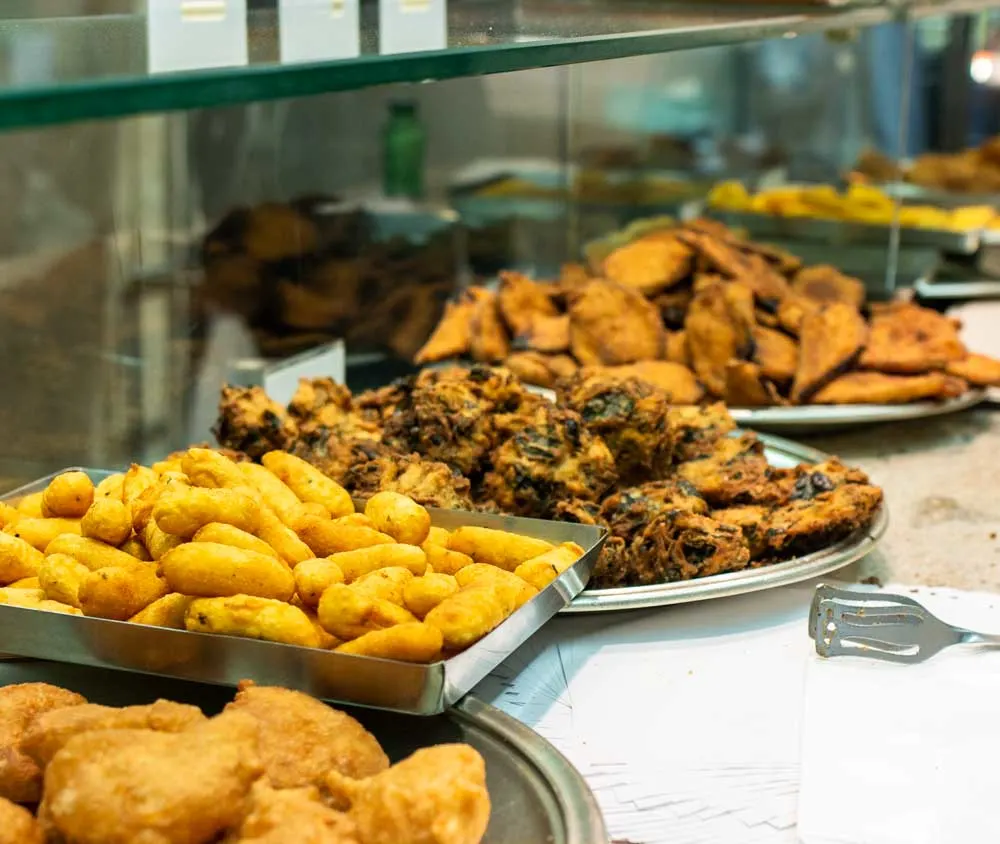
Just like Italy excels as a nation when it comes to topping a table with heaping plates of pasta, the country is equally adept at filling hands with savory sandwiches and a whole bunch of fried foods. These portable munchies represent some of our favorite Italian foods despite thanks to their low prices and despite their humble wrappings.
When we want to satisfy mid-afternoon hunger pangs and late-night cravings, and we’re not in the mood for pizza, these are our go to foods to eat in Italy:
24. Arancini
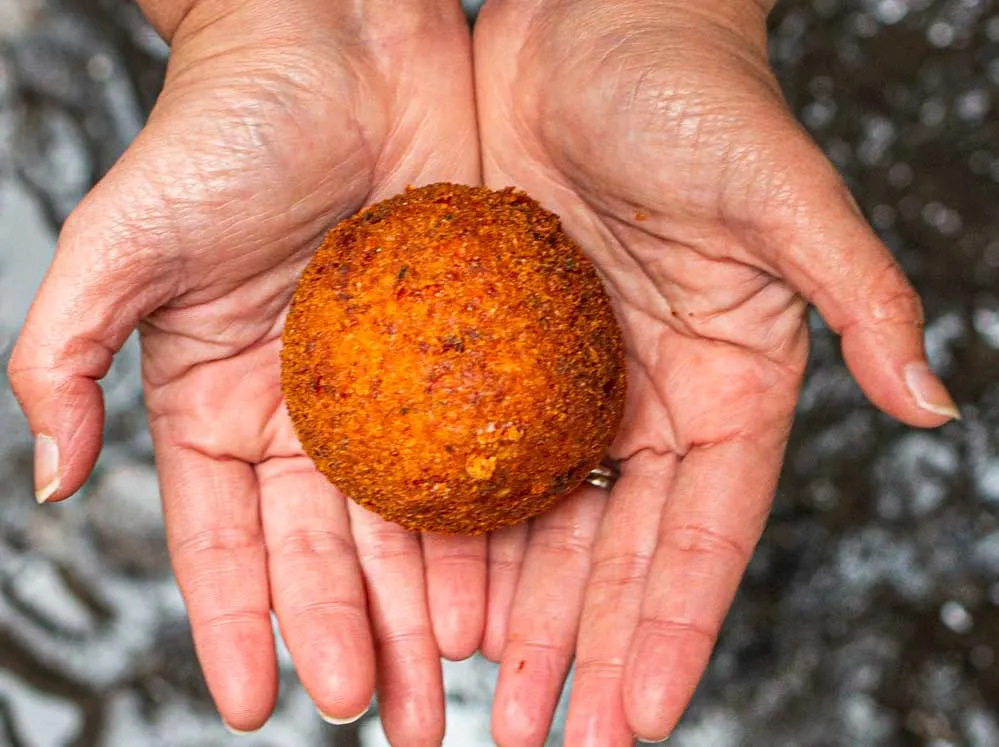
Sicily’s Arancini may be the world’s most perfect street food.
Round in shape, filled with rice and fried to crispy goodness, palm-sized Arancini are easy to eat without utensils and don’t make a mess. Plus, and most important, the Southern Italian street food favorite tastes great thanks to extra bits like cured meat, ragù and cheese.
Invented ten centuries ago and influenced by Sicily’s Arab conquerers, Arancini were named after the Italian word for oranges (i.e. arance). Not coincidentally, Arancini look like oranges, albeit oranges on steroids.
25. Suppli
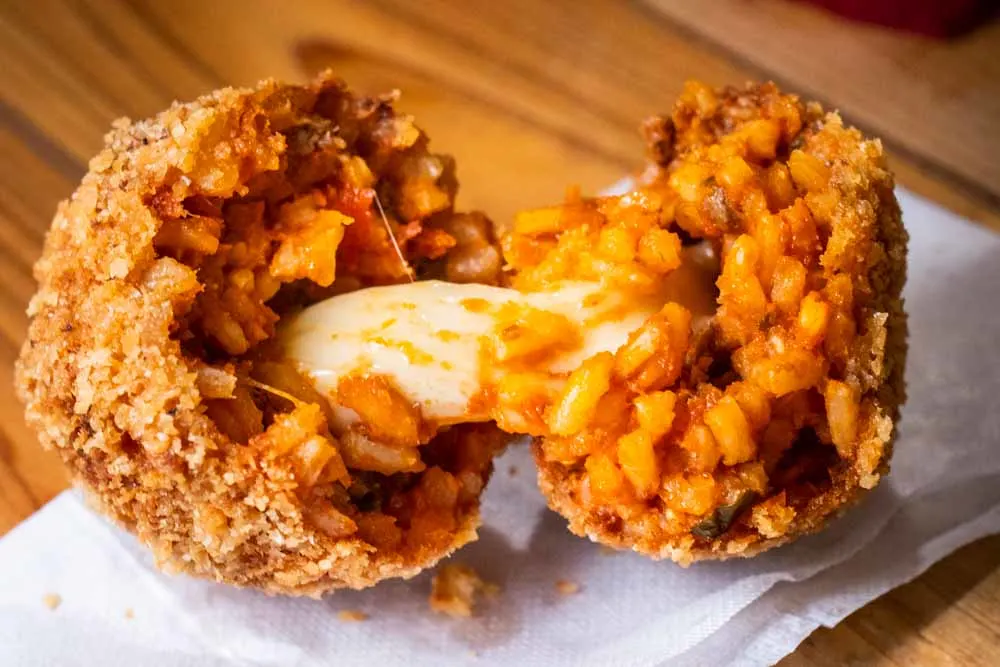
At first glance, Rome’s Supplì looks like Sicily’s Arancini (see above). The similarities don’t stop with appearance since both croquette-shaped treats have rice inside.
However, the Supplì has two extra bits – ooey gooey cheese and tangy tomato sauce. And, yes, it’s just as delicious as you suspect.
We’ve eaten the popular Roman street food everywhere in the eternal city from pizzerias to food markets. We also ate excellent Supplì during an excellent Rome street food tour.
Discover more great food in Rome.
26. Porchetta Sandwiches
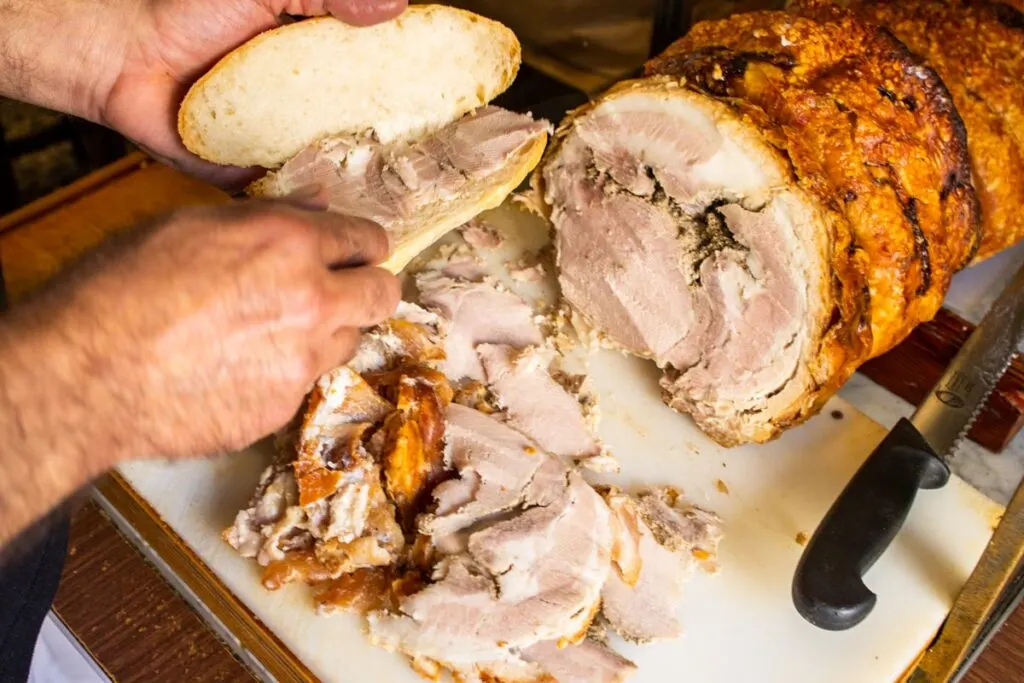
Porchetta rarely disappoints with its moist, herbaceous porky meat and crispy skin. Typical herbs include fennel, garlic and rosemary. Salt and pepper add the finishing touch.
A specialty food around the world, Porchetta is a readily available in Rome and throughout Italy at food markets and sandwich shops. However, in Italy, a Porchetta sandwich isn’t a specialty food. Instead, it’s a quick lunch on the go.
Porchetta is made by specially butchering and rolling an entire pig and then roasting it in an oven. Not a passing fad, there’s evidence of Porchetta in Italy going back 500 years.
Discover more great American sandwiches.
27. Frittatina
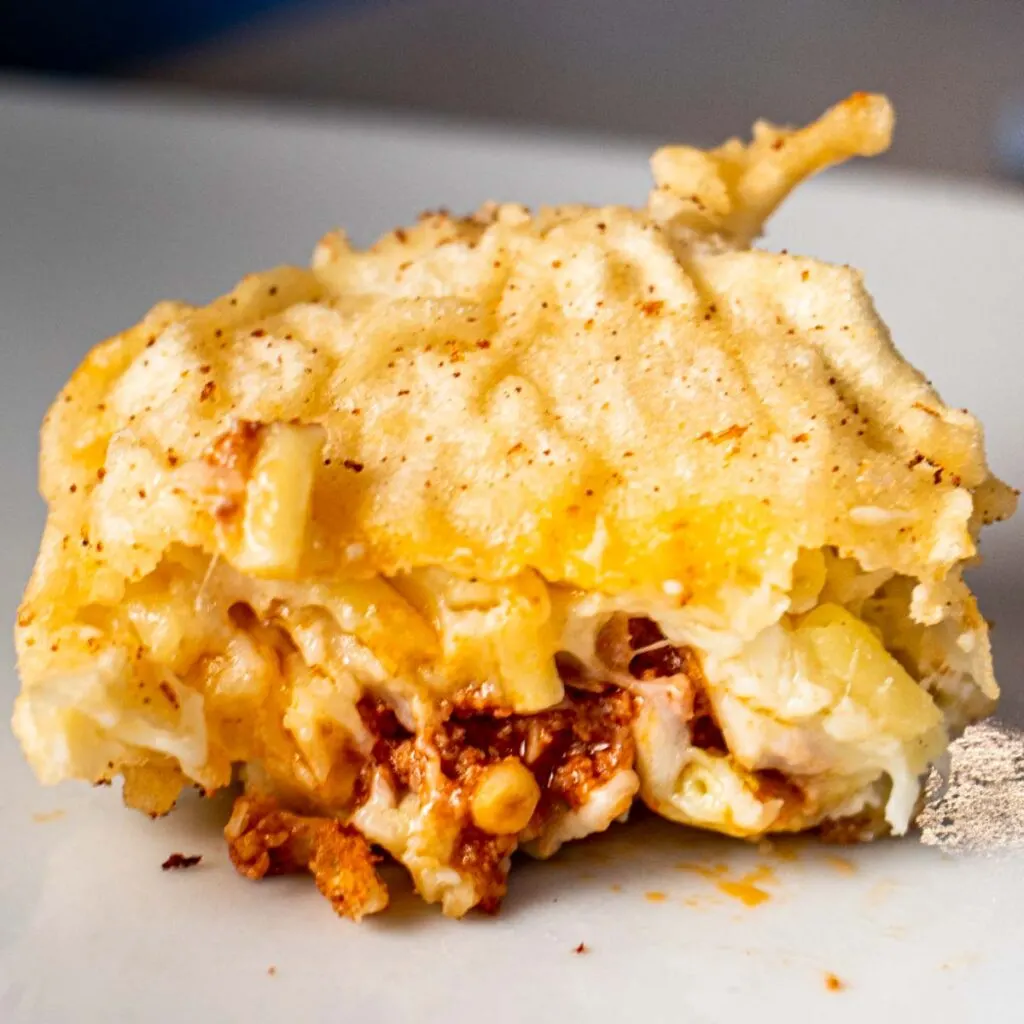
The Frittatina is proof that pasta fries up just as well as rice. Neapolitan figgitorie (fried snack stands) and pizza shops sell these deep fried pasta fritters all day, every day throughout the city.
More than just fried pasta, a crispy Frittatina includes ingredients like bechamel sauce and peas. Expect to pay a euro if you buy a Frittatina from a Neapolitan friggitoria and double that at the city’s pizzerias.
28. Fiori di Zucca Fritti
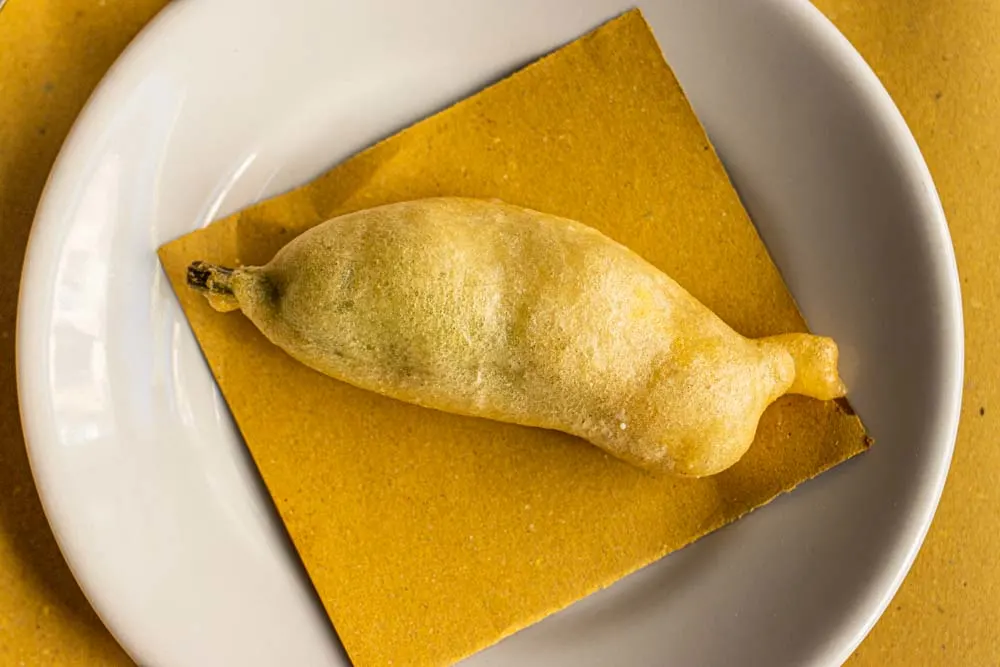
Naples may be the Italian hub for fried food like the Frittatina (see above), but Rome leads the pack when it comes to frying zucchini blossoms known as fiori di zucca in fried treats called Fiori di Zucca Fritti.
Roman chefs follow several steps to to make Fiori Di Zucca Fritti. They prepare batter, separate zucchini flowers and dice Provatura cheese. And that’s before anything hits the frying pan.
If you see Fiori Di Zucca Fritti on a Rome menu, order it. Since this delicacy isn’t available all year long, it’s a seasonal treat both for locals and travelers. Plus, ordering it is a heck of a lot easier than making this particular Roman food favorite from scratch.
Discover great restaurants in Rome for Fior Di Zucca Fritti and other classic dishes.
29. Cuoppo
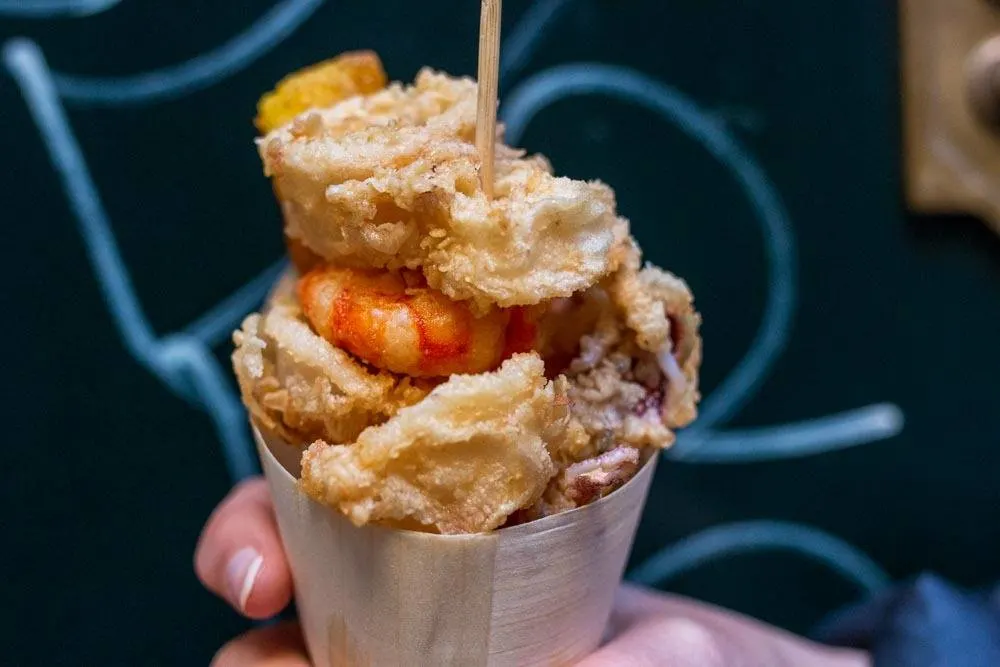
In Italy, the Cuoppo is the sweet spot where seafood and street food temporarily live in harmony inside a paper cone called a cuoppo. The fishy fast food favorite is particularly popular in the seafood-rich cities of Naples and Venice.
Expect to eat a Cuoppo with a cornucopia of fried items including proteins like cod, anchovies, shrimp and squid as well as vegetables like squash blossoms, zucchini and eggplant. The veggies make the Cuoppo feel healthy – that and the fish.
30. Pizza Fritta
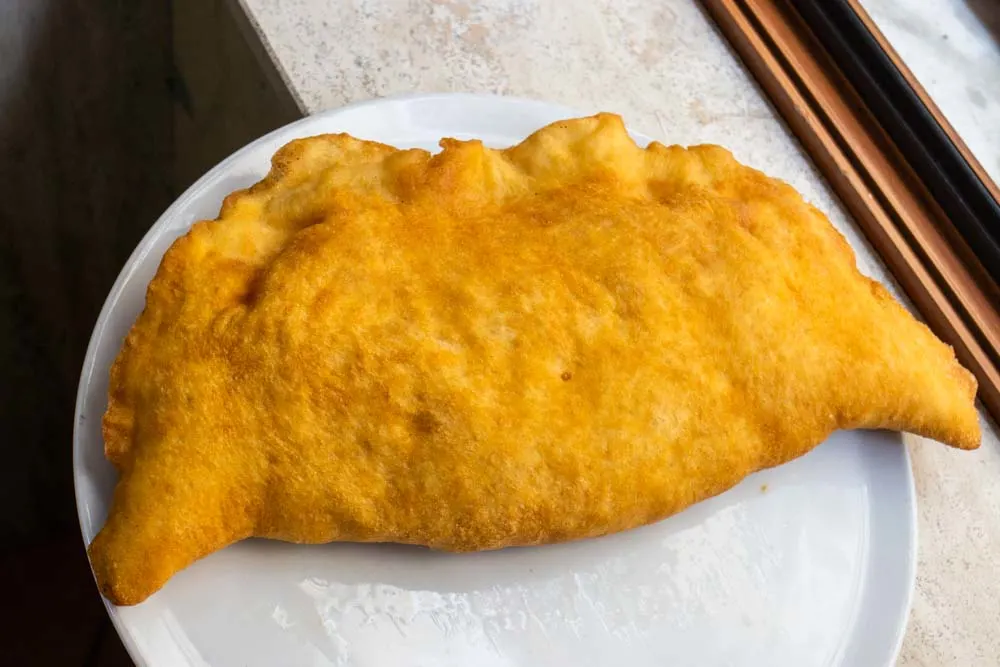
Pizza Fritta is proof that frying tasty food like pizza is usually a good idea. Most Naples pizza shops serve this pizza variation in addition to traditional Neapolitan pizzas baked in wood-fired ovens.
To make Pizza Fritta, pizzaiolos fry stuffed pizza dough in hot oil until ‘GBD’ (golden brown and delicious) and sell the street food at shops along Via dei Tribunali. Typical ingredients include cheese (ricotta, provolone and mozzarella) and meat (salami and ham).
31. Lampredotto Panini
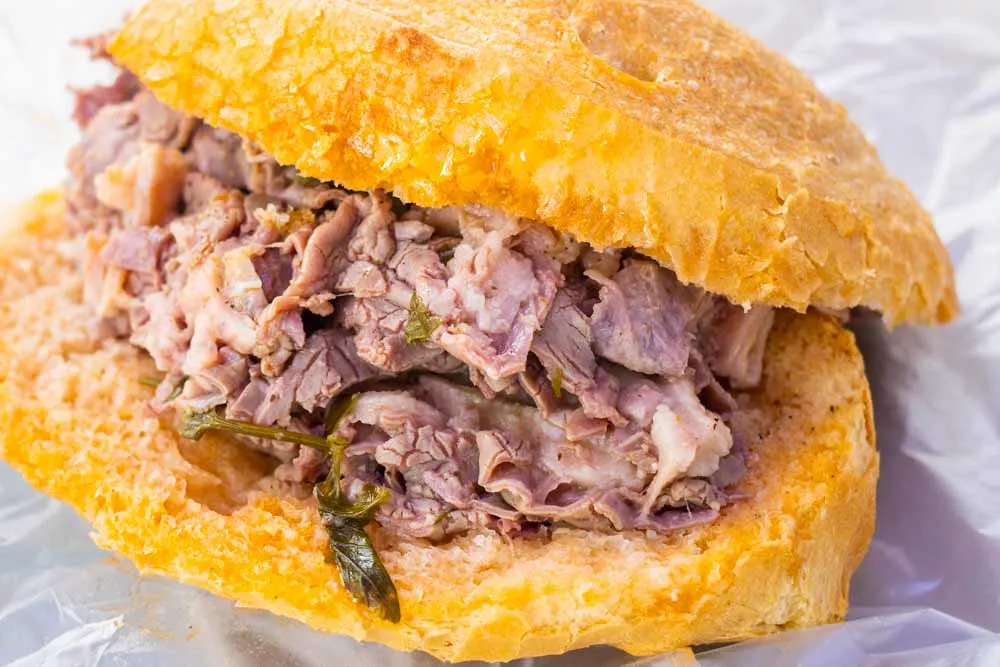
When it comes to tripe, most people fall into one of two categories. Some love the protein made from the cow’s fourth stomach while most wouldn’t eat tripe even if they were starving. In Florence, people in the first category queue to eat Lampredotto panini, Tuscan sandwiches filled with the savory offal and topped with salsa verde.
Florentine kiosks sell Lampredotto panini all over the city. Though it was originally a poor man’s dish, all sorts of people now eat this sandwich filled with slow-cooked, succulent tripe.
Discover more great sandwiches to eat around the world.
32. Piadini
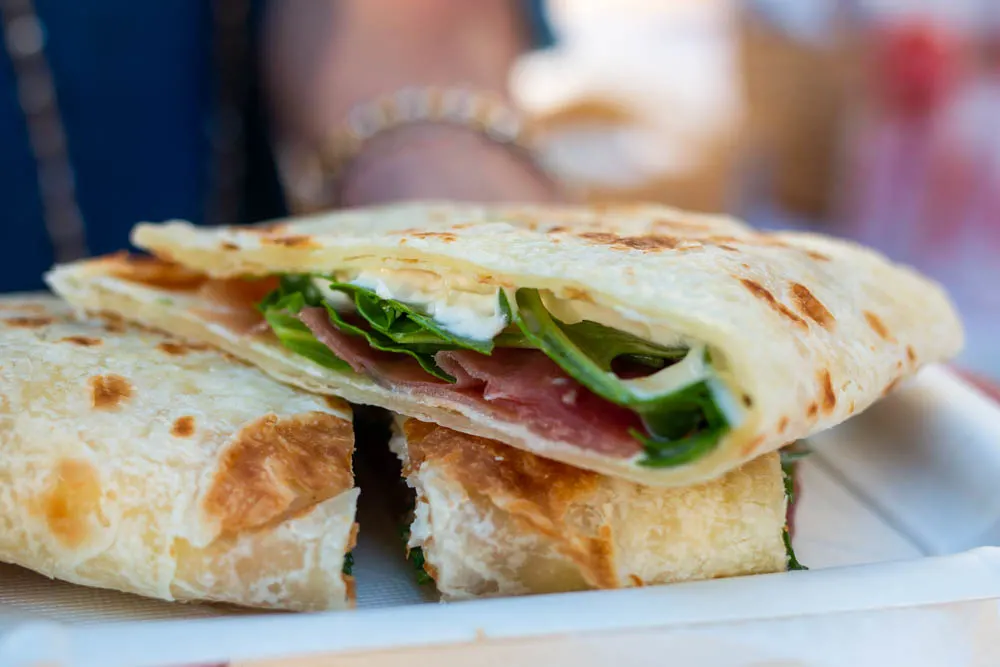
Some sandwiches are too big to fit into a normal-sized mouth. The slender Piadina is not one of those sandwiches. Popular in Romagna cities like Ravenna and Rimini, the Piadina is a simple yet buttery flatbread sandwich best served hot off the grill.
Don’t let this Italian sandwich’s simplicity fool you. Thanks to the quality of Emilia-Romagna meats and cheeses like Proscuitto di Parma, Mortadella and Parmigiano-Reggiano, the Piadina doesn’t need to be big to be great.
Discover our tasty Emilia-Romagna food experiences.
Italian Snacks, Small Plates and Side Dishes (Contorni)
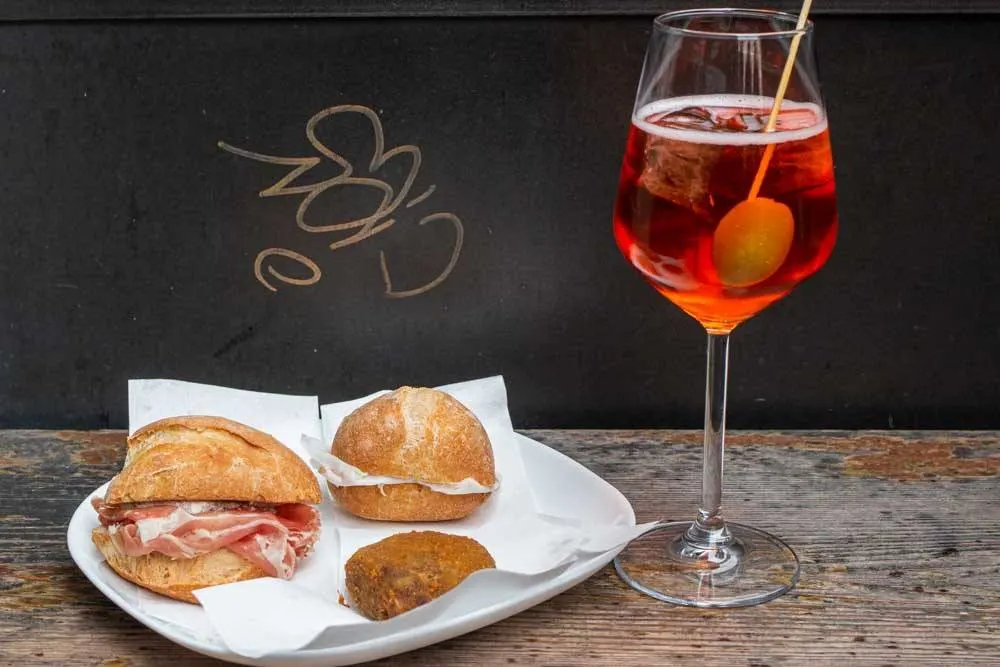
When non-Italians think about Italian food, they often think of big plates of food that double as a meal. However, that’s not how people actually eat in Italy. At least not all the time.
Italians like small plates just as much as Spanish people like tapas. They also like eating side dishes (i.e. contorni) with their main dishes (i.e. secondi) both at home and in restaurants.
Read on to discover the Italian snacks and dishes we like best to kick off a night of eating in Italy or to round out our dinner:
33. Aperitivo
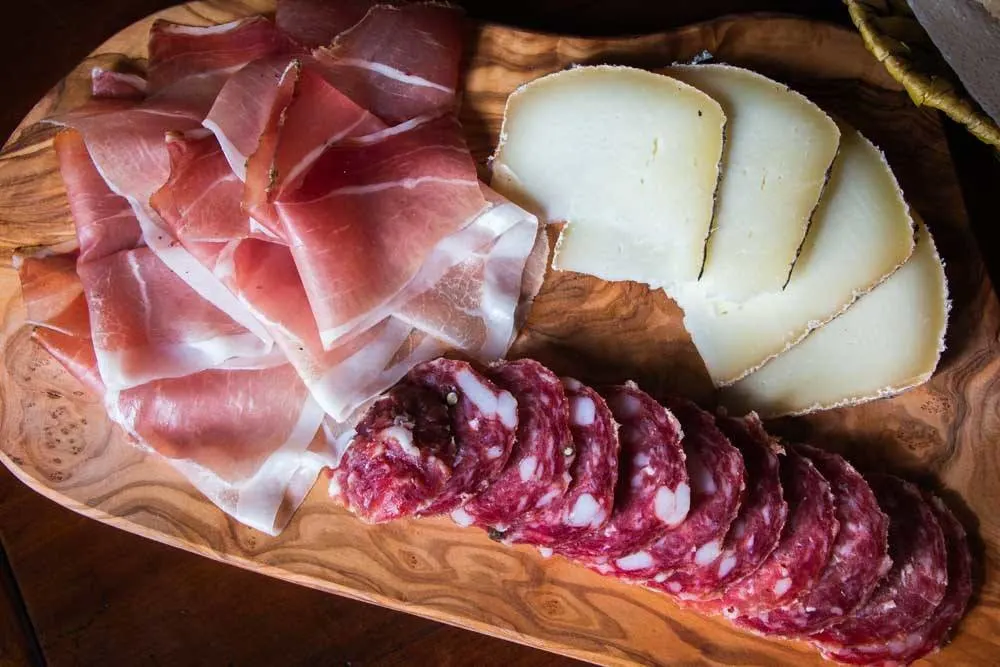
An aperitivo is technically a pre-dinner drink. However, in Italian cities, aperitivo is also a social activity that involves food and drinks. Typical aperitivo drinks include wine, beer and spritzes. Cured meat, cheese and olives are popular aperitivo nibbles.
When the day turns to dusk, Italians stream to cafes and bars in spots like Bologna’s Quadrilatero and Napoli’s Piazza Bellini to enjoy pre-dinner aperitivo sessions with friends and family. It’s a fun hang and great way to start the evening.
Enjoying aperitivo is one of our favorite things to do in Bologna. Discover more tasty Bologna activities you’ll want to experience when you visit La Grassa.
34. Cicchetti
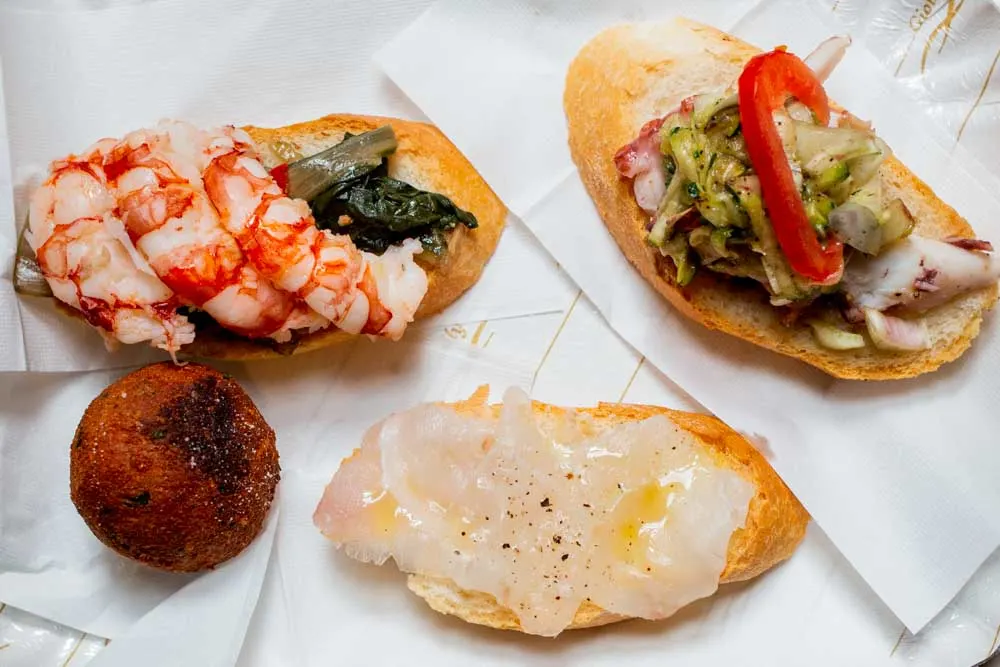
Popular in Veneto cities like Verona and especially Venice, cicchetti bars serve little plates of inexpensive food in addition to glasses of wine, Prosecco and the occasional Aperol Spritz. While the cicchetti concept is not entirely different from aperitivo, it’s more similar to Spanish tapas.
But make no mistake – a cicchetti crawl is a unique Venice experience and one not to miss. It’s a marvelous way to pass the time in between romantic boat jaunts on Venice’s network of canals and intimate, romantic afternoon strolls through the city’s narrow, maze-like alleys.
Discover the best Venetian cicchetti bars.
35. Fritto Misto
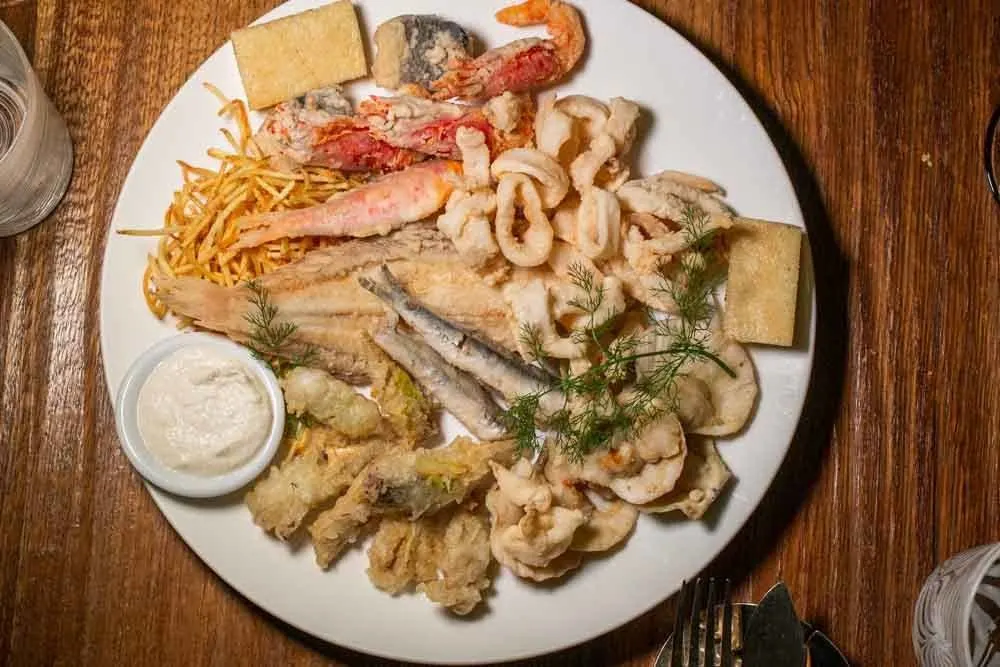
Frito Misto proves that not all fish is healthy and that’s okay. There’s something about the way that Italians bread and fry up fish, seafood and the occasional vegetable that makes us happy whenever we see the fried fish dish on an Italian menu.
Translating literally to mixed fried, Frito Misto lives up to its name with its fried melange of fried things. Typical ingredients include calamari, shrimp, scallops and smelts as well as squash and broccolini.
36. Insalata Caprese
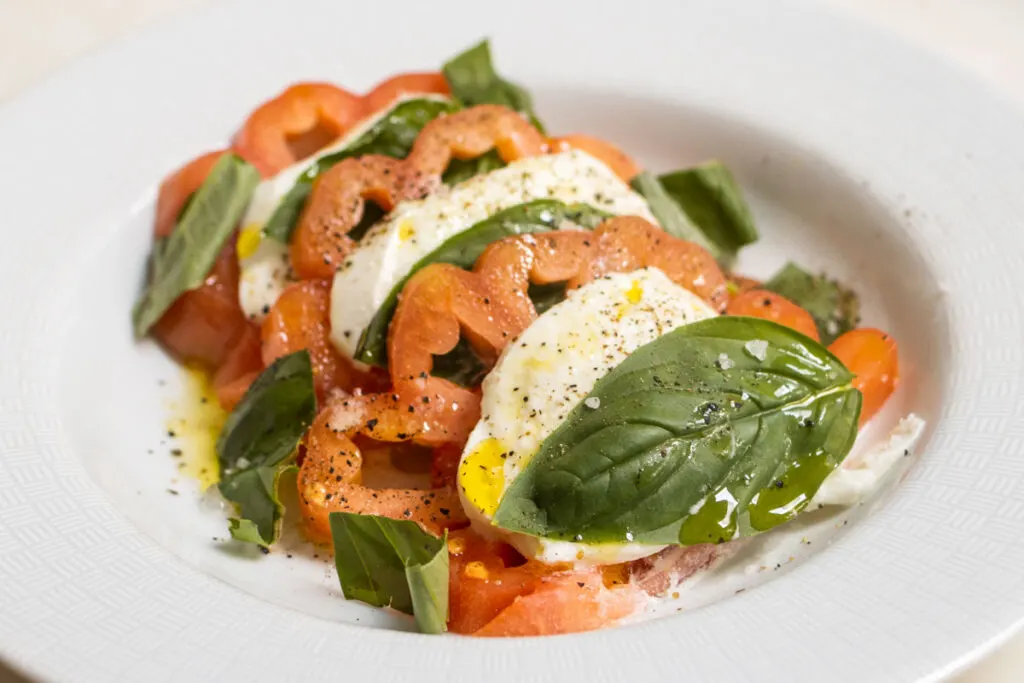
Italy’s Insalata Caprese, (i.e. Caprese Salad) proves that simple salads can be the best salads. Invented on the Isle of Capri near Sorrento, the salad is a popular aperitivo dish in Italy and beyond.
To make this five-ingredient salad, chefs and home cooks layer sliced tomatoes with mozzarella and top the melange with fresh basil, olive oil and salt. Not only does the resulting dish taste like summer, but it also matches the colors of the Italian flag.
Discover more great salads to eat around the world.
37. Panzanella
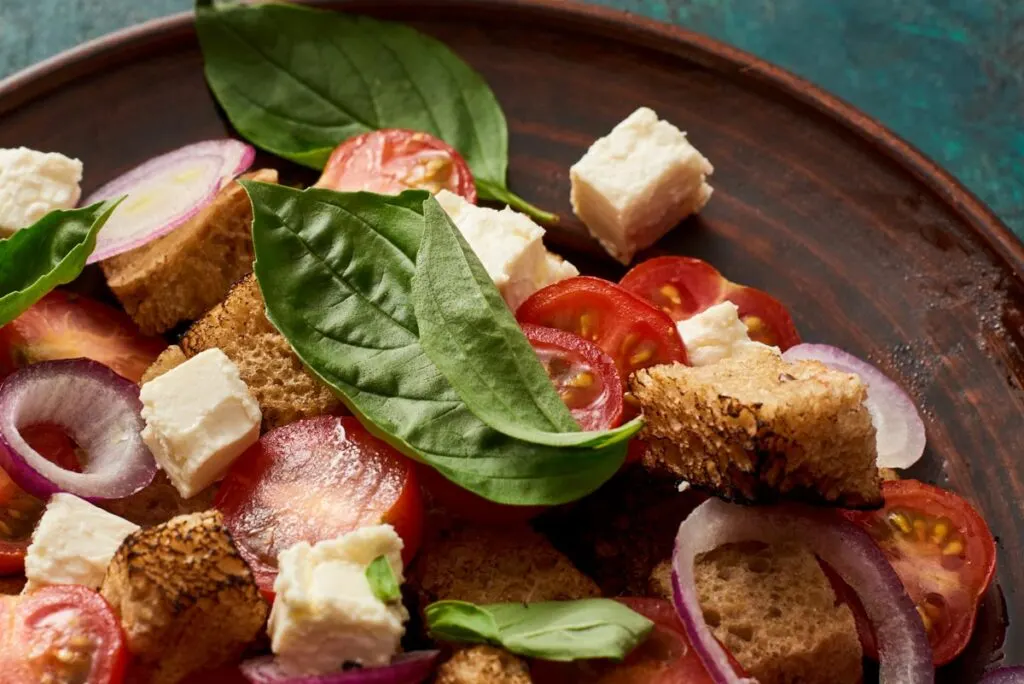
Panzanella is a Tuscan dish that provides a forum for stale bread that differs from Pappa al Pomodoro and Ribolita (see both above). Unlike those hearty Tuscan soups, Tuscany’s Panzanella is a salad.
Most prevalent in the warm summer months when Tuscan produce it at its peak, a Panznella salad starts with tomatoes and adds veggies like cucumbers and onions. Stale bread provides crunch while ingredients like olive oil, vinegar, mozzarella and basil add extra flavor.
38. Bruschetta
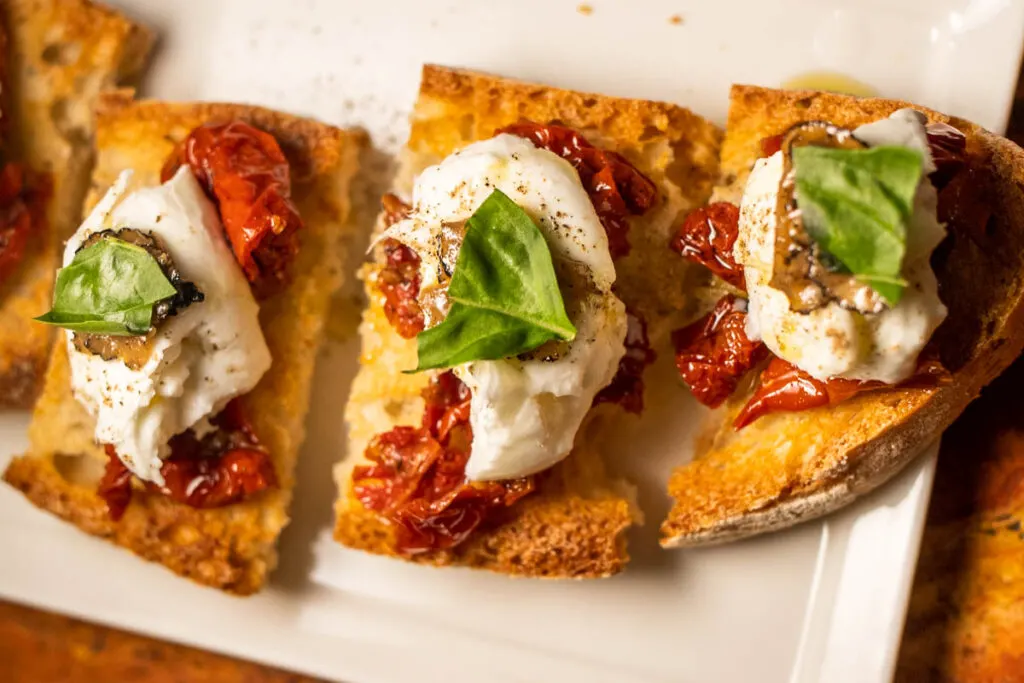
When Americans think of Bruschetta (also known as crostini), they typically think about crunchy bread slices rubbed with garlic and topped with a mixture of tomatoes, olive oil and herbs. Sometimes they just think of the red tomato topping.
Italians take Bruschetta further. Not limited to tomatoes, they occasionally top the Italian starter with ingredients like cured meat, local cheese and veggies. Sometimes they just use olive oil. Since Bruschetta originated in Italy centuries ago, they can do whatever they want.
39. Carciofi alla Giudia
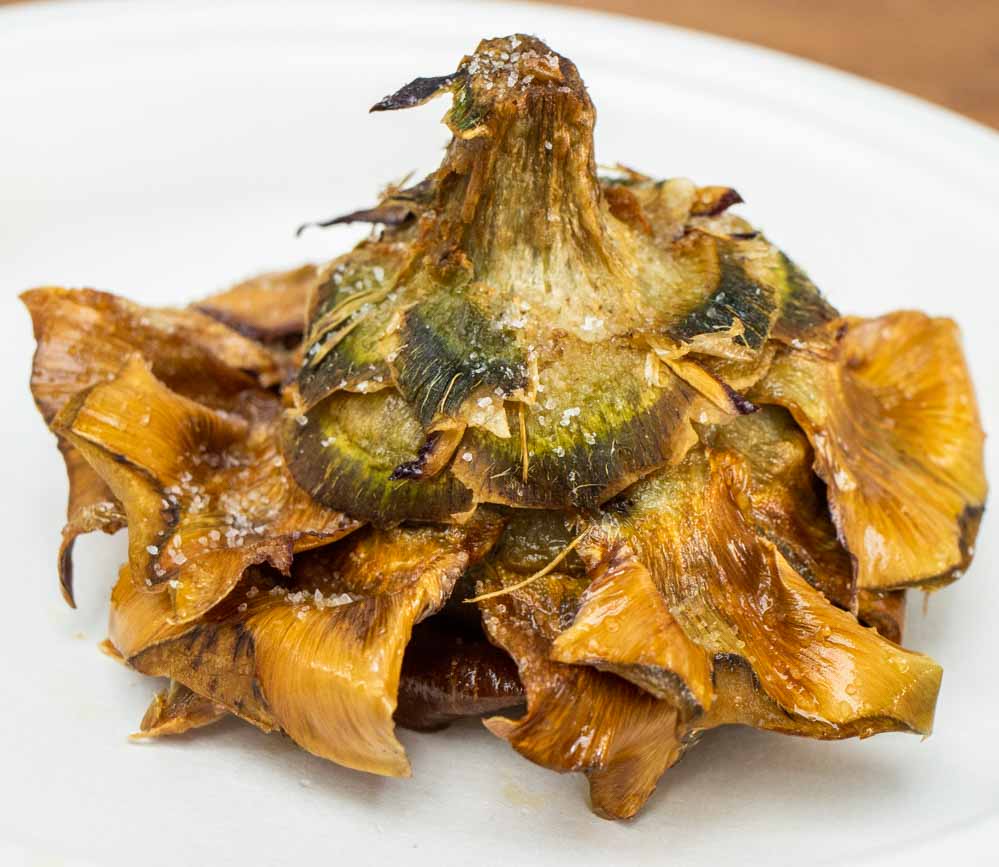
Named after Roman Jews who invented the dish in Rome’s Jewish Ghetto, Carciofi alla Giudìa is a deep-fried artichoke that almost looks too pretty to eat. But eating the seasoned thistle flower is the thing to do whenever the opportunity arises.
Roman chefs prepare Carciofi alla Giudìa with artichokes grown near the city. Although peak artichoke season in the region is from February to April, we’ve had no problem finding the crispy classic in autumn months.
40. Foccacia
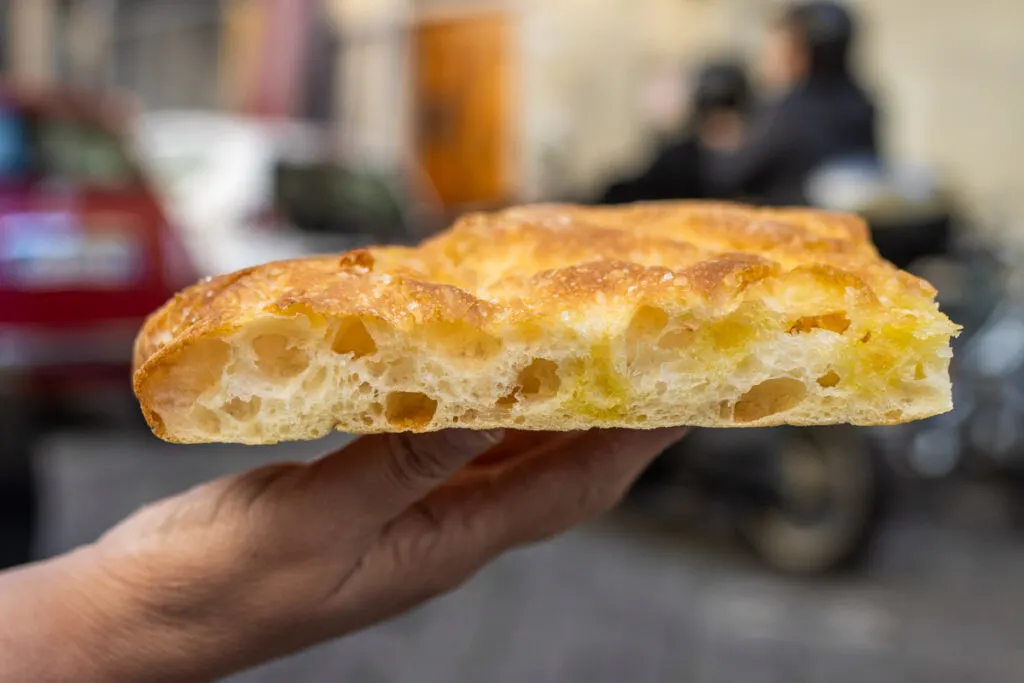
Best eaten when it’s hot out of the oven, Focaccia is an Italian flat bread found all over Italy in both restaurants and bakeries. And, while it’s a great vessel for sandwiches, basic Focaccia tastes great on its own or with a little bit of olive oil and a few sprinkles of salt.
But not all Focaccia in Italy is simple. Some bakers add savory toppings like cheese, olives and meat to their Focaccia recipes while other make sweet versions with sugar, honey and even raisins. Then there are Italian bakers who make bread pudding with leftover Focaccia.
41. Gnocco Fritto
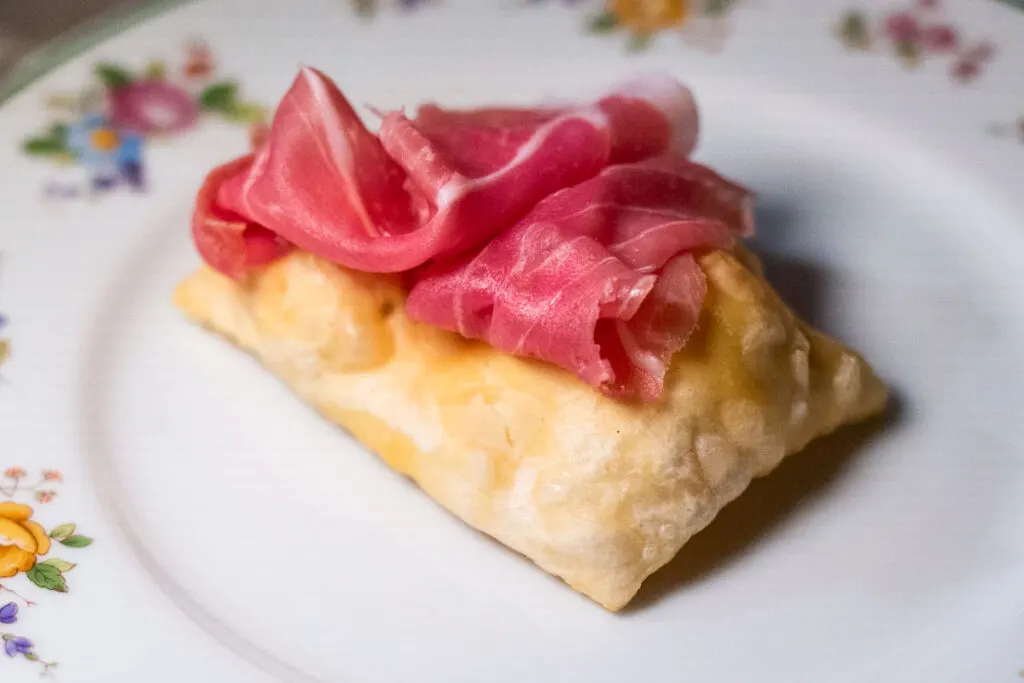
While famous for its fresh pasta, Emilia-Romagna has more than one starchy starter. One of our favorites is the region’s less famous but much loved Gnocco Fritto.
Literally translating to fried dumpling, a Gnocco Fritto is a puffy dough that’s been fried in lard to create a pillow-like vessel for salumi. It’s a great starter that pairs well with local wines like Lambrusco.
Discover more great food in Modena.
42. Polenta
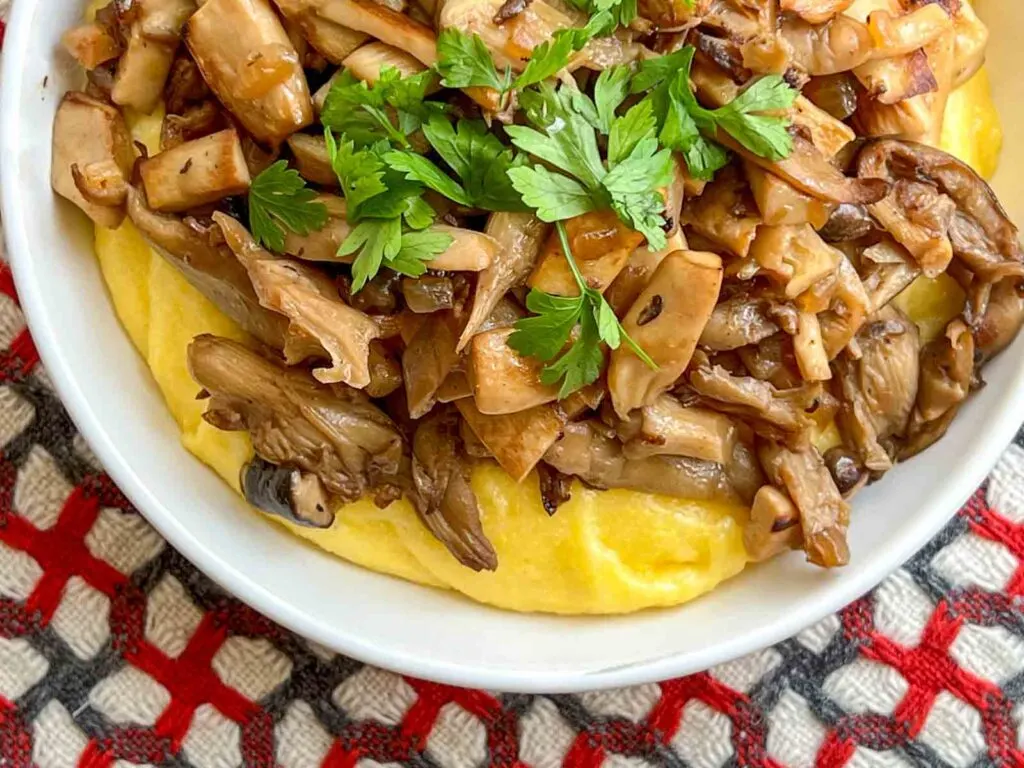
A staple in cuisines around the world and not so different from the American food favorite called Grits, Polenta’s cornmeal roots are in Northern Italy. However, in an interesting twist, ancient Romans ate Polenta centuries before corn arrived in Italy from the Americas.
Ancient Polenta was made with other grains and bean before cornmeal became the dish’s grain of choice. Some chefs prepare Polenta so that it has a mushy, porridge-like consistency while others achieve a firmer texture like the excellent white version we ate in Venice.
Follow our Italian Polenta and cook the creamy side dish at home.
43. Polpette
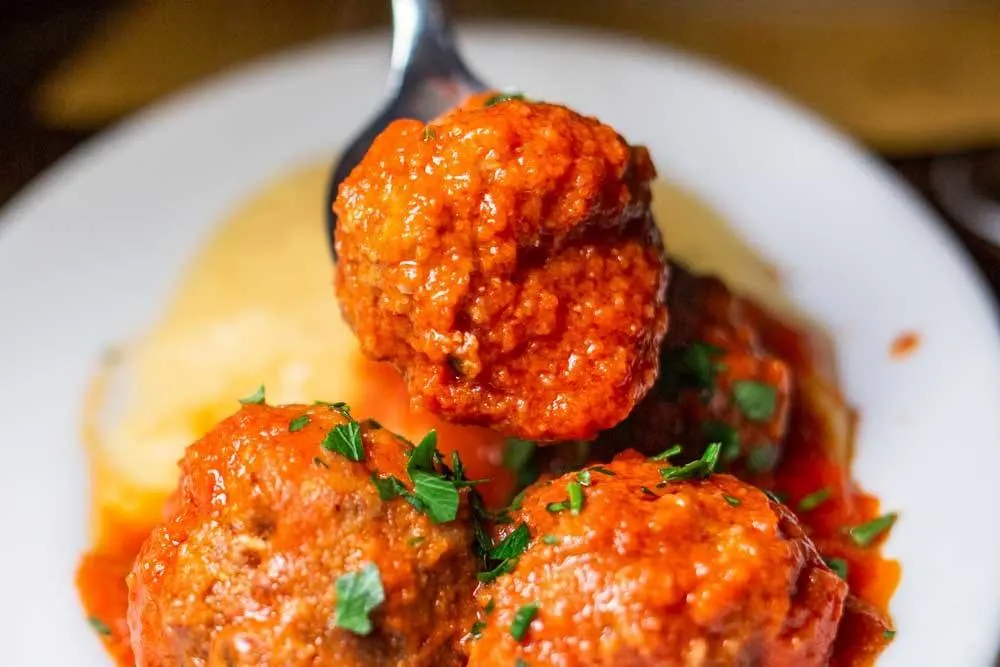
Unlike America where meatballs are served with spaghetti, Italians eat meatballs called Polpette as starters without pasta. They typically fry them up or smother them with savory tomato sauce. Sometimes they even eat them on a cuzzetiello sandwich.
You can eat fried Polpette as a protein-forward snack food while you’re touring Naples or eat the ragù-topped version at a local trattoria in cities like Venice. If you want to try the latter, order Polpette in Sugo when you see it on a menu.
Italian Second Courses (Secondi)
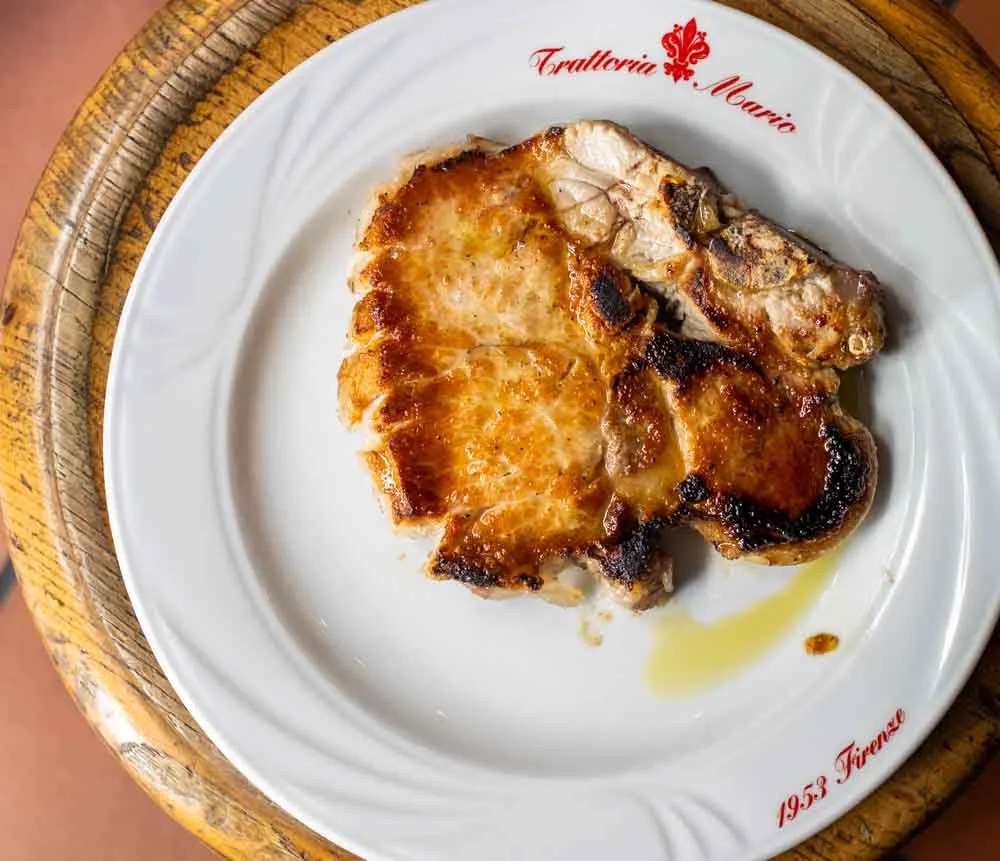
Secondi literally translated to seconds, but secondi on an Italian menu are far from sloppy afterthoughts. Instead, secondi dishes are arguably the meal’s main event.
Often involving seafood in the south and meat in the north, most secondi are simply prepared and served without vegetables. It’s not that Italians don’t eat vegetables. Rather, they order them as side dishes called contorni (see above).
While ordering a secondo isn’t mandatory at Italian restaurants, these are the secondi that we rarely skip when we dine at an Italian restaurant:
44. Bistecca alla Fiorentina
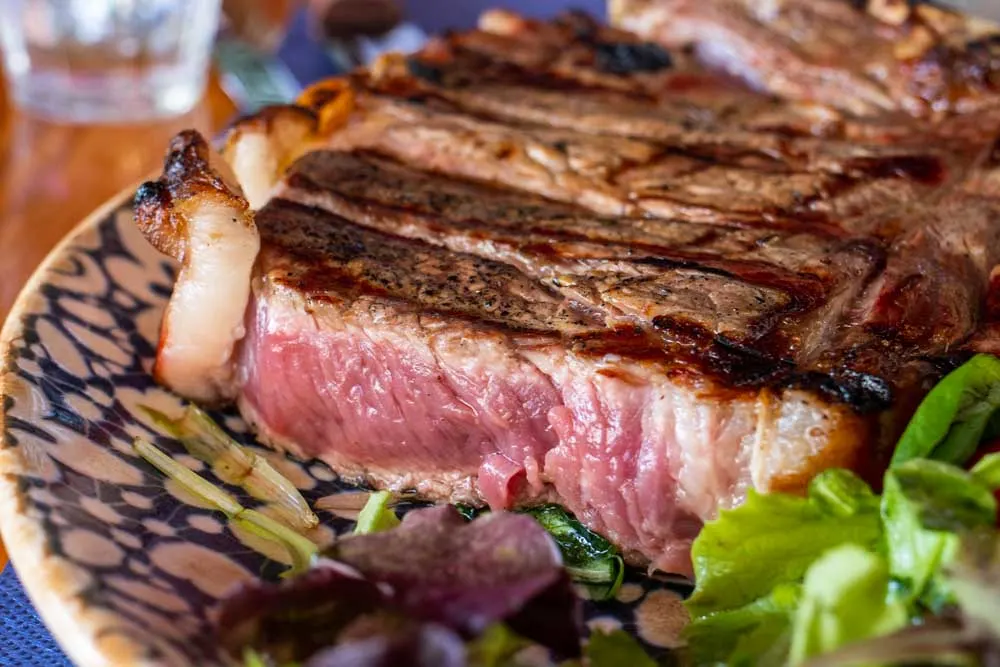
Although Bistecca alla Fiorentina is easily the most famous dish served in Florence, it’s not for everybody. However, this hunk of dry aged Tuscan steak is the number one dish in Florence for carnivores with a healthy budget and hearty appetite – preferably with a carafe or, better yet, a bottle of red Tuscan wine.
Not your typical slab of steak, Bistecca alla Fiorentina is thickly cut, served on the bone and flame grilled with a charred outside and rare (some would say raw) center. The meat itself comes from grass-fed white Chianina cows raised in Tuscany’s hills and its simple preparation involves salt, pepper and fire.
45. Tagliata
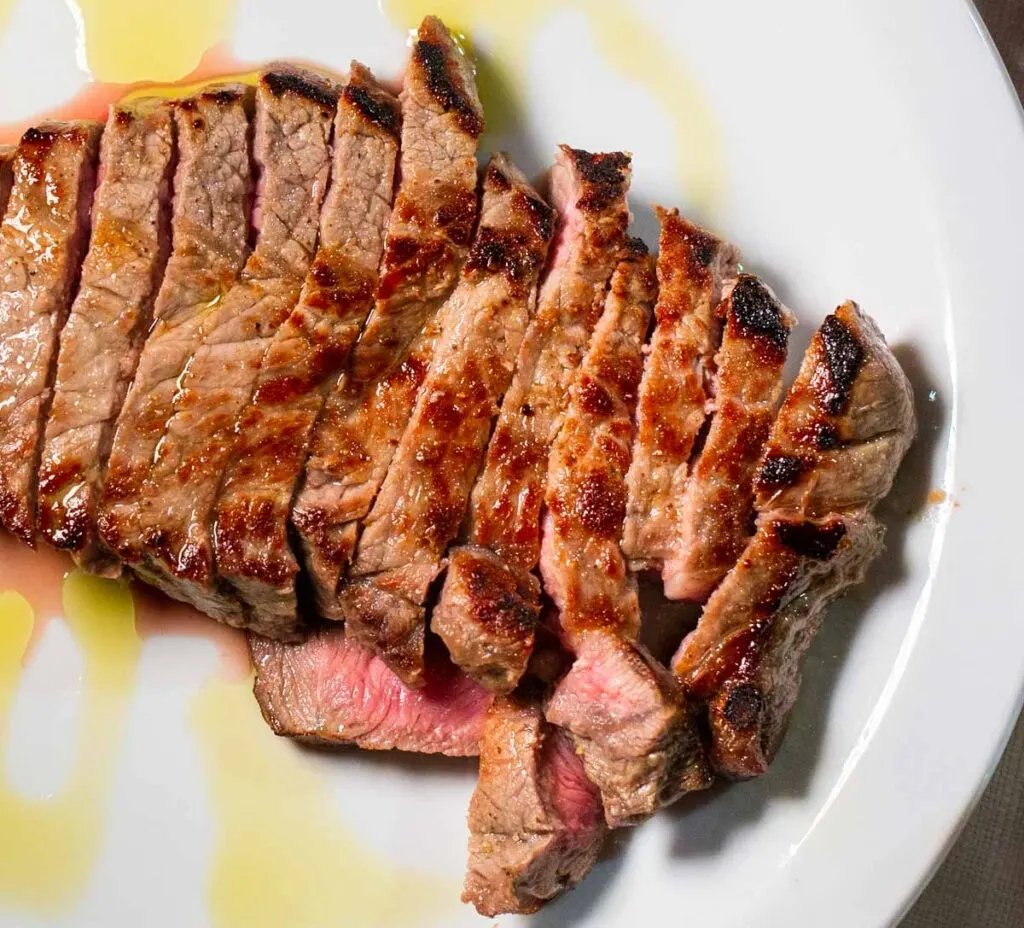
If you’re familiar with Pizza al Taglio (see above), then you might guess that steak called Tagliata is sliced just like that pizza. You would be correct. (Taglia translates to cut in English.)
Unlike Bistecca alla Fiorentina, Tagliata isn’t served in its bloody red glory. Instead, cooks grill cuts like hanger and sirloin before slicing the filets into slender slices. Salt adds a simple but satisfying finish while a salad turns the dish into a meal.
46. Cotoletta

Italians have an ongoing debate with Austrians about the origin of the marvelous breaded meat cutlet that Italians call Cotaletta. In Italy, the root of the word cotoletta comes from the word for rib – costoletta. This is because the original Cotoletta was a bone-in cut. With a lack of a time machine or the benefit of prescience, we’ll never know who originally decided to dredge a flattened piece of meat in breadcrumbs and then fry it. But we know that it tastes good.
In cities like Bologna, chefs top Cotoletta alla Bolognese with slices of prosciutto or culatello and melt Parmigiano-Reggiano on top to achieve the dish’s deep flavors. Cotoletta alla Milanese has become so synonymous with breaded and fried meat that countries like Mexico and Portugal have adopted the word Milanese for any meat that’s breaded and fried.
Discover more great food in Bologna.
47. Seafood (Pesci)
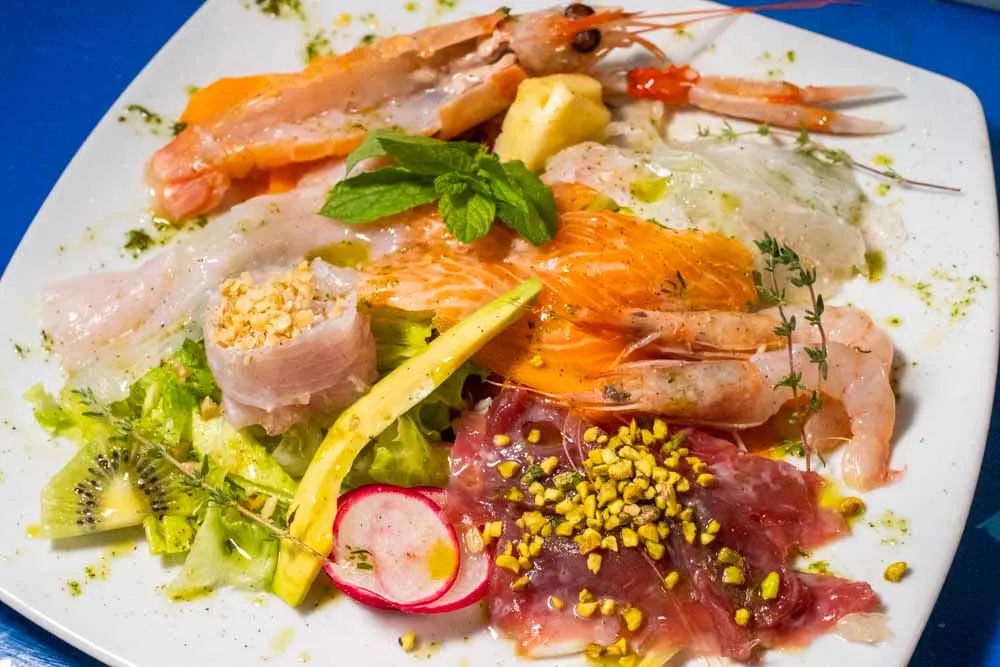
Practically surrounded by water, Italy’s prime geographic location gives its fishermen access to amazing fruits of the sea. But not just one sea. Italian fishermen procure their local catches from the Adriatic, Ionian, Mediterranean and Tyrrhenian Seas.
Seafood varietals and preparations are different throughout the country though there’s some overlap like Spaghetti alle Vongole which is as popular in Venice as it is in Naples. However, there’s nothing like eating locally caught seafood at Italian restaurants whether you eat eel in the Veneto or seafood stew in Puglia.
48. Bollito Misto
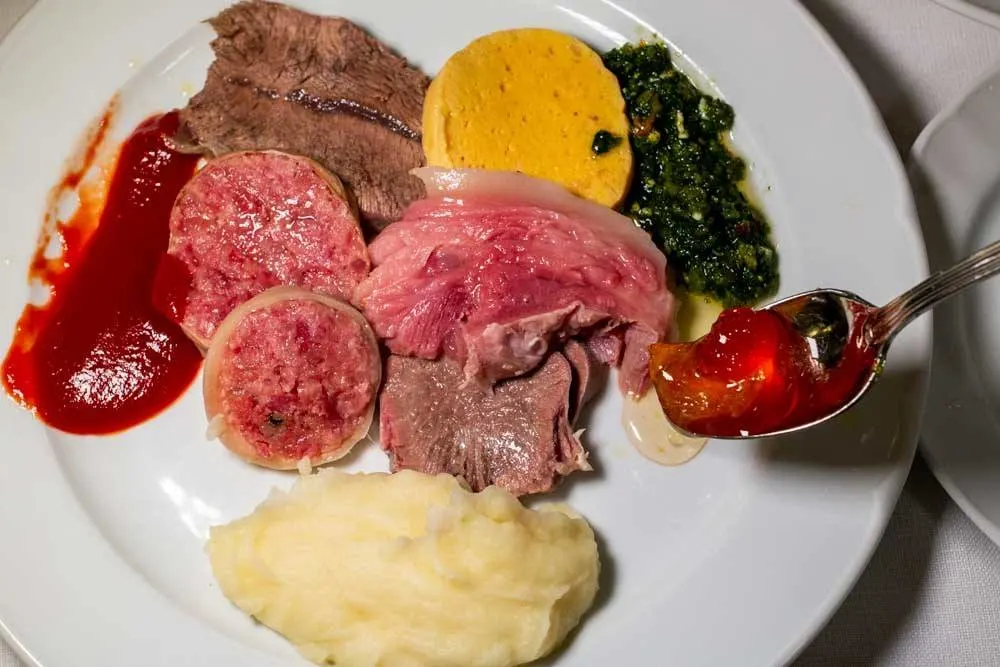
Featured in cities like Parma, Verona and throughout the north, Bollito Misto is a meat lover’s fantasy. This Northern Italian rendition of mixed meats, not dissimilar to France’s pot au feu, is so legendary that there are secret societies built around the enjoyment of the legendary carnivorous extravaganza.
It’s not for the faint of heart. In this Italian dish, a large range of mixed meats like beef cheek, tongue and cotechino sausage are essentially cooked low and slow and then served with condiments including verdant Italian salsa verde, mostarda and horseradish.
Discover more great food in Parma.
49. Vitello Tonnato
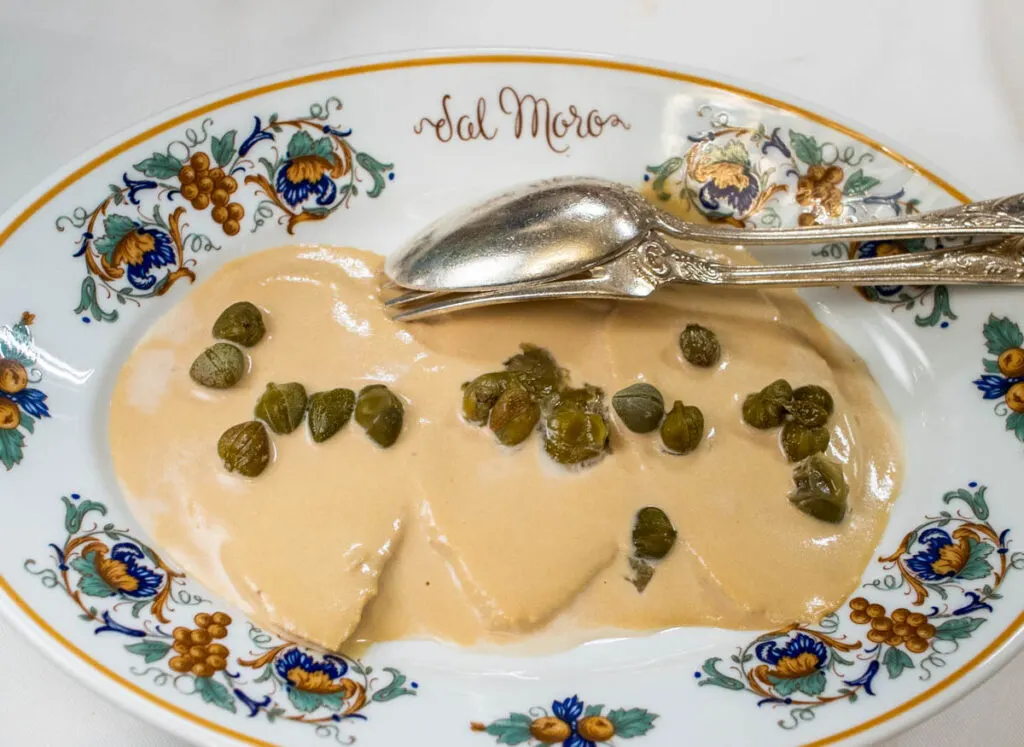
Topping thinly sliced veal with a fishy sauce sounds weird unless that sauce is Tonnato.
With a history dating back to the 19th century and ties to both Piedmont and Milan, Tonnato is a creamy sauce that combines tuna and anchovies and adds lemon juice, egg yolks, capers and olive oil to the fishy party. Tonnato tastes great over veal in the classic dish Vitello Tonnato but it’s also a super sauce for chicken, salmon and asparagus.
Some people even use Tonnato as a dip or dressing. In other words, Tonnato tastes great on almost everything.
50. Ossobuco alla Milanese
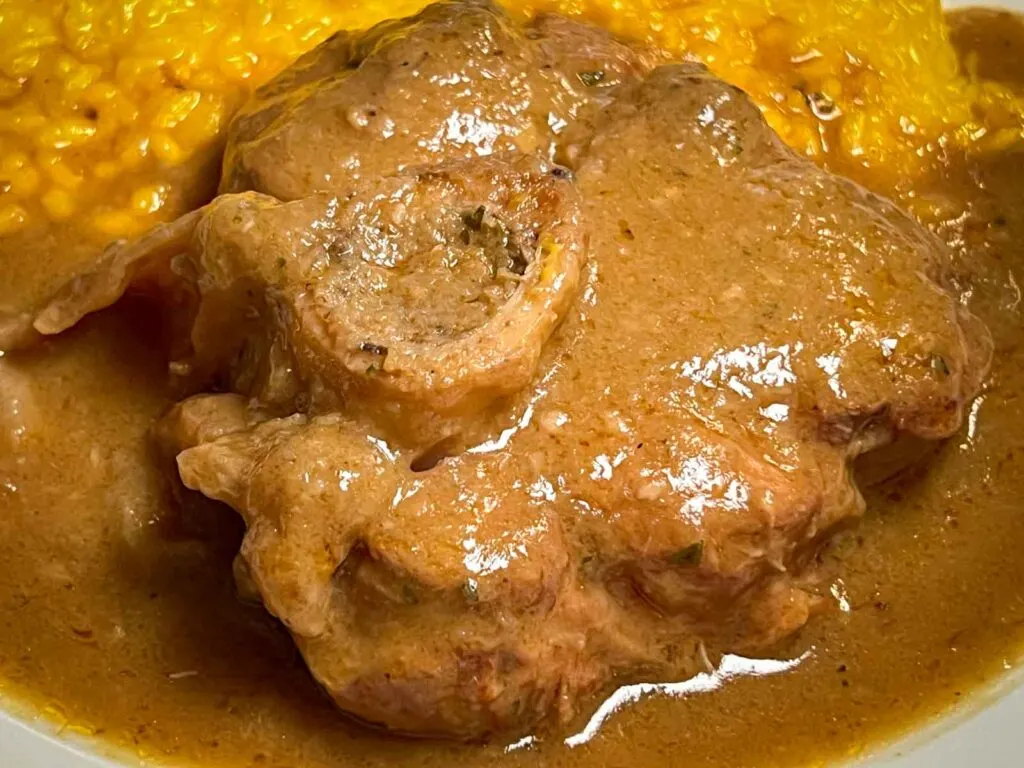
If you were to describe Ossobuco as a dish of clever poverty, we wouldn’t disagree.
To make this dish, Italian butchers slice a large shank bone into steaks and then slow cook them into tender meltiness. Sure, they could sell the entire shank (called stinco) but why do that when one leg can feed a few people. Plus, slow cooking collagen-rich veal bones creates a silky sauce.
Ossobuco alla Milanese is considered a luxury dish on modern Italian menus which belies the veal shank’s humble origins. Made famous in Milan, it’s typically served with either Risotto Milanese or Polenta (see both above).
Fun Fact
Older versions of the Ossobuco alla Milanese recipe cook shanks without tomatoes while newer Italian recipes incorporate the juicy red fruit.
51. Trippa alla Romana
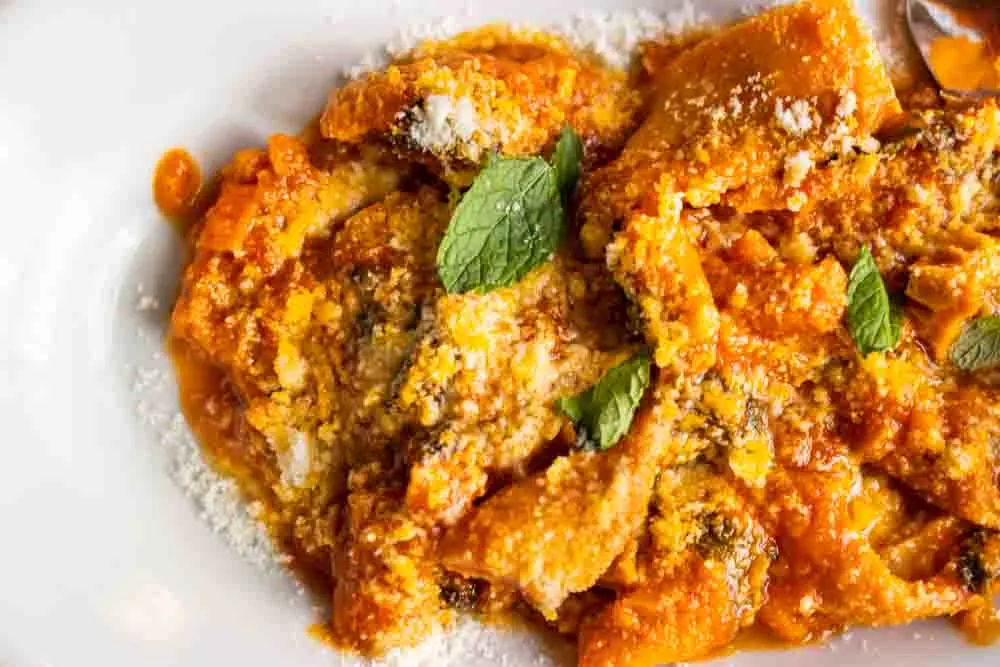
Tripa alla Romana is a dish of poverty that peasants ate back in the day when they couldn’t afford better cuts of meat. To compensate for the tripe’s chewy texture, they cooked the offal low and slow in a tangy tomato sauce laden with onion, garlic and the occasional red pepper flake.
Grated cheese completes Trippa alla Romana. Since it’s a Roman dish, the general cheese of choice is Pecorino Romano.
52. Pollo al Mattone
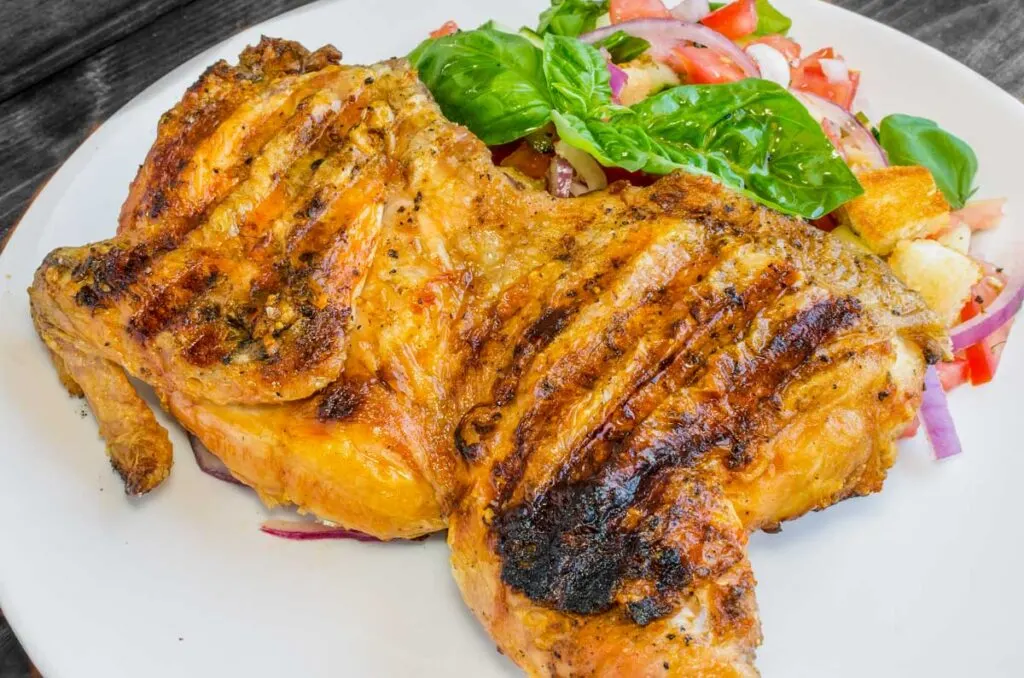
Trust Italian cooks to take the concept of roasting chicken to new heights with, of all things, a brick. Yes, a brick.
Tuscan cooks came up with the idea of cooking chicken ‘evenly’ under the weight of a brick in Impuneta, a town known for the production of bricks and terracotta. Although the technique sounds gimmicky, it works.
The weight of the brick flattens the chicken and allows it to cook like a dream. The resulting juicy, crispy clucker makes us wonder why more cooks don’t use bricks when roasting chickens.
53. Canederli
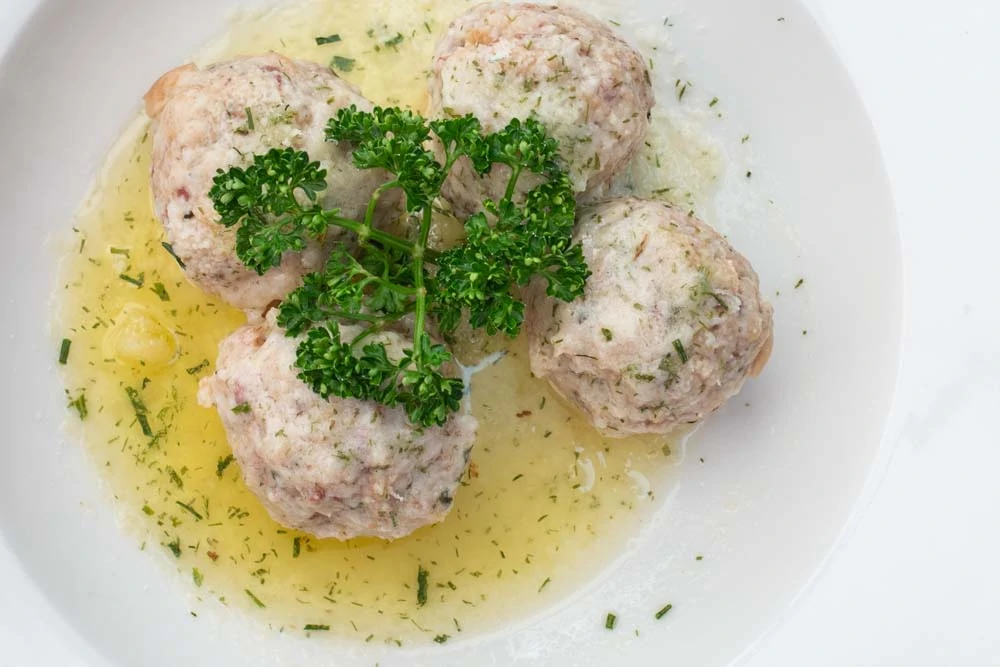
Canederli are Northern Italy’s version of Austria’s Knödel which isn’t so different from Germany’s Semmelknödel. While all of these dishes are bread dumplings, Canederli stands apart thanks to ingredients like sausage, cheese and speck. Plus, Canederli are served on top of either melted butter or brodo (i.e. broth).
Unlike many Italian dishes which are ubiquitous throughout the country regardless of where they originated, Canederli are specific to Trentino-Alto Adige. This regionality makes sense considering that it’s is closer to the Austrian border than it is to Rome.
Great Italian Foods
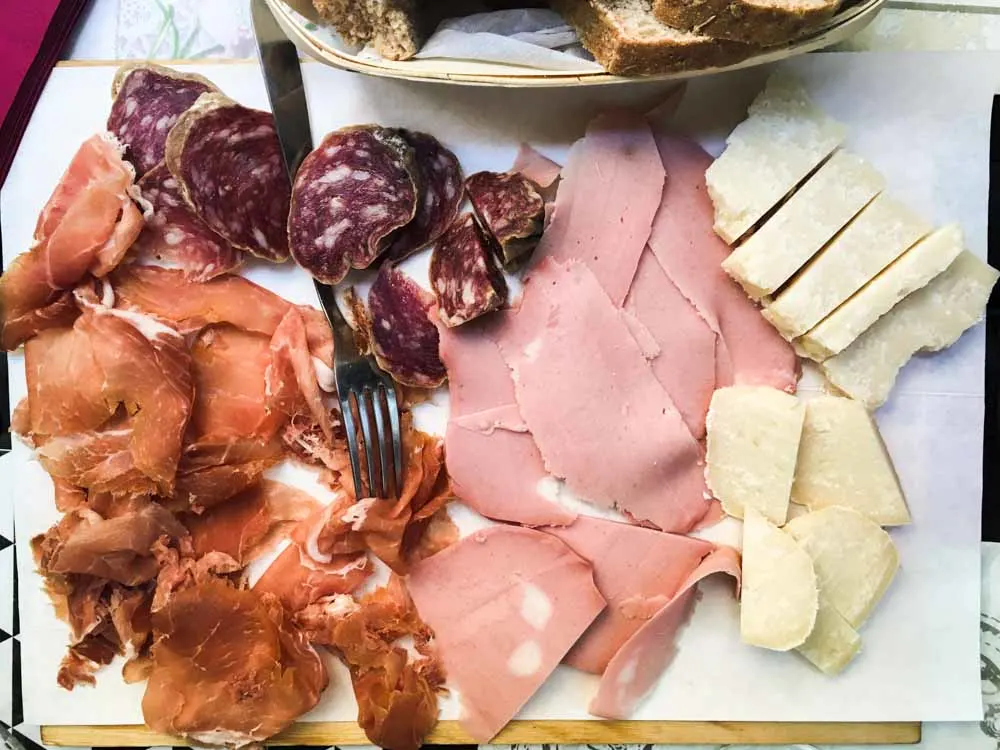
Traveling to Italy specifically to eat the country’s food is so wrong that it’s right. We’ve done it before and we’ll do it again but not for fancy Italian meals.
We’ve eaten at multiple Michelin starred restaurants in Italy and they were awesome. But it’s Italy’s local products that speak to us in our dreams and keep calling us back. These are the foods in Italy that speak the loudest:
54. Cheese (Formaggio)
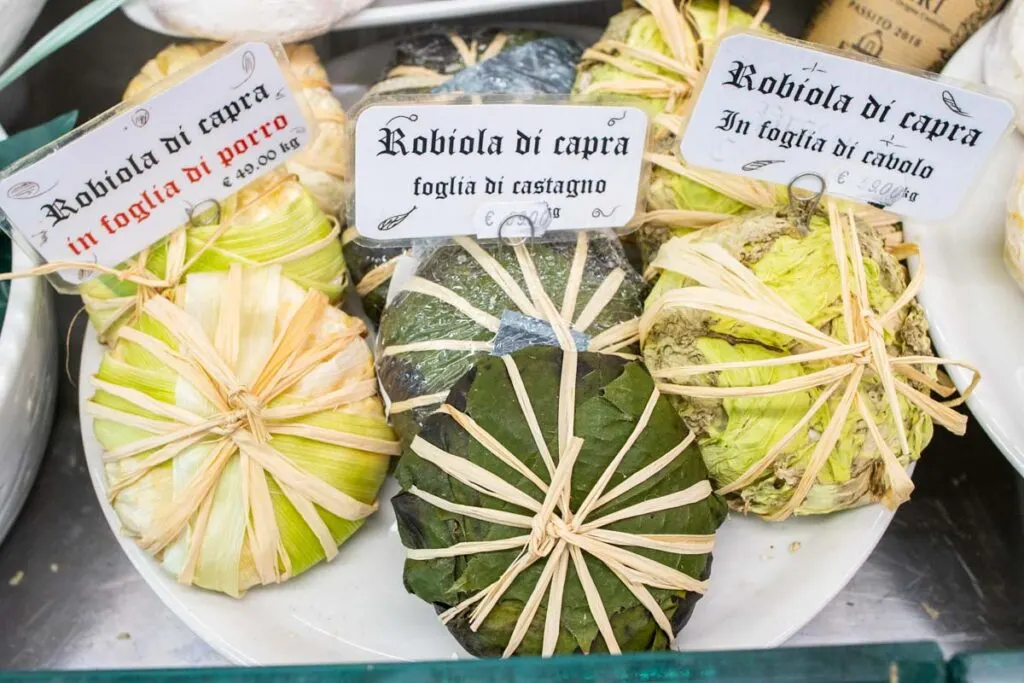
Parmigano-Reggiano might be the king of Italian cheese but it’s not the only formaggio worth eating in Italy. It’s not even the only cheese worth eating in Emilia-Romagna where Parmigano-Reggiano is exclusively produced with cow’s milk, salt and rennet.

Italy’s cheese roster is formidable. We feel fortuitous every time we bite into Mozzarella di Bufala produced in Campania or Pecorino produced in Tuscany. But sometimes it’s the less famous Italian cheeses like creamy
Robiola that steal our hearts.
55. Tomatoes (Pomodori)
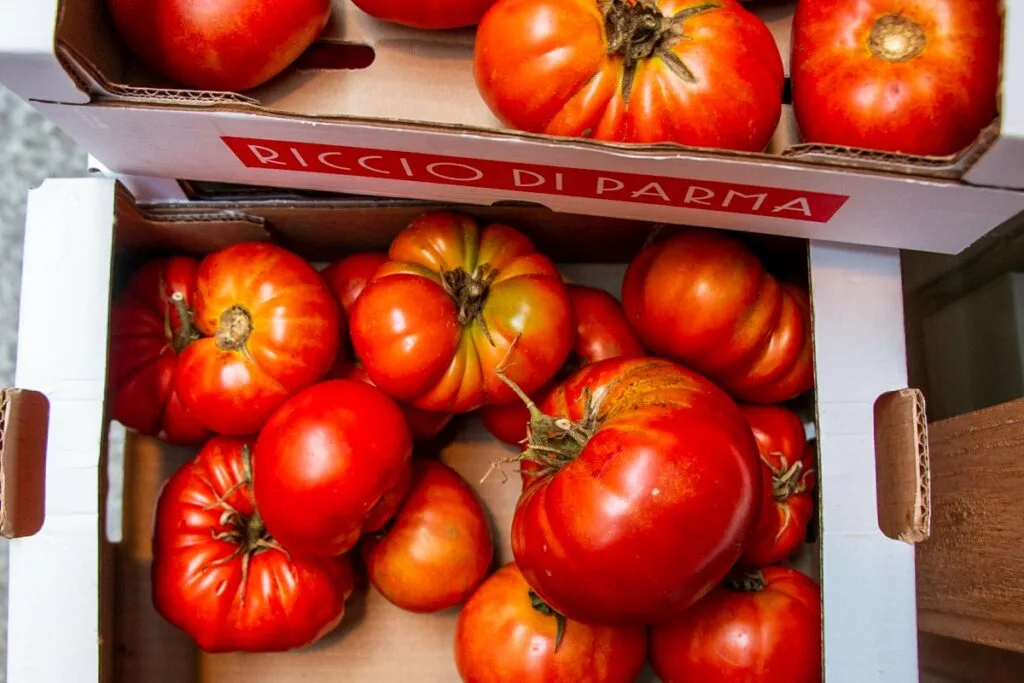
You don’t have to look hard to find tomatoes in Italy. Restaurants and pizzerias use tomatoes in many of the country’s most popular dishes and Italian vendors sell them at markets in a range of colors and sizes.
In Naples, cans of San Marzano tomatoes line supermarket shelves next to multiple brands of jarred tomato passata. The tomato may have only appeared on Italian tables a couple hundred years ago but it didn’t take long for the nightshade to become one of the most popular foods in Italy.
Discover more great food in Naples.
56. Truffles (Tartufi)
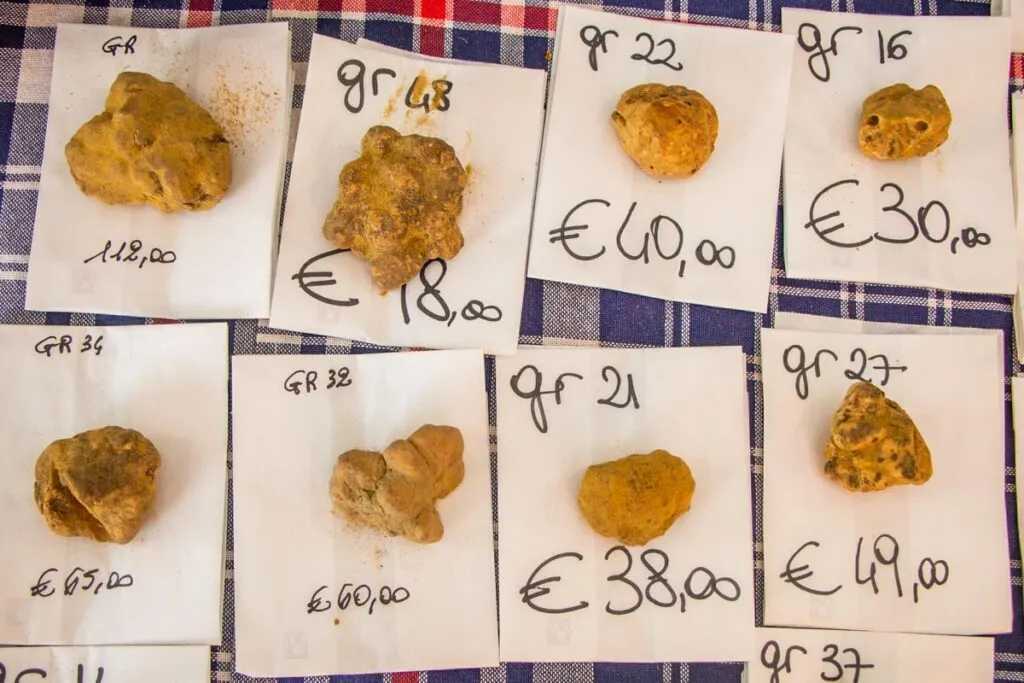
You can find black and white truffles all over the North of Italy. The most famous are from Alba in Piemonte though we hunted for truffles in the Bologna province before eating them at a local festival in Savigno. Closer to Florence, hunters forage for truffles in Tuscan towns like San Giovanni d’Asso and San Miniato.
We get that not everybody loves the earthy fungus. We also get that not everybody can afford its luxury price tag. But those who do won’t want to miss indulging in the fungus during any autumnal trip to Italy.
57. Porcini Mushrooms (Funghi Porcini)
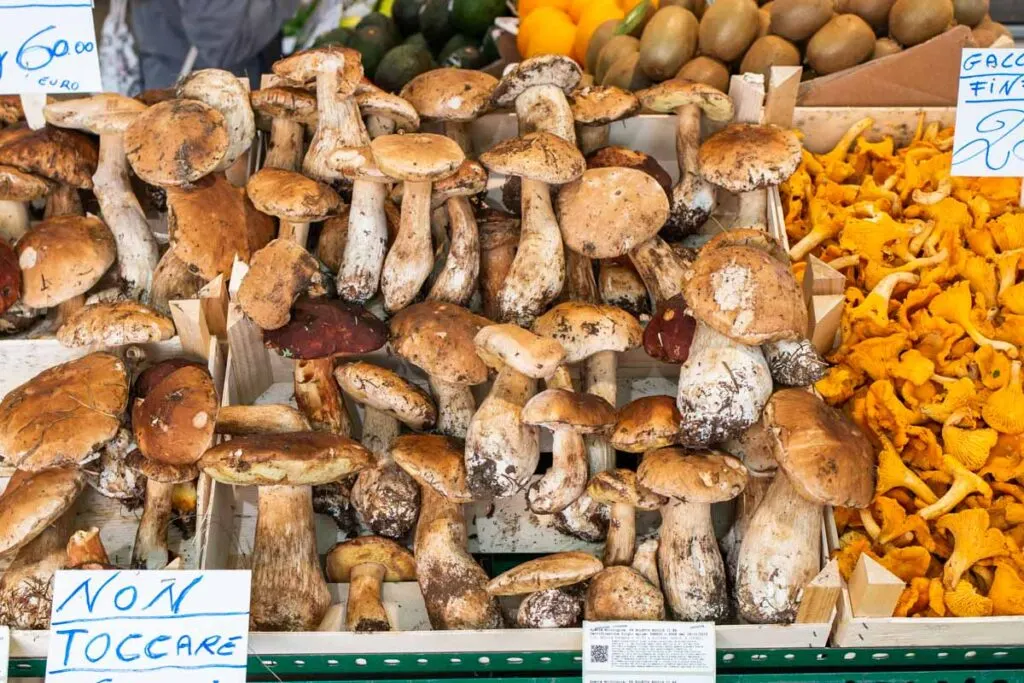
We’re wild about wild porcini mushroom in Italy. They’re meaty and nutty with a distinct umami flavor that you either love or hate. We’re clearly in the first category.
While we grew up eating dried porcinis in America, tasting fresh ones foraged from Italian forests was such a thrill that we’ve since planned more Italy trips during the autumn months. Our main motivations were actually avoiding hot weather and annoying crowds; however, eating fresh porcini mushrooms was a bonus.
Shopping for porcinis at Italian markets like Mercato Albinelli in Modena is an excellent activity for those with access to a kitchen. But hotel dwellers have plenty of options. The obvious one is to order a dish featuring the fungus at local restaurants. Another is to purchase porcini-infused olive oil to take home as an edible souvenir.
58. Balsamic di Modena

If you think that you know traditional balsamic vinegar based on the balsamic vinegar that you’ve purchased at the grocery store – think again.
Genuine Balsamic di Modena is a Denominazione di Origine Protetta (DOP) product that can only be produced in Emilia-Romagna. And, unlike the grocery store version made with vinegar, sugar and additives, traditional balsamic vinegar has just one ingredient – grape juice.
As we’ve learned during three different tours, Italian artisans transform grape juice into Balsamic di Modena via a multi-year process that takes at least 12 years but preferably much longer. This process involves fermentation, barrel aging and patience.
59. Cured Meat (Salumi)
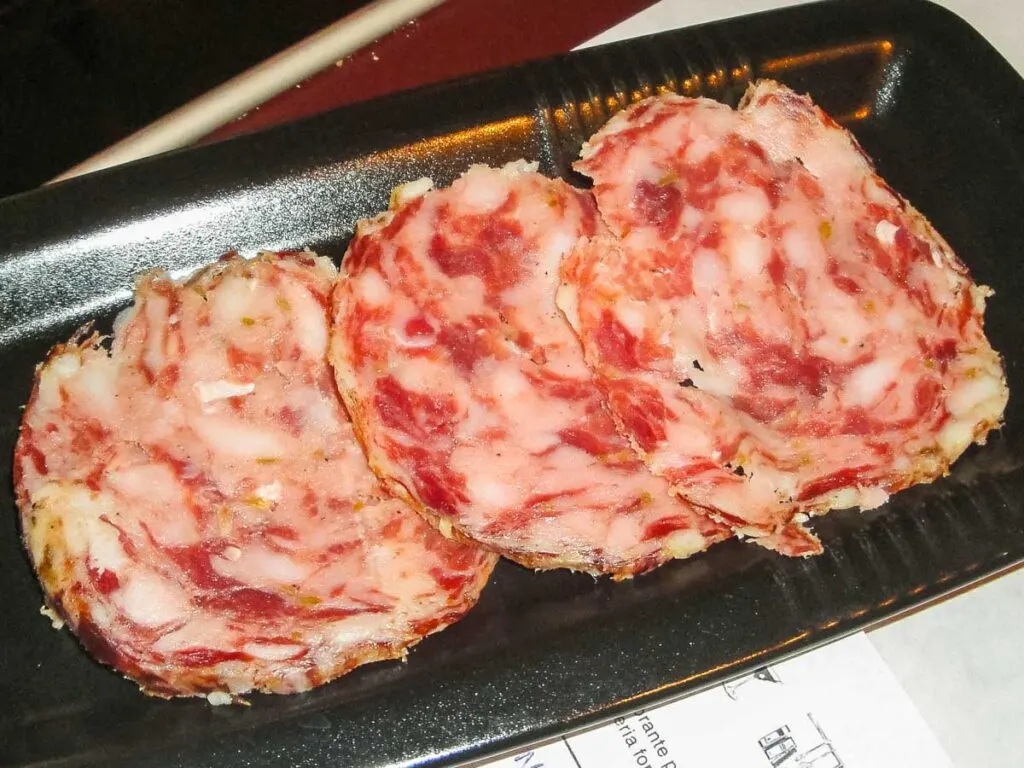
Salumi, not to be confused with salami, is a broad category of Italian cured meats. To be clear, salumi is a type of salumi but it’s one of dozens, if not hundreds, of salumi options in Italy.
Each Italian region has salumi specialties whether it’s mortadella and prosciutto in Emilia Romagna or guanciale in Lazio. Then there’s speck in Trentino and nduja in Calabria.
Italy’s salumi options are practically endless and can be easily enjoyed when you order a tagliere (i.e. chopping board) topped with salumi during an Italian aperitivo session. It’s the best way to find your favorite salumi as well as a tasty way to celebrate the end of the day.
60. Bottarga
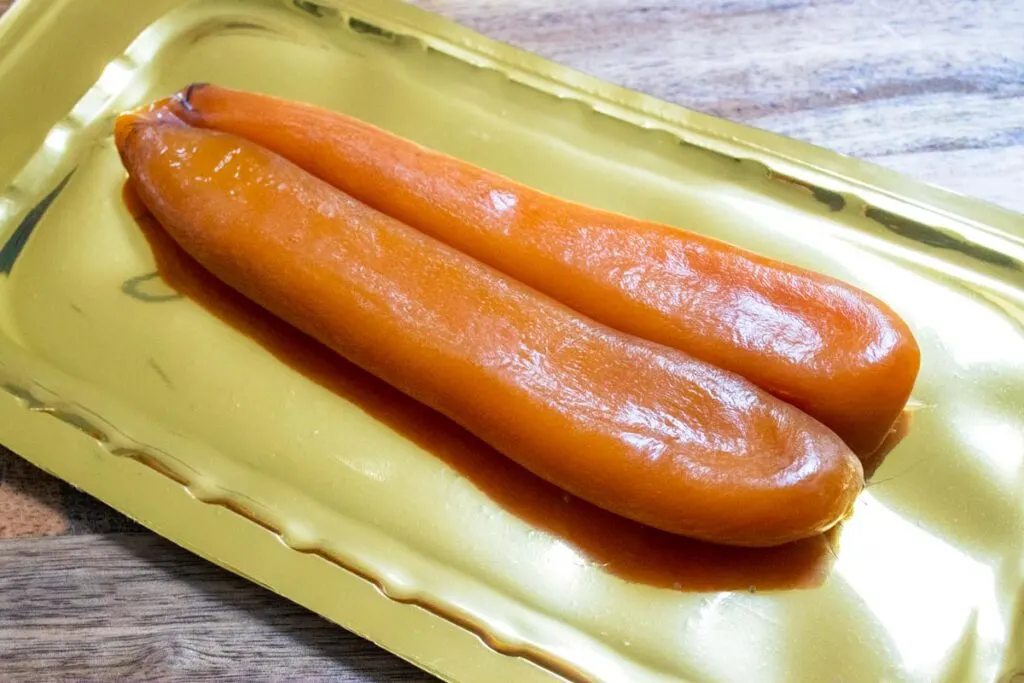
The history of bottarga, fish roe sacks that are pressed, salted and preserved, traces back thousands of years all the way to the ancient Egyptians. But that’s the only history worth noting – the practice of preserving fish roe goes beyond Italy and spreads all the way to Asia.
Often, In Italian cooking, cooks grate bottarga over spaghetti or other pasta that’s been prepared aglio e olio (with olive oil and garlic). Since Italians like to keep seafood and cheese separate, they sometimes use bottarga as a Parmigiano substitute, grating it on pasta to provide a salty/umami flavored punch.
Follow our Spaghetti alla Bottarga recipe and cook the surprisingly creamy pasta dish at home.
61. Friarelli
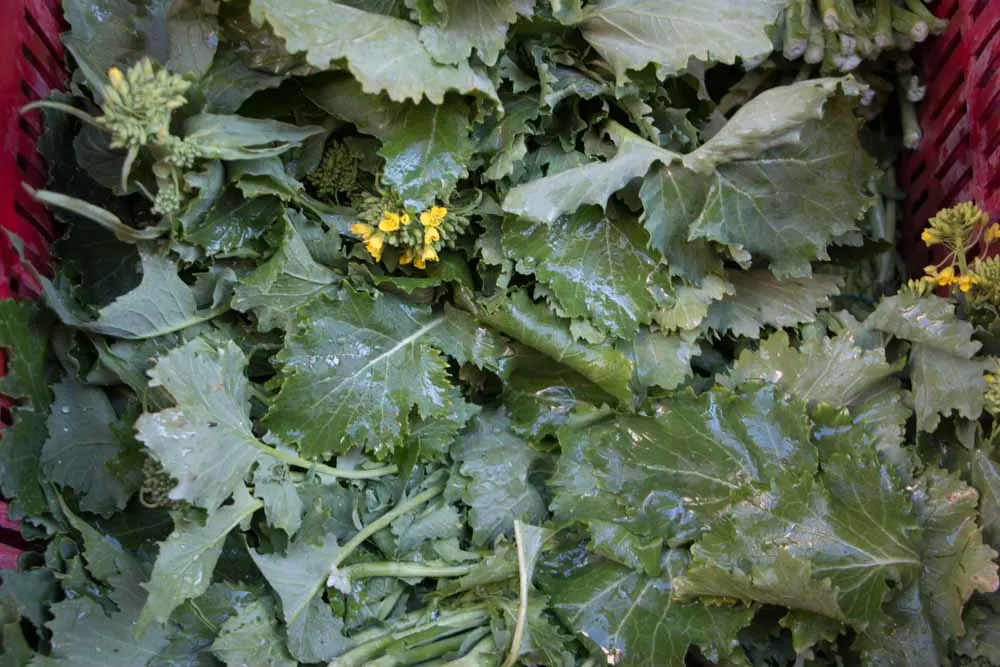
Known as Broccoletti in Rome and Broccoli Rabe in American cities like Philadelphia, Friarelli is a leafy green vegetable in Naples that’s often sautéed with olive oil and garlic and served as a side dish. Friarelli is especially popular during the cooler months of the year.
Unlike sweet figs and tomatoes grown in Campania, Friarelli has a bitter flavor. When we’re at home, we like to pair sautéed Friarelli with garlic and Italian sausage.
62. Radicchio
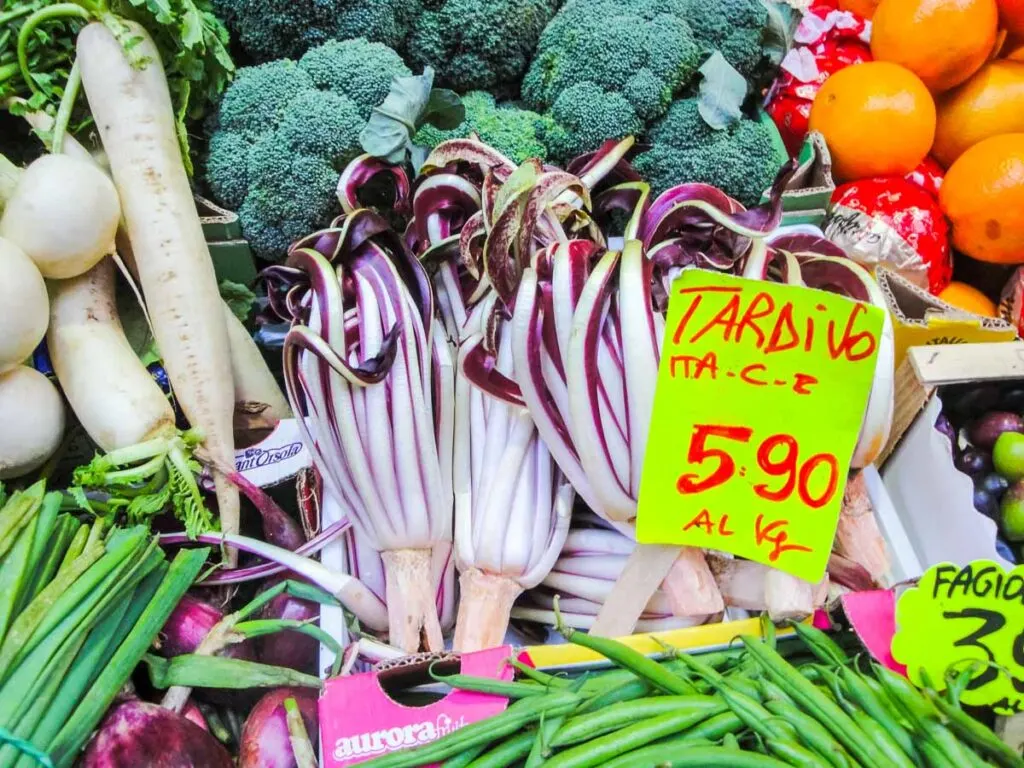
Italians have been eating radicchio since the 15th century. But not just any radicchio. Northern Italian farmers cultivate different radicchios including Treviso, Tardivo, Chioggia and Castelfranco varietals.
Finding different radicchio varieties at markets in cities like Florence, Venice and Trento is easy to do since the lettuce hybrid is ubiquitous in Northern Italy. If you’re worried that it’s too bitter, grilling or roasting radicchio will soften the flavor.
63. Squash Blossoms (Fiori di Zucca)
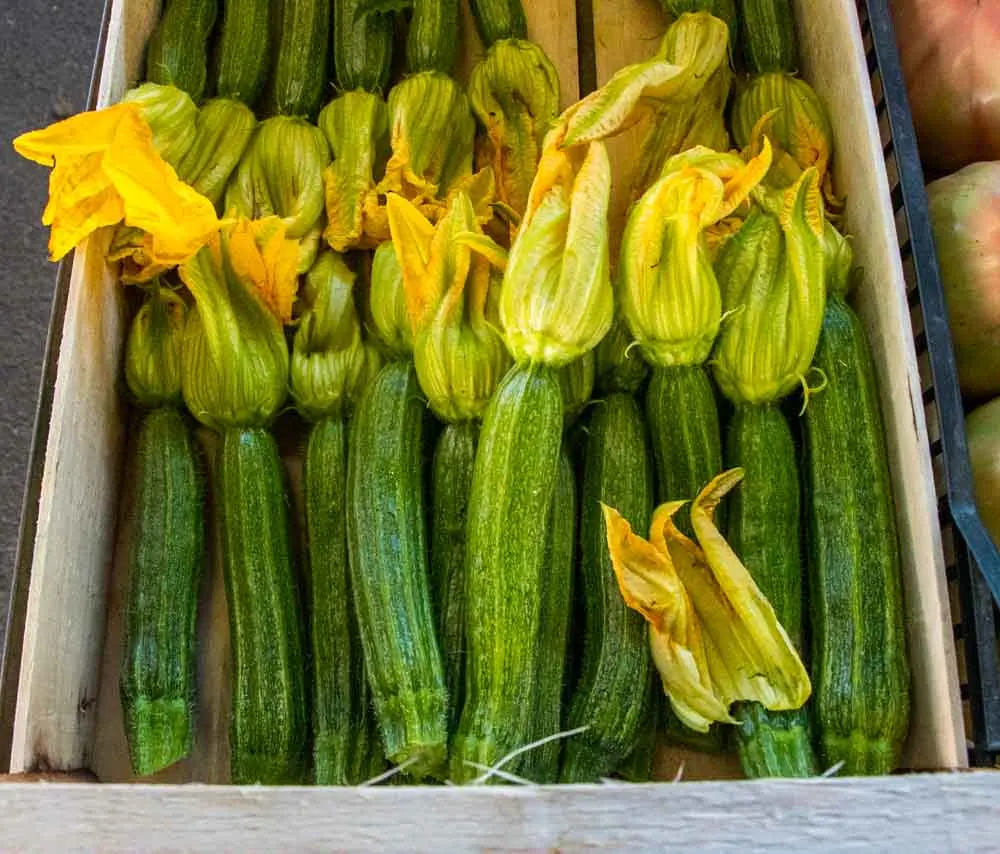
We’ve already told you to order Fiori di Zucca Fritti (i.e. fried squash blossoms) if you see the crispy treat on a Roman menu. But what are squash blossoms?
Also called zucchini flowers, yellow squash blossoms are edible flowers that grow on the squash plant. Italians fry them and top them over pizza. As for us, we follow our own instructions and eat them when we see them on a menu or on top of a pizza.
64. Pumpkins (Zucca)
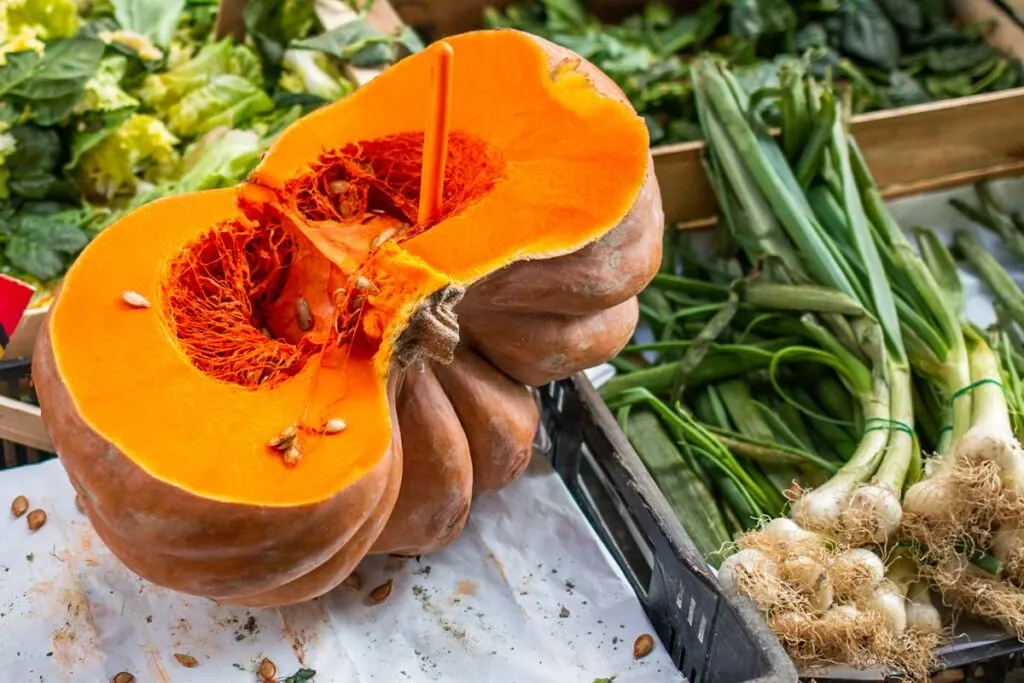
Italian chefs call pumpkins zucca and add the autumnal favorite to both savory vegetarian meals and sweet desserts after buying them at local markets. They’re one of the most versatile fruits in Italian cuisine. Yes, they’re a fruit.
While pumpkin ravioli (i.e. Tortelli di zucca) with sage brown butter may be Italy’s most famous zucca recipe and the dish we’ve eaten most frequently, we’ve also eaten pumpkin flan at Osteria La Zucca in Venice. Other Italian pumplin applications include soups, risotto and cheesecake.
Discover more great food in Venice.
65. Pesto alla Genovese
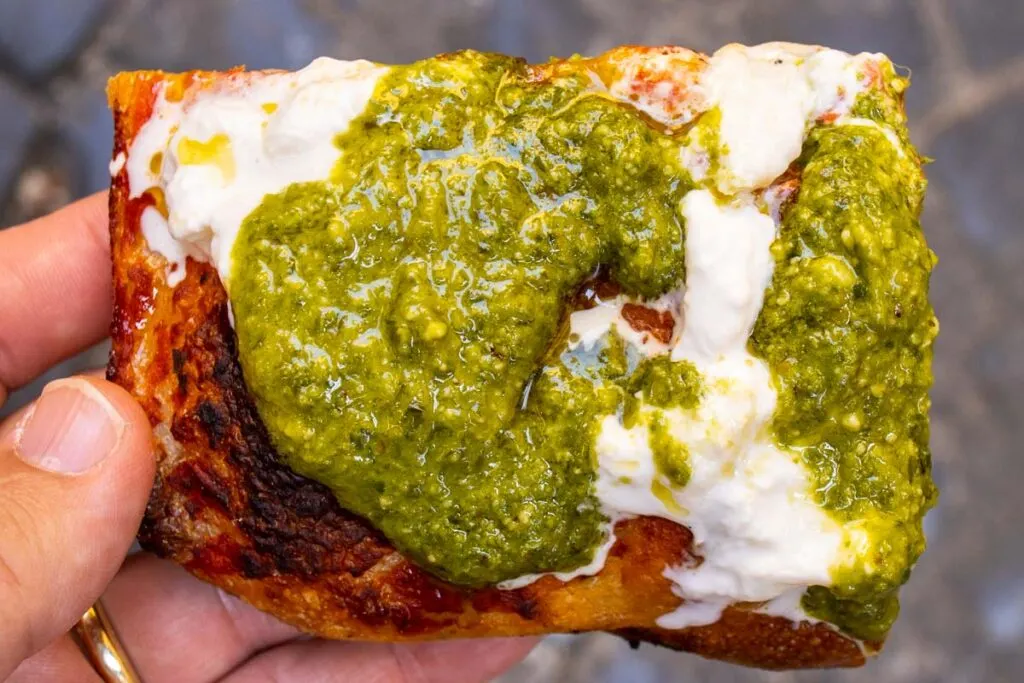
Pesto alla Genovese isn’t just green like a summer valley. It’s also the Italian pesto that’s made its way around the world and back to Liguria where it was first eaten.
Made with five wholesome Italian ingredients – fresh basil, pine nuts, garlic, extra virgin olive oil and Parmigiano-Reggiano cheese, Pesto alla Genovese is hard to resist whether it’s made in a modern food processor or with a traditional mortar and pestle. We say do it the traditional way. This great pesto is worth the effort.
66. Taralli
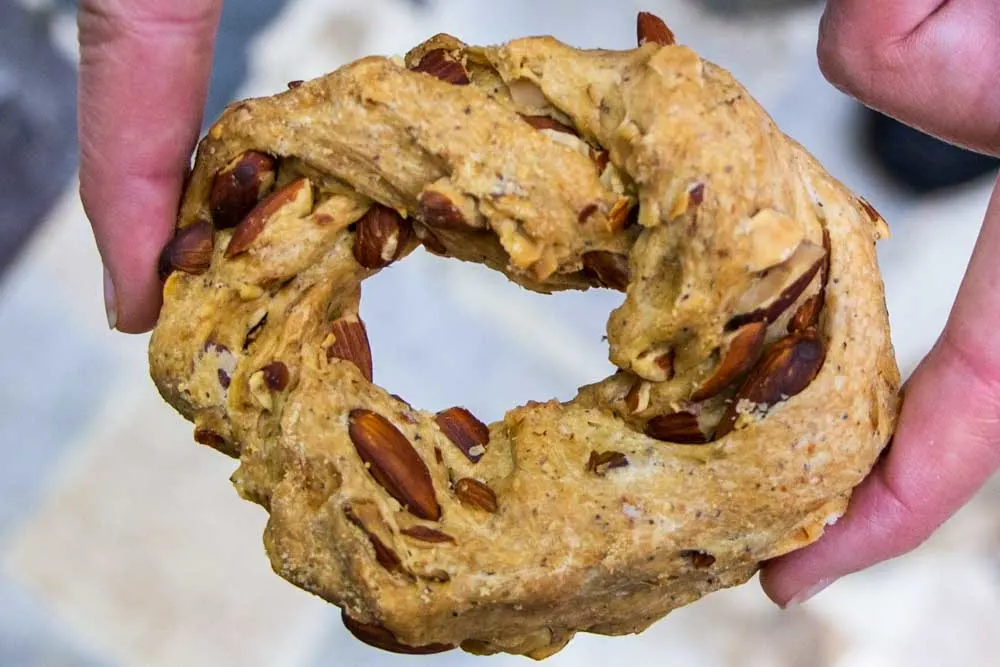
Available in both sweet and savory versions, the taralli is a classic Neapolitan snack food sold at bakeries throughout the Southern Italian city. Locals also buy bags of the ring-shaped delicacy at local grocery stores and markets.
We first ate savory taralli made with lard and almonds during a Naples food tour and later bought a small version called tarallini at a neighborhood supermarket near our apartment. As we quickly discovered, the Italian snack food item pairs well with cured meat and cheese (see both above).
Italian Desserts (Dolci)
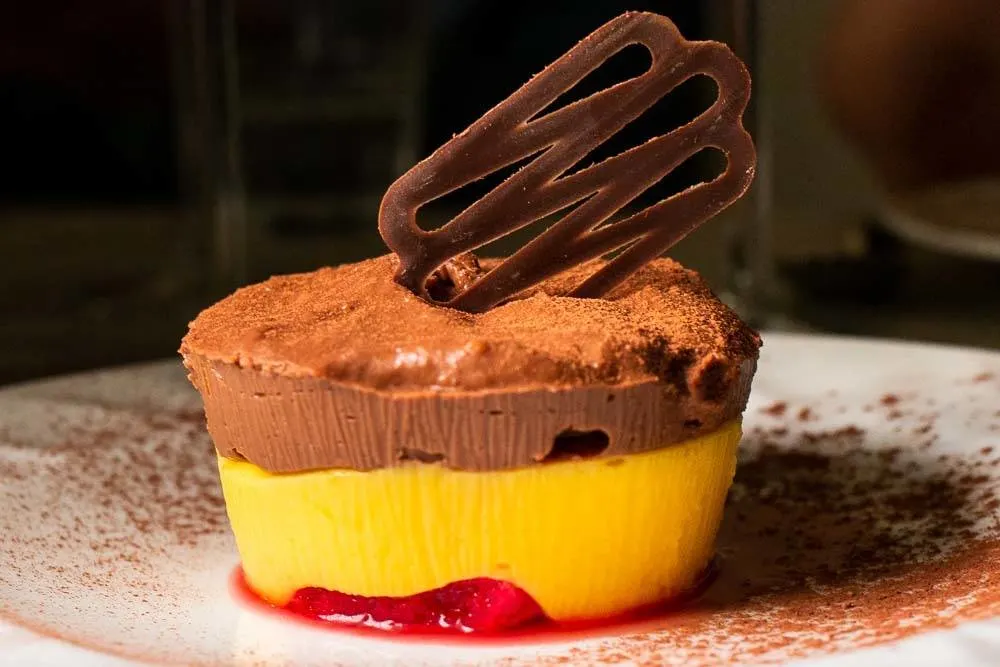
It’s almost not fair that Italy’s desserts rival its savory dishes in terms of both culinary excellence and global popularity. We might be resentful of the situation if we couldn’t find Italian desserts like gelato and cannoli around the world and in our adopted home city of Lisbon.
That being said, it’s preferable to eat Italian desserts in the country where they were originally created. Read on to discover the desserts (dolci in Italian) that you don’t want to skip when you visit Italy:
67. Gelato
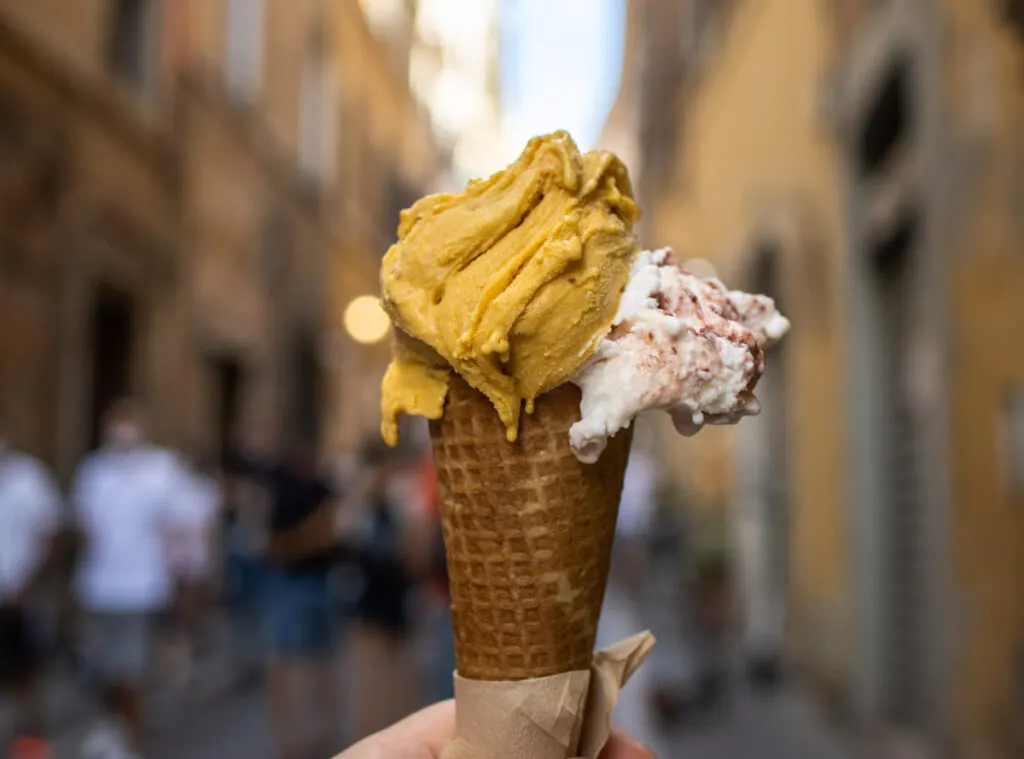
Not only is Gelato one of the most popular Italian desserts, but it’s also proof that desserts don’t need flour or eggs to taste divine. Italy’s version of ice cream accomplishes this feat with milk, cream, sugar and a range of fresh fruits and nuts.
68. Panna Cotta
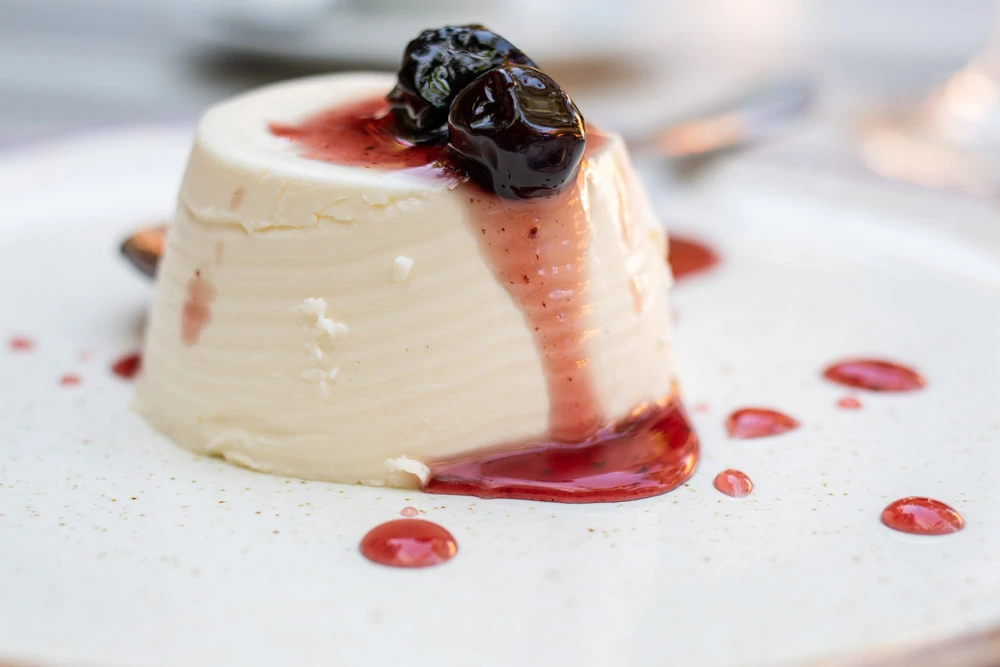
Though its history isn’t certain, Panna Cotta was most likely created in Italy’s Piedmont region as recently as the 1960s but it may have appeared as far back as the 19th century. Still popular all over the Italian peninsula, it’s a fairly unique dessert that manages to be creamy without being runny.
Regardless of when and where the iconic creamy dessert was invented, there’s something utterly modern about a great Panna Cotta. The dessert derives its ‘spoonability’ from the addition of gelatin and it’s typically served in a flat dome shape though we’ve also eaten traditional Panna Cotta in a pudding glass.
Flavoring Panna Cotta is an open book but, generally, fruits like berries and citrus flavor the creamy mixture. We’ve enjoyed eating the dessert at locations around the world – Bologna, Philadelphia and Rhodes just to name a few cities.
69. Cannoli

To make Cannoli, Sicilian bakers stuff cylinder shaped fried dough with ricotta cream and occasionally sprinkle chocolate, nuts and candied fruit on the edges. The resulting pastry is simultaneously crunchy, sweet and utterly addictive.
Generations of bakers have prepared Cannoli in Sicily going back to the days of Arab rule more than a millennium ago. Some brought the recipe across the ocean when they emigrated to America. Thanks to them, Cannoli are readily available at Italian bakeries in cities like Boston, Philadelphia, New York and New Orleans.
70. Cassata

The Cassata hasn’t lasted for a thousand years, give or take, by accident.
Similar to Sicily’s Cannoli, Cassata ingredients include ricotta cheese and candied fruit. But this Italian ricotta cake goes further with the addition of liqueur-soaked sponge cake, marzipan and icing. It’s also a tasty Gelato flavor that we order whenever we see it on a menu.
71. Sfogliatella
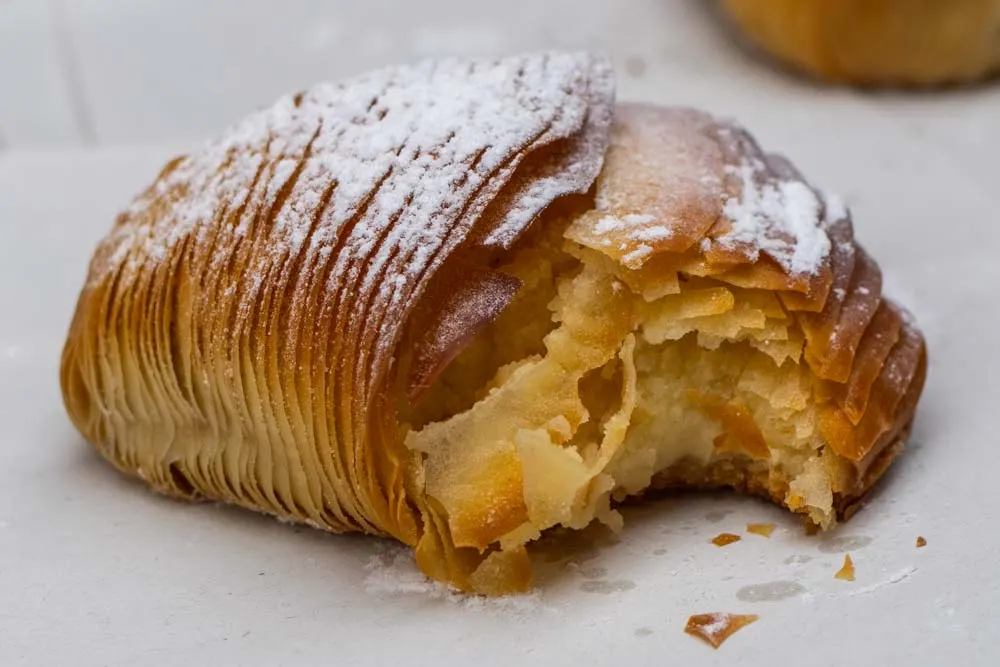
The Sfogligatella has been a popular Neapolitan dessert since the 17th century. But what is a Sfogliatella?
For the uninitiated, the Sfogliatella is an addictively tasty layered, shell shaped pastry that comes in two main styles – Riccia and Frolla. Order a Sfogliatella Riccia if you prefer eating a flaky, layered pastry or a Sfogliatella Frolla if you’re partial to a shortcrust pastry shell.
Stuffed with special ricotta cream that’s never too sweet, the best sfogliatellas are freshly baked and hot out of the oven. Whichever version you choose, pair your Sfogliatella with coffee to create an ideal Naples breakfast.
72. Tiramisu
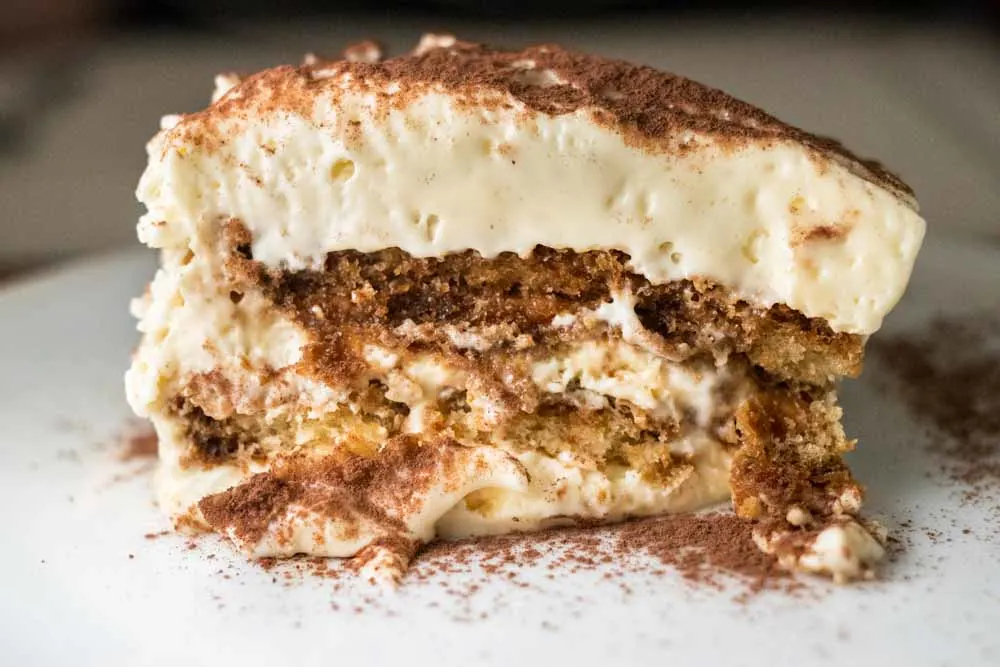
We’ve enjoyed so many versions of Italy’s layered, creamy, coffee-soaked and powdered Italian classic made with ladyfingers and mascarpone cream. Featured on menus all over the boot, this dessert has a dubious past that some culinary historians trace to the pleasure houses of Treviso. It was allegedly eaten by philandering men who needed a caffeine ‘pick me up’ in order to appear alert to their suspicious wives the next morning.
As with most edibles in Italy, despite the story above, Tiramisu’s origin isn’t clear. What is clear is that we’ve enjoyed excellent versions of traditional Tiramisu all over Northern Italy from Verona and Venice in the Veneto to Parma in Emilia-Romagna. Some were cake-like slices served on plates while others were puddings served in deep bowls. Regardless of the serving vessel, all versions of this classic Italian pudding/cake were moist, coffee-filled, ultra-creamy and rich.
Read our Traditional Italian Dessert Guide to discover more than two dozen sweet treats to try in Italy. Many of these desserts double as the best desserts in the world.
Italian Drinks
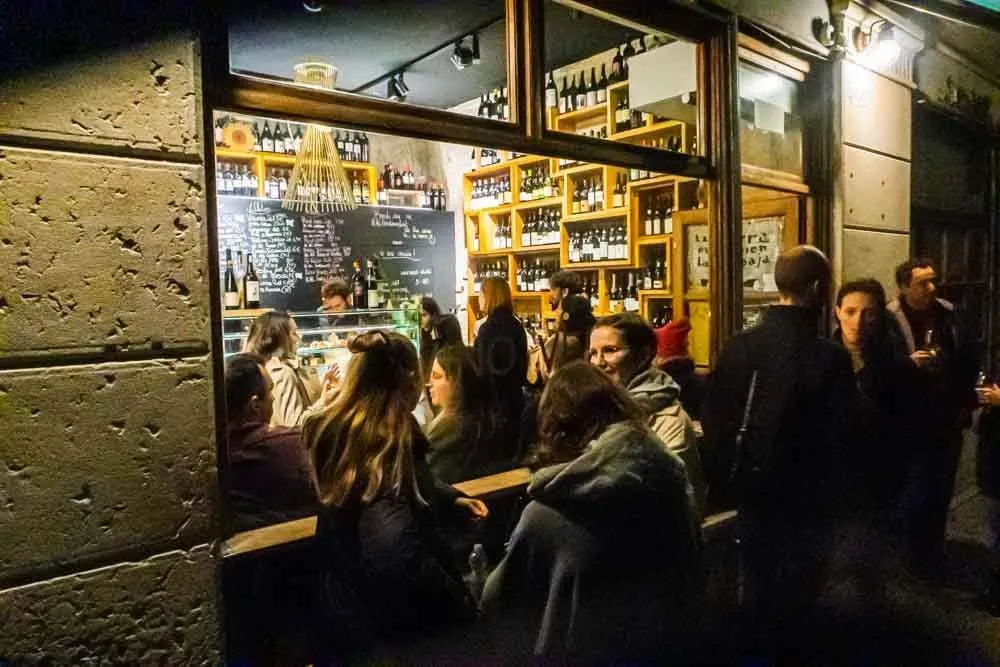
Drinking is an integral part of the Italian culture that transcends imbibing water merely to survive. When it comes to water, Italians enjoy drinking both naturale flat water and frizzante fizzy water. Then there’s leggiermente water which is fizzier than flat water and flatter than fizzy water.
Most Italians start their days by ordering coffee with their morning pastry before switching to wine and other libations as the day progresses. While some people order a Negroni or Spritz to go with their aperitivo, many stick to wine produced throughout Italy. And then there are Italian craft beers and digestifs which offer a different drinking experience.
As for us, these are the drinks we can’t live without when we’re in Italy as well as at home in Portugal:
73. Coffee
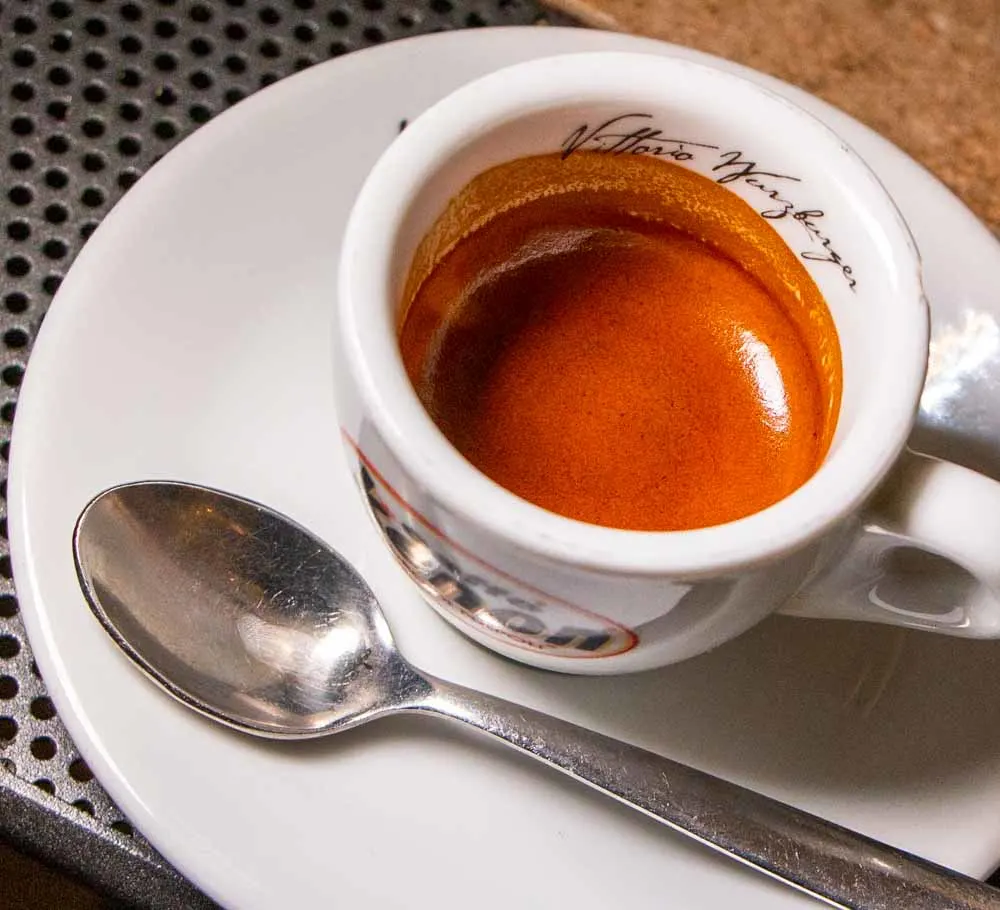
Italian coffee culture is legendary for its unwritten rules involving how and what to order. These rules even stipulate that it’s a no-no to order milky drinks like cappuccinos after 11 am. Whether or not you follow these rules is up to you.
As for us, drinking little cups of caffè (i.e. espresso) at traditional cafes isn’t really our thing. We prefer drinking flat whites and pour overs at specialty coffee shops. Don’t get us wrong – we’ll happily drink old school Italian espressos in a pinch.
Check out our coffee guides for Florence, Naples and Rome.
74. Wine
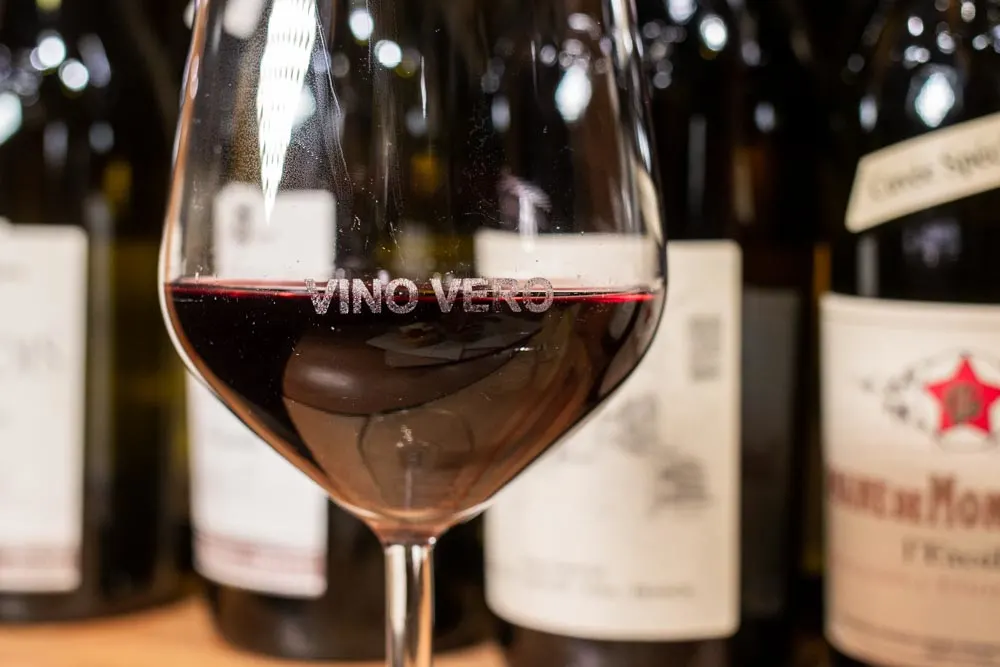
Drinking local wine is the way to go in Italy. Not only does this approach provide a window into each region’s wine scene, but it also provides us tremendous wine values.
A neighborhood enoteca is a great spot to drink wine with locals. Ordering house wine at restaurants is another great approach unless there’s a certain bottle or varietal you want to pair with your meal.
Discover why Alto Adige is Italy’s wine wonderland.
75. Cocktails

Italy has a long history with producing liquors and liqueurs like Amaretto, Aperol, Campari, Frangelico, Limoncello and Luxardo. Then there are amari like Averna, Montenegro and Fernet-Branca. It was a slippery slope before the country embraced cocktails and mixology.
While the Aperol Spritz and Negroni have achieved cocktail icon status, they’re just the tip of Italy’s cocktail iceberg. Other popular Italian cocktails include drinks like the Amaretto Sour, Hugo Spritz, Limoncello Spritz and Americano. The only way to find your personal favorite is to try them all.
Discover our favorite Italian cocktail recipes.
Useful Italy Facts

Frequently Asked Questions
Italy is famous for its pasta and pizza. However, the European country has as whole range of food, both savory and sweet, beyond pasta and pizza.
Traditional Italian food is the same as popular Italian food. The best Italian dishes involve bowls of comforting pasta and tasty pizza pies.
No. Service is typically included as Coperto.
Italy is a fantasy land for dessert eaters. Popular Italian sweet treats include tiramisu, cannoli and sfogliatella.
Popular Italian drinks include wine and coffee as as well as cocktails like the Aperol Spritz and Negroni.
Video Recap

About the Authors
Daryl and Mindi Hirsch
Saveur Magazine’s BEST TRAVEL BLOG award winners Daryl and Mindi Hirsch share their culinary travel experiences and recipes on the 2foodtrippers website. Since launching the site in 2012, they’ve traveled to over 40 countries in their quest to bring readers a unique taste of the world.
Original Publication Date: December 1, 2021

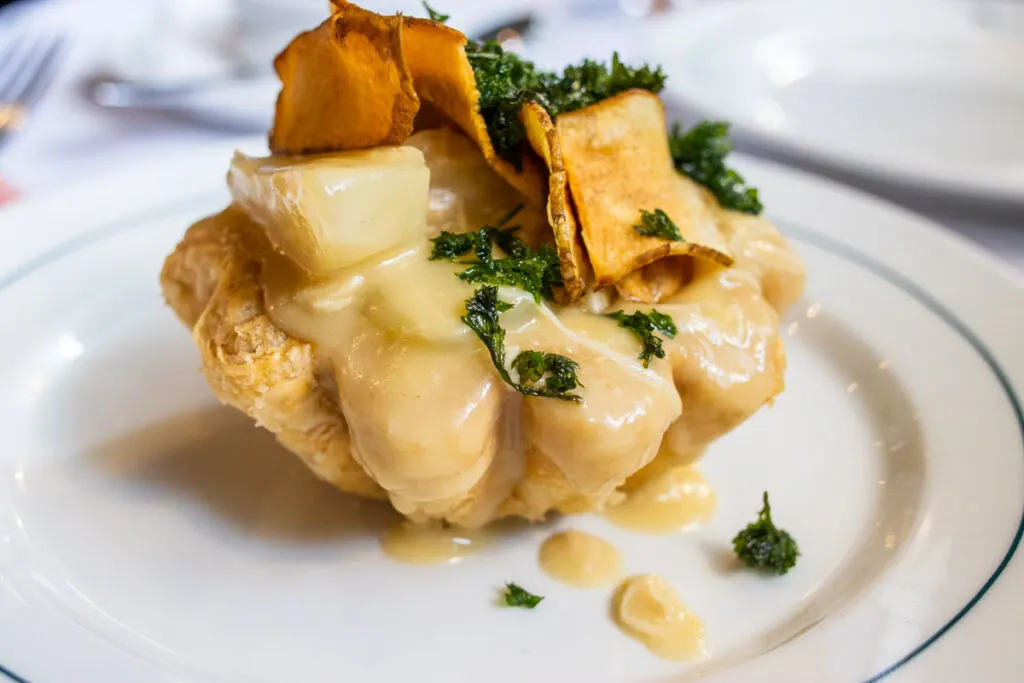
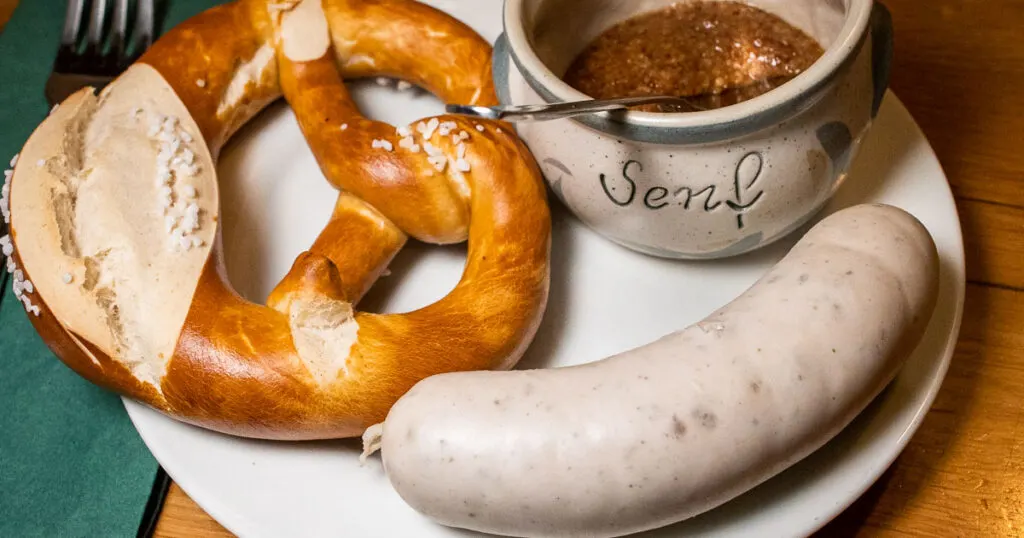
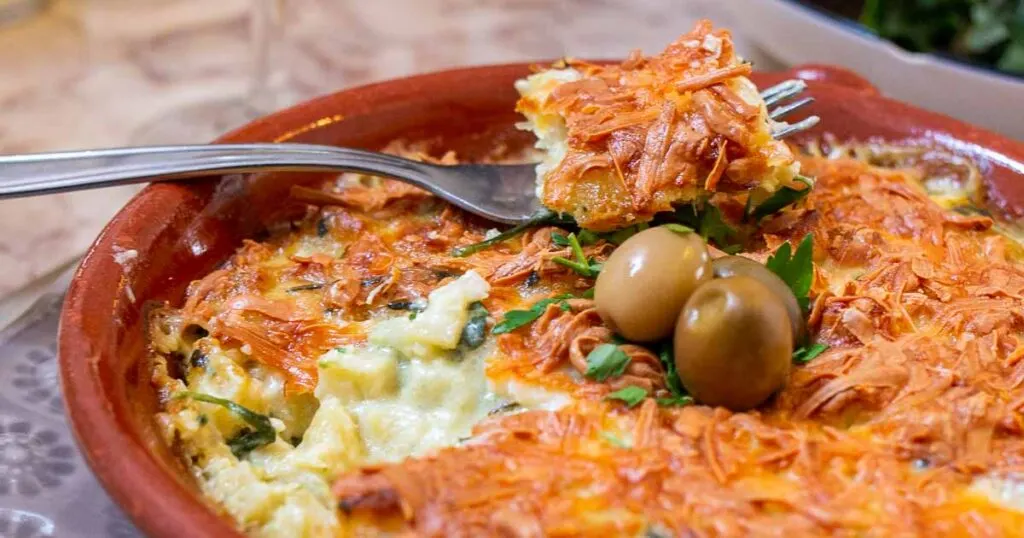
Raymond
Saturday 4th of February 2023
They should have listed the nutritional Value of these Italian foods.
Scott
Thursday 30th of March 2023
@Raymond, Why?